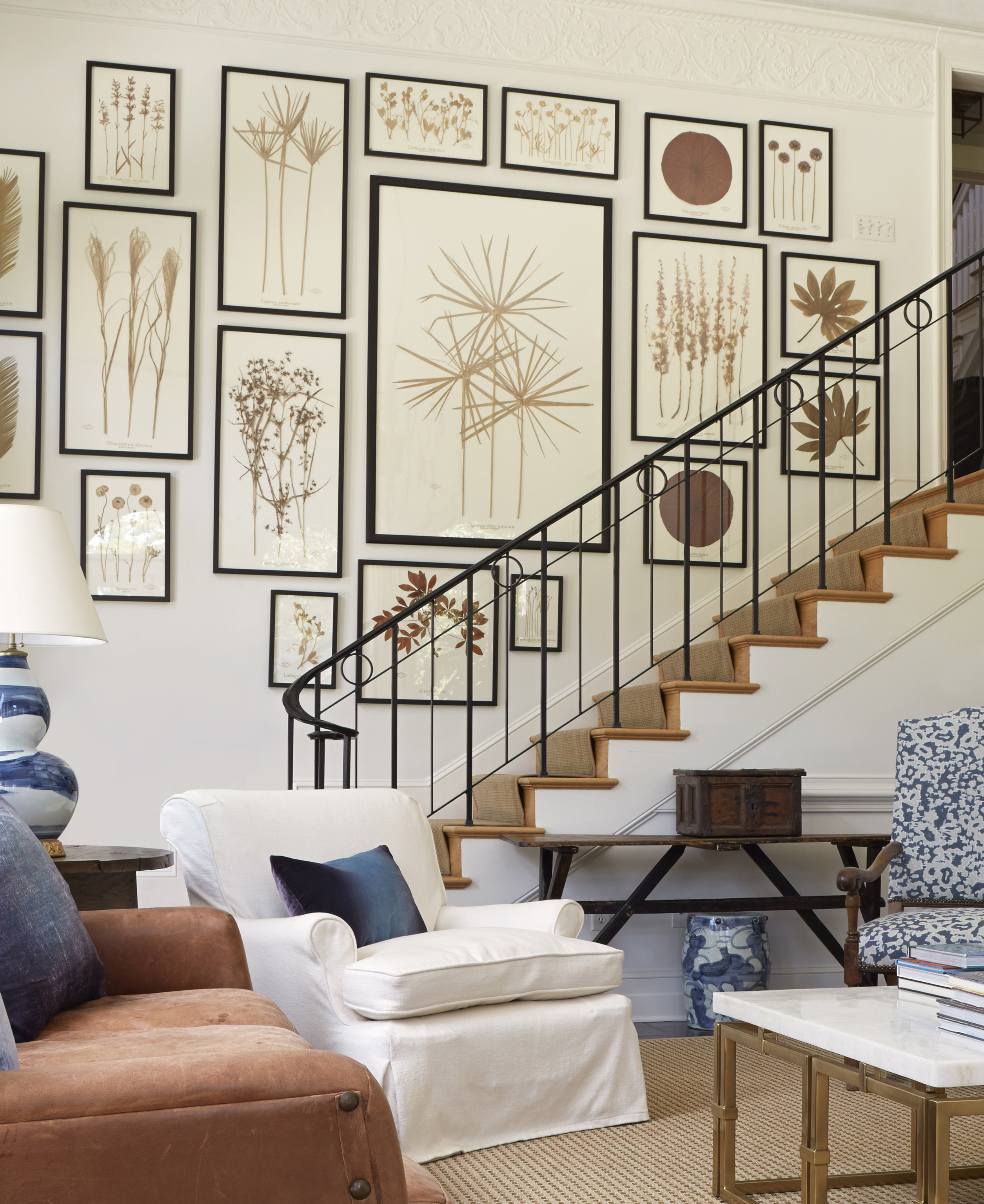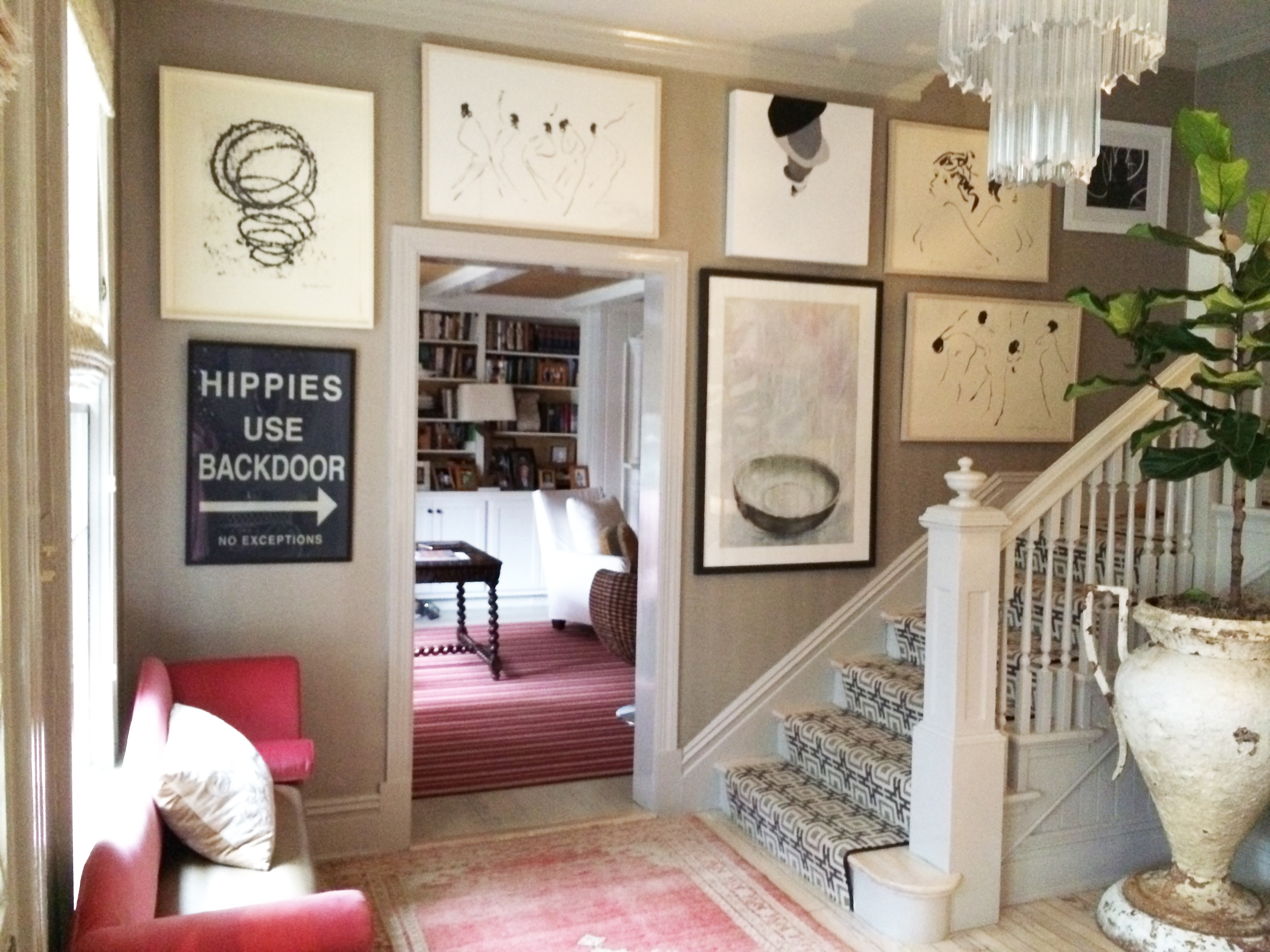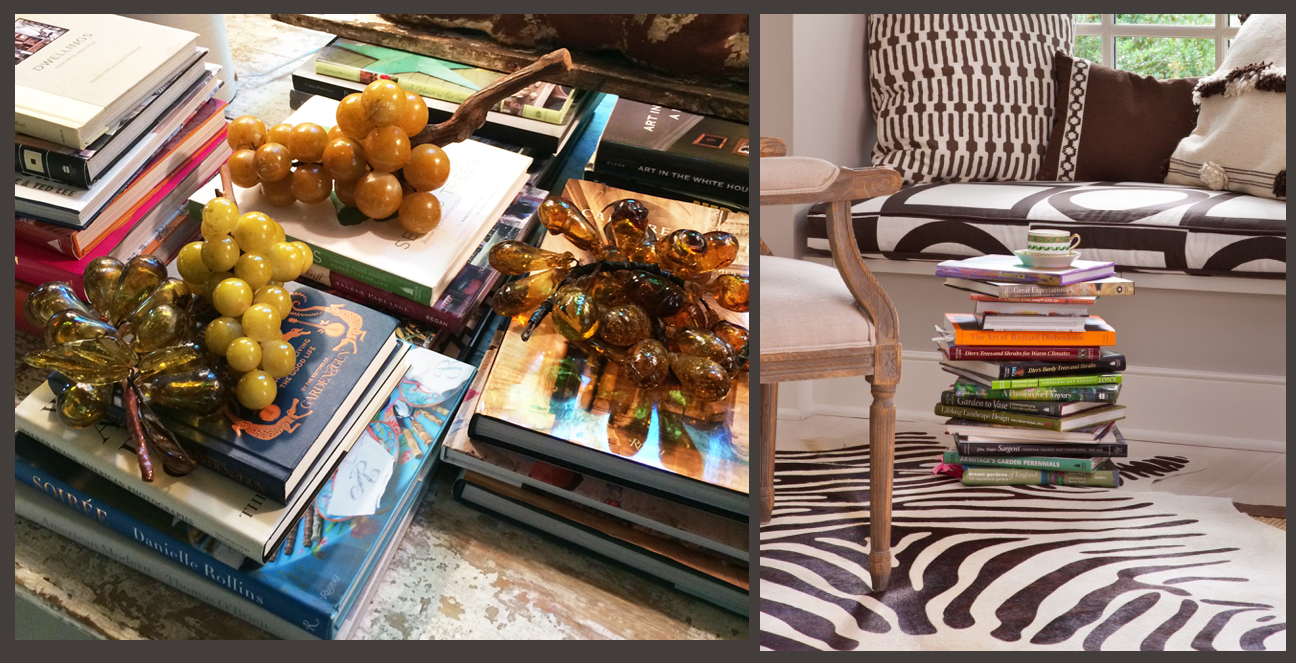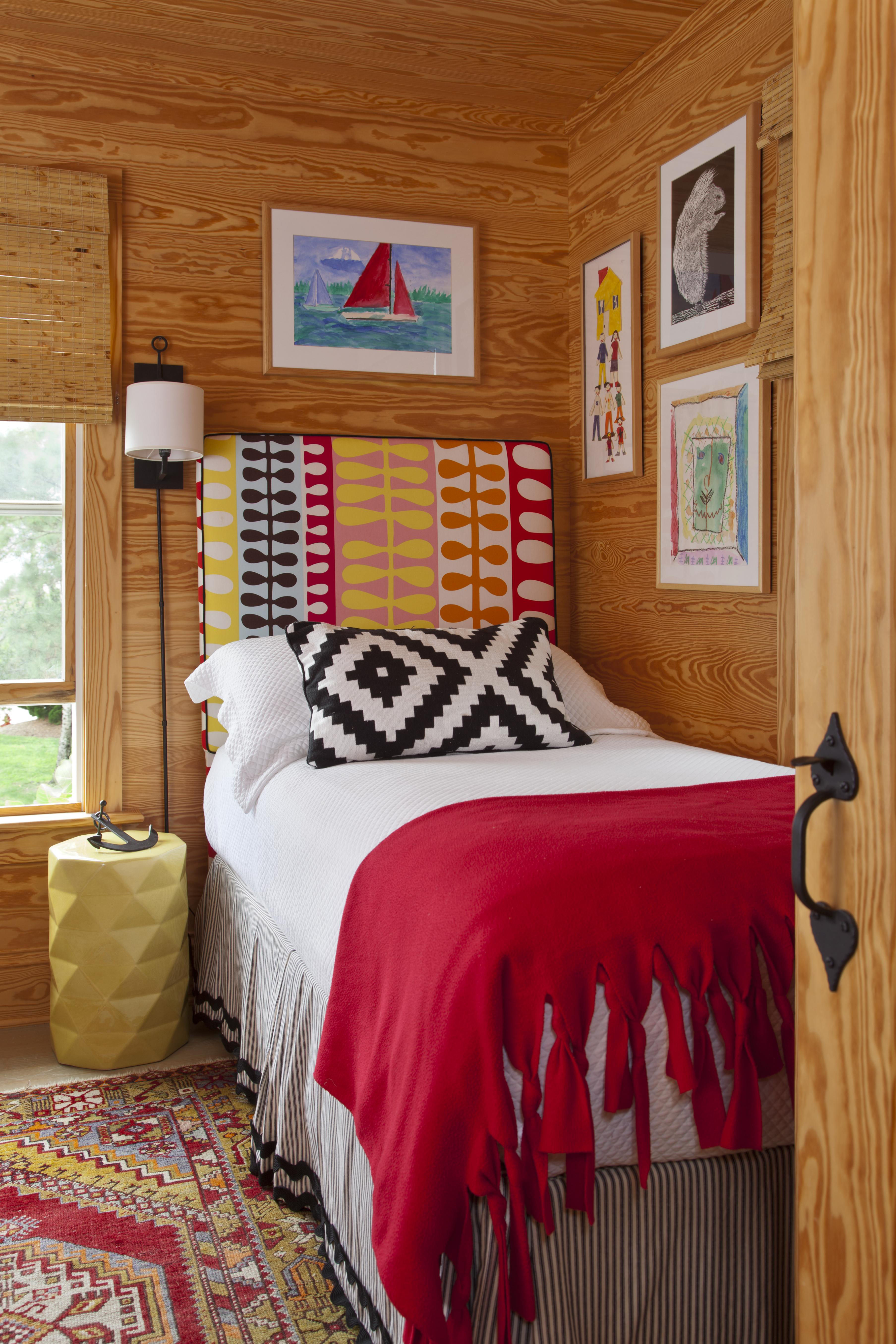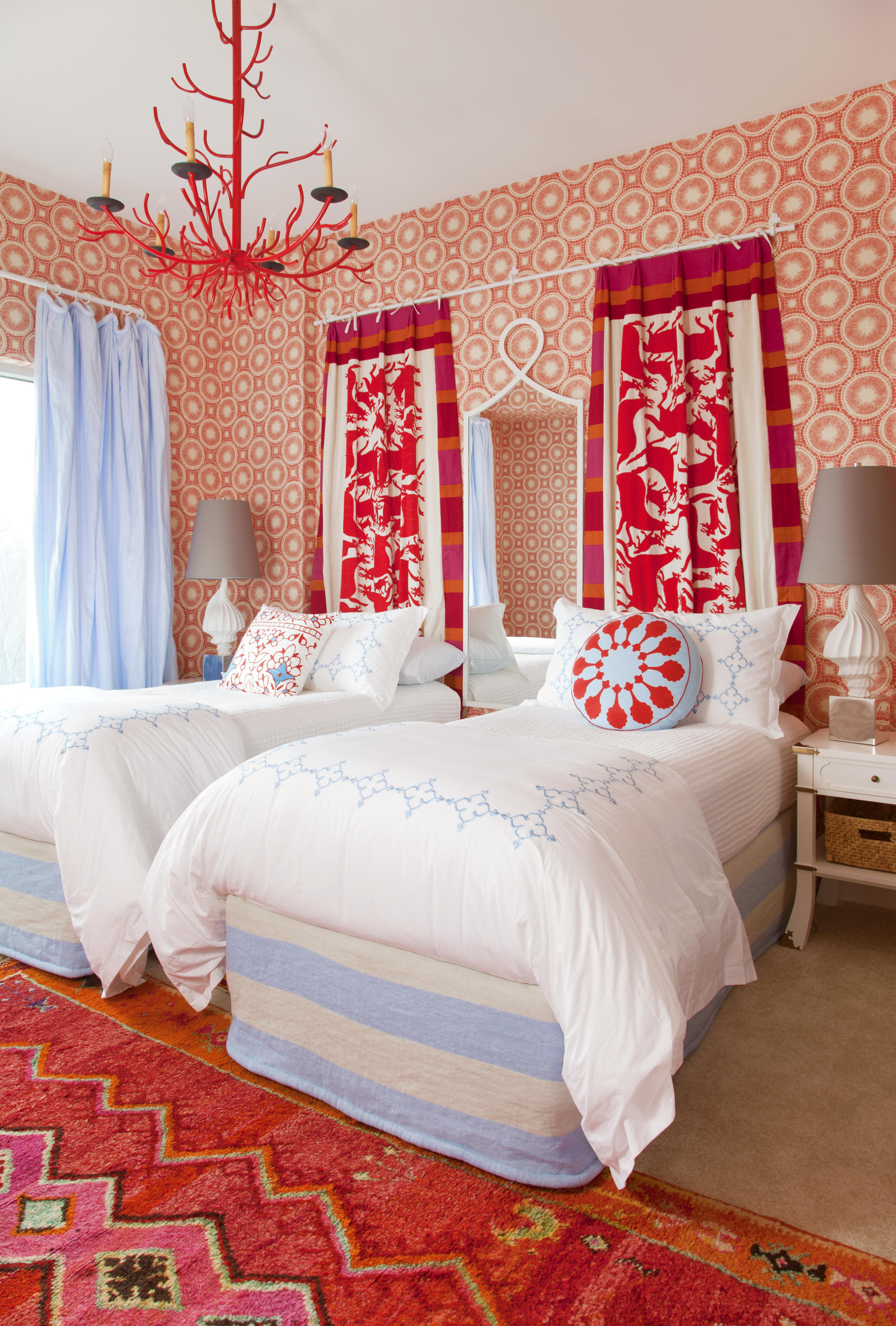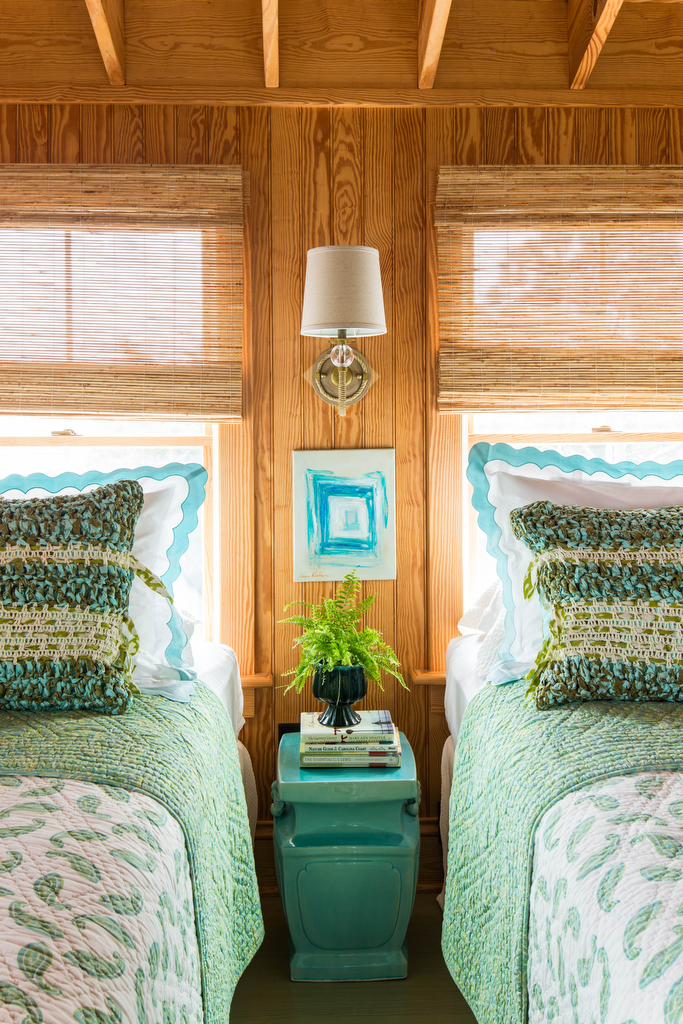Category: Uncategorized
I’m on record as saying that my favorite place is my bed. 8 hours of my day (1/3 of my life) is spent in my bed. I’m also a firm believer that we should all invest the energy and resources in making sure that our beds check the comfort box on all levels. As a designer, I’ve witnessed that the details of comfort are individualistic, i.e. hard vs. soft mattresses, cotton vs. linen sheets, goose down vs. down-alternative pillows & duvets, and so on. But all parties concur that when propped up in bed they prefer to lean back against a soft, padded surface. I have a long list of bed favorites that have backboards in wood, iron, or rattan but for me and the other comfort junkies in my orb, I recommend an upholstered bed.
The design options for upholstered beds are vast. Most of our designs are customized to the project needs. For example, if we have tall ceilings, we will capitalize on the height by creating a floor-to-ceiling installation such as the bedroom below.

In some cases the fabric will dictate the headboard design as in the headboard featured below. The bed shape follows the lines of the embroidered fabric.
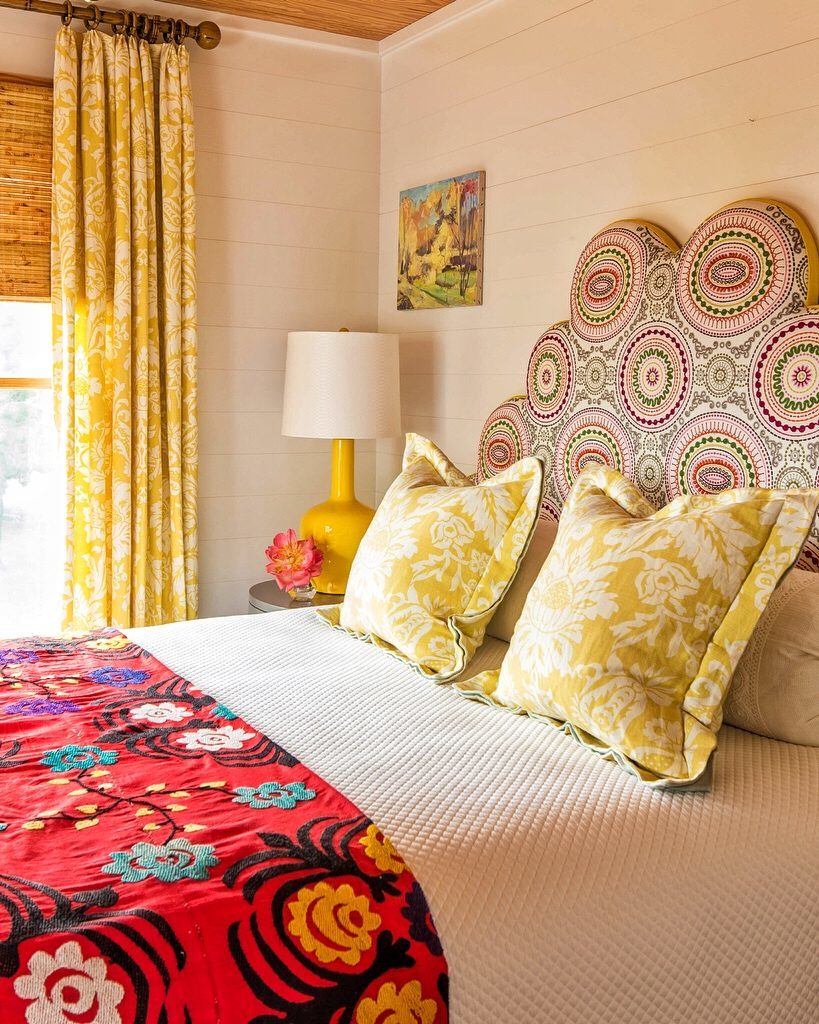
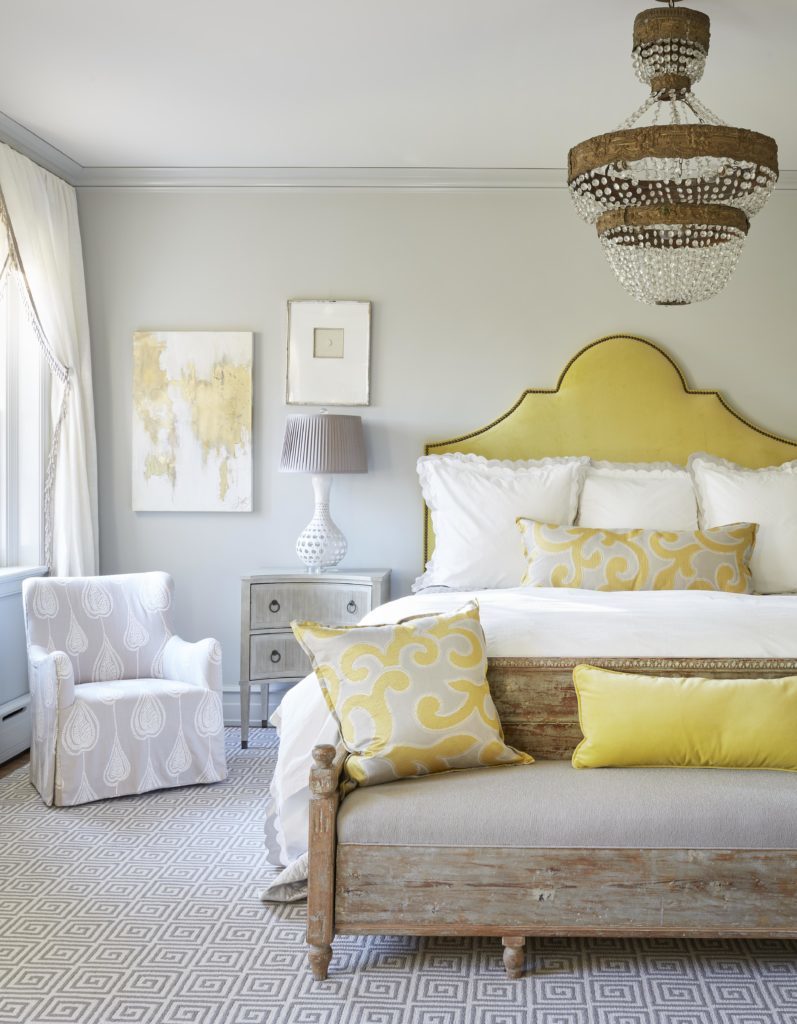
A pop of color in an otherwise quiet room, the sunny yellow velvet of this headboard is just the right color contrast to the cool gray of the wall color. We often use indoor/outdoor velvets or other high performance fabrics for headboards.
In our ‘Map Room’ at our beach cottage, I had twin headboards fabricated in a woven raffia fabric. Metal nailheads outline the edges and the whimsical cutouts in the centers.
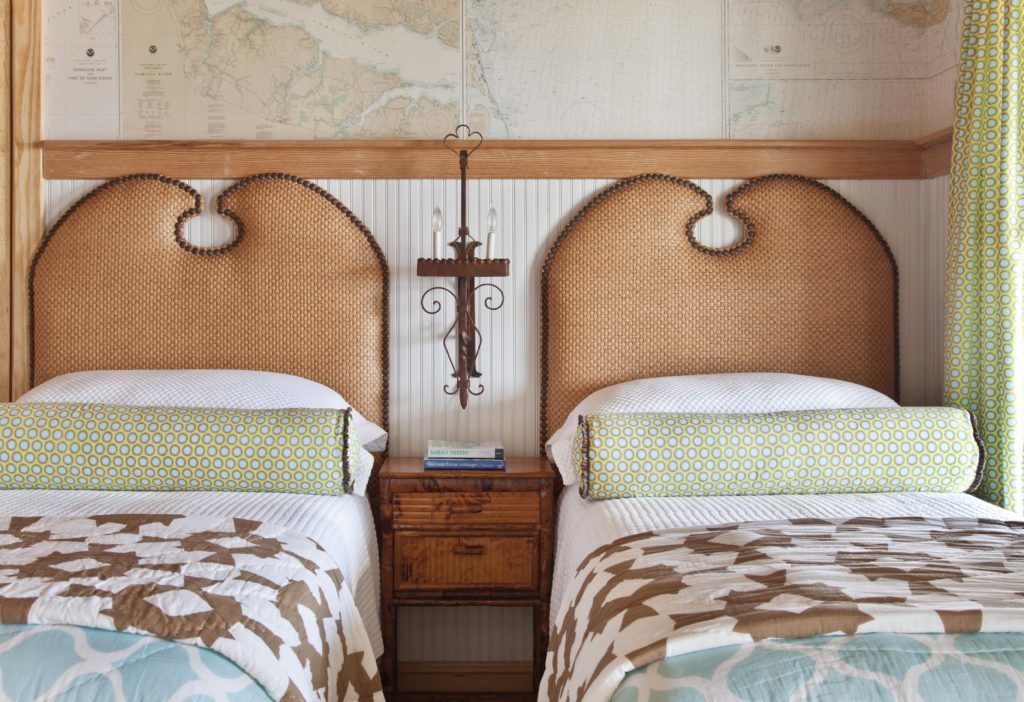
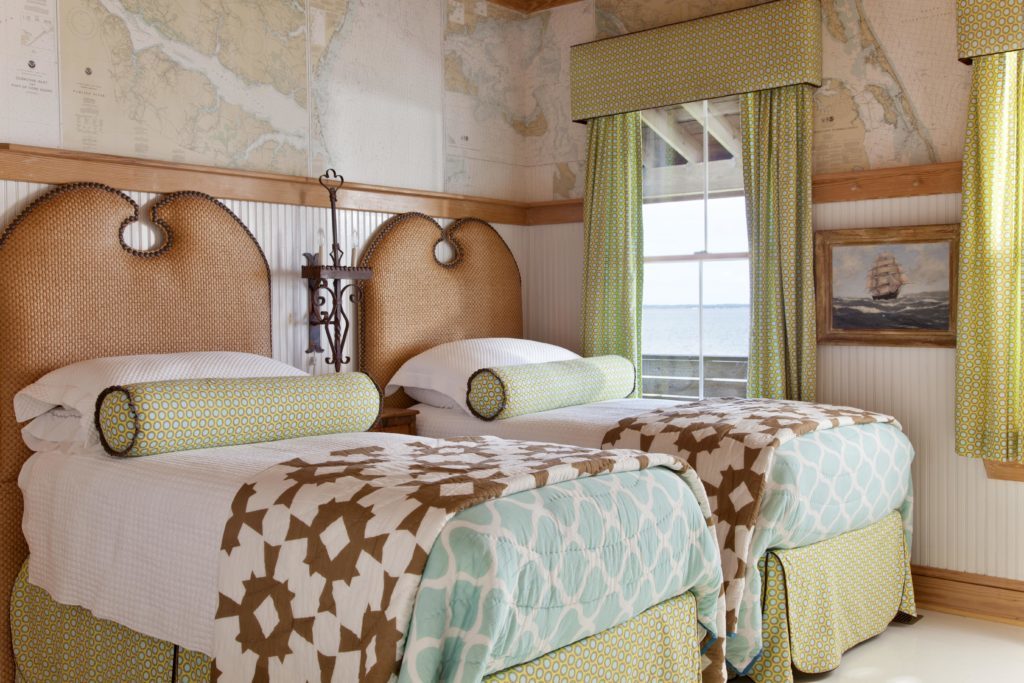
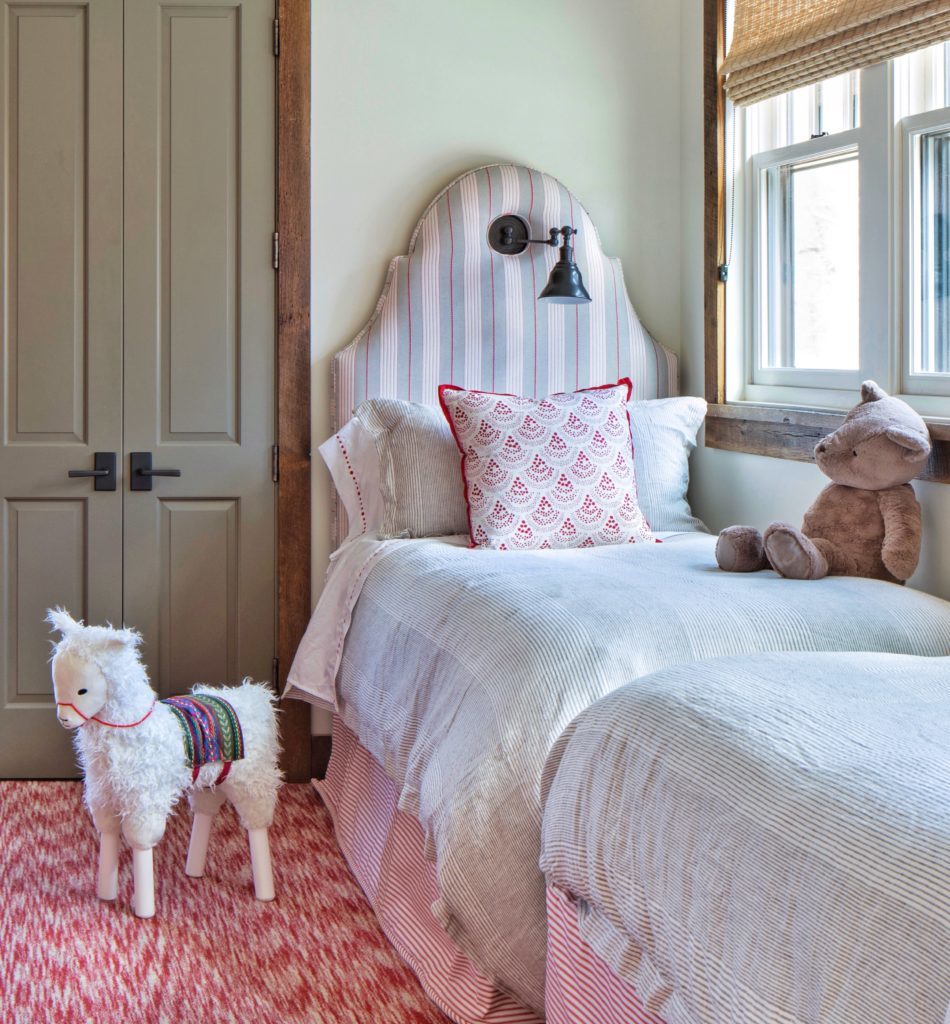
We elongated the height of this red and khaki ticking headboard to accommodate the backplate of the reading light. Have you ever tried to reach up for a bedside reading light and it’s too high or too far away? Problem solved!
Headboard height…. to go high or low?
It’s not unusual for us to propose headboards that are 6 or 7′ tall. We like the drama of a taller height as shown with the mattress ticking headboard below. The extra height is useful in keeping the bed as a focal point. Another height advantage is that once a bed is styled with sleeping pillows and decorative pillows, many off-the-shelf lower headboards are all but invisible. And back to that comfort quest, if you are over 6′ tall there’s not much to lean back on without a generously scaled headboard height.
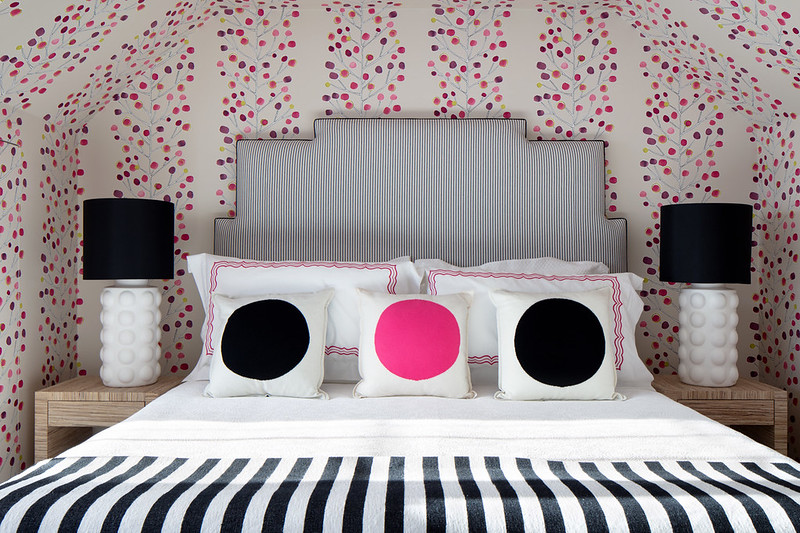
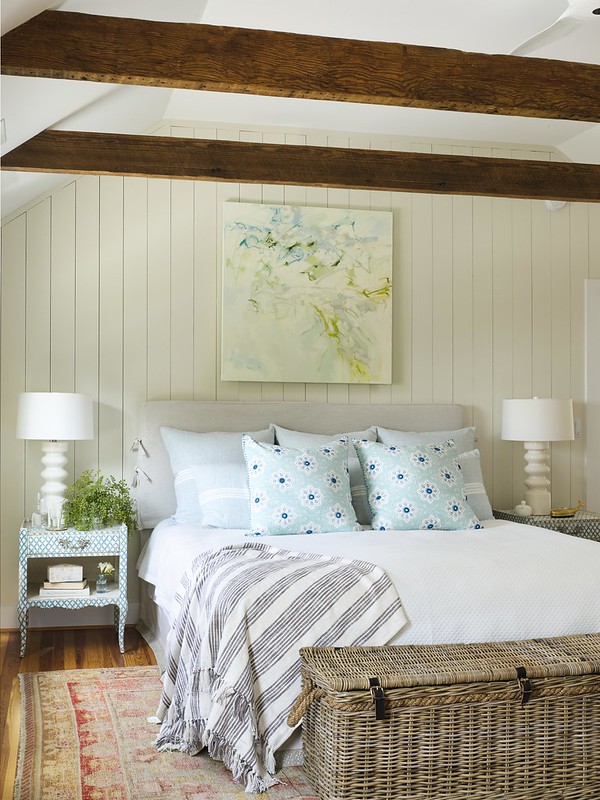
And then there are projects when the bed has a quieter profile like this simple rectangular headboard. Generously padded and dressed in a washed linen slipcover, it is anchored with ties on each side. A lower headboard opens up the opportunity for something decorative above like a beautiful painting.
Standing tall at just under 7′, this arc-shaped bed mimics the circular motif of the fabric. An exaggerated height gives ample room for pillows while still revealing a broad expanse of the bold, style-driven fabric.
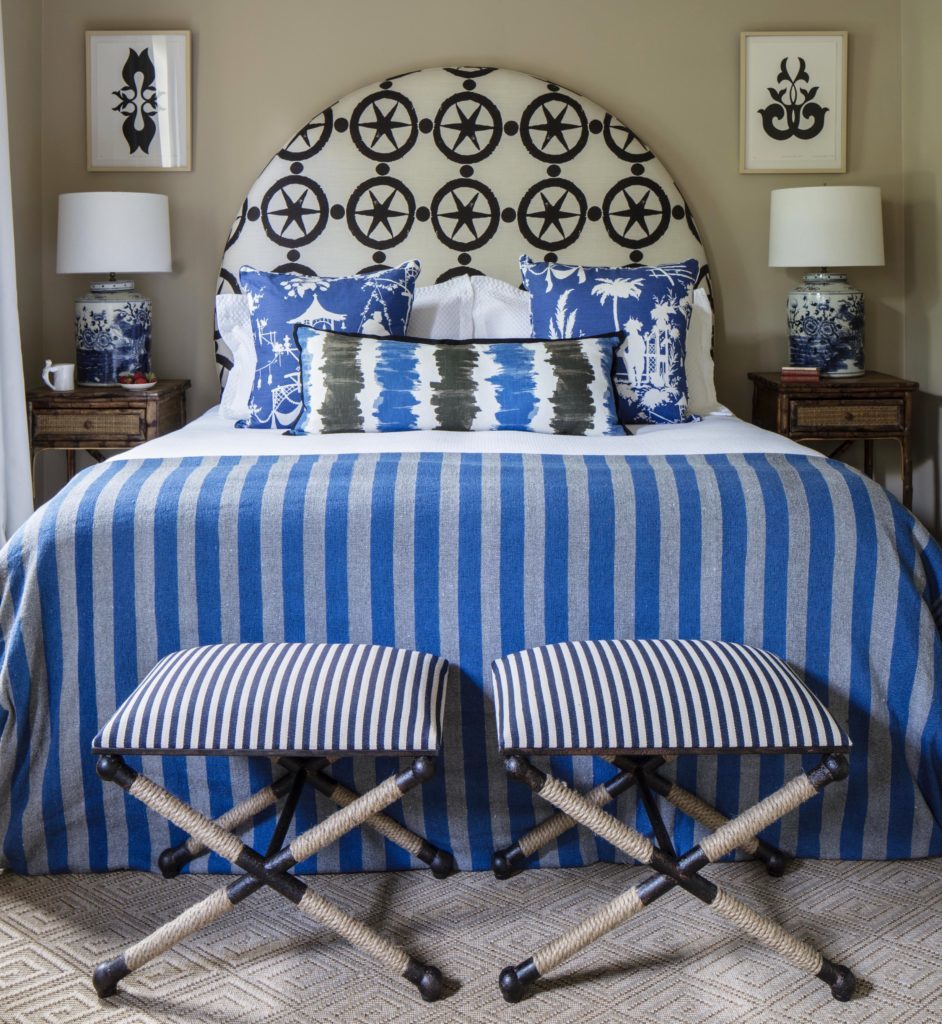

Lower ceilings and the option for creating a future gallery wall above this beach house headboard called for a simple shape and a lower overall profile.
Graphic Patterns
A boldly patterned fabric on the headboard can be the driver of design schematics in a bedroom. The shape of the arched headboard below is one of our most popular designs and orange and pink were a favorite of the college-aged daughter who was our design muse.
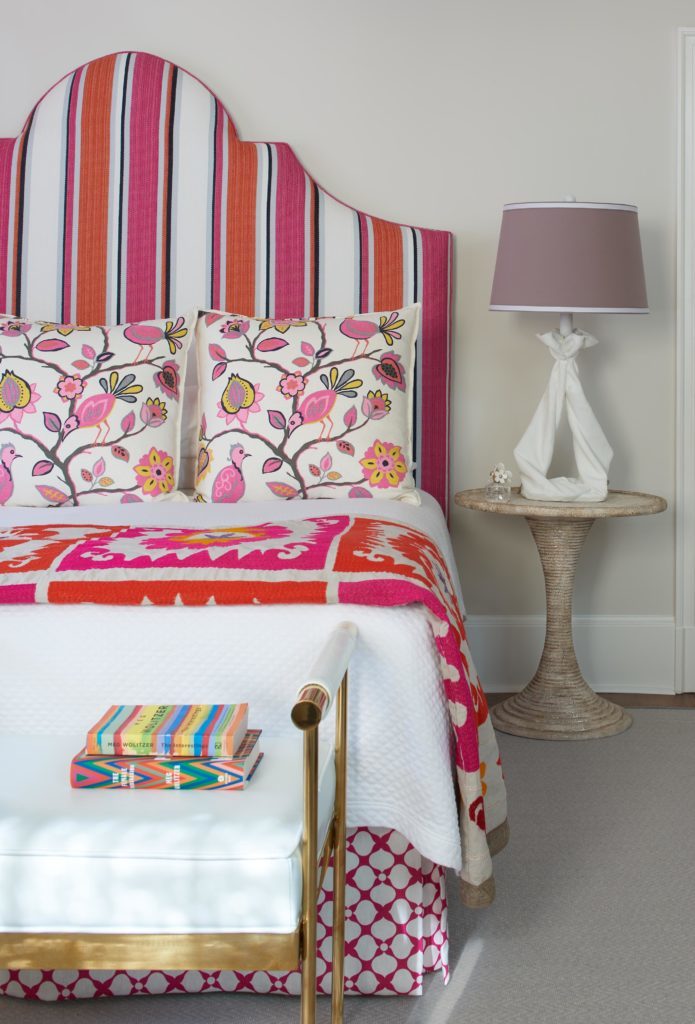
A twin bedroom in the guest cottage of our beach house serves as a small gallery for children’s artwork while the headboard sports an inexpensive Ikea upholstery fabric, reminiscent of a Marimekko design from the 1970’s.
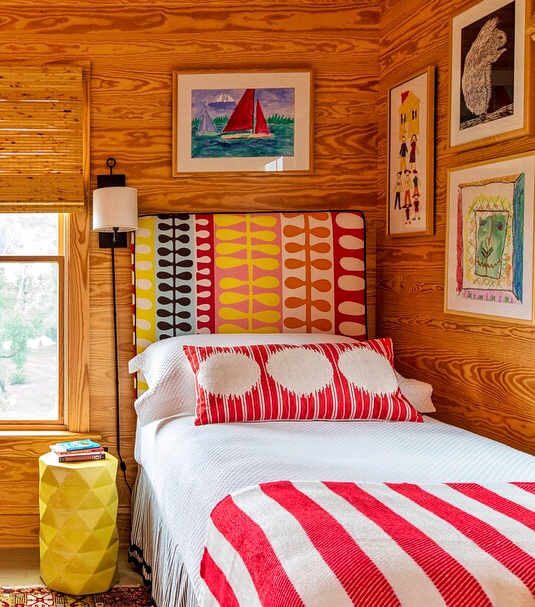
Outlining the shape of this pair of twin headboards with a darker teal blue helps to define the details of their shape. The cornices above, draped and upholstered in the same fabric create a cocoon feeling.
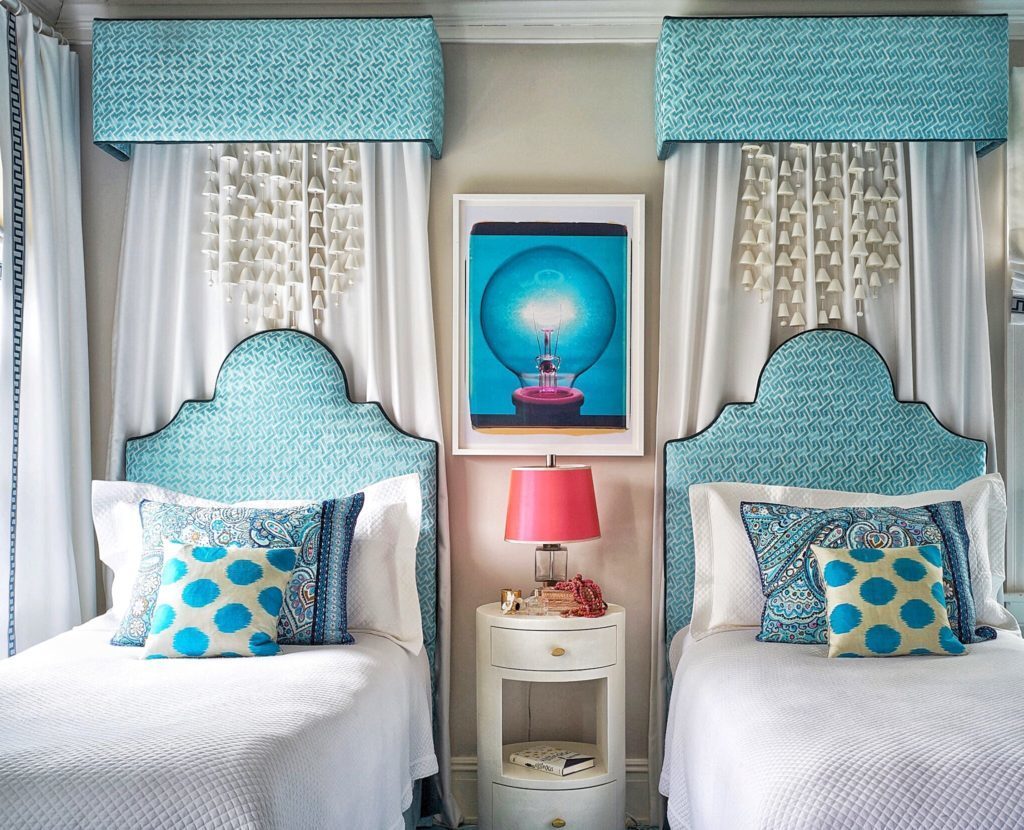
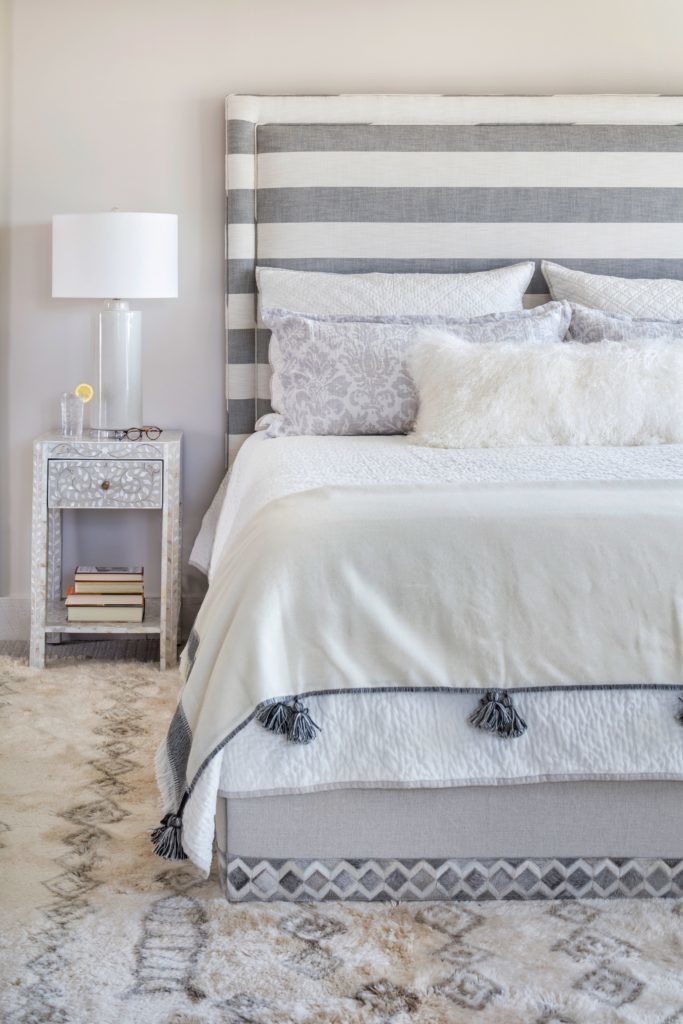
Quiet neutrals are often a request from clients when designing their bedrooms. While we stayed with a soothing palette of creams and grays, we amped up the visual impact of the headboard by running the bold stripes horizontally.
Pink Three Ways
No surprise to many, I love pink. When I find a kindred spirit who is open to pink in their bedroom, it’s cause for a celebration. My favorite upholstery for pink headboards is a linen velvet. The fabric content places it in a high performance category while the nap of the velvet causes it to have subtle changes in hue as you view it from differing angles. The color gray is a natural compliment to pink as shown in all three rooms below.
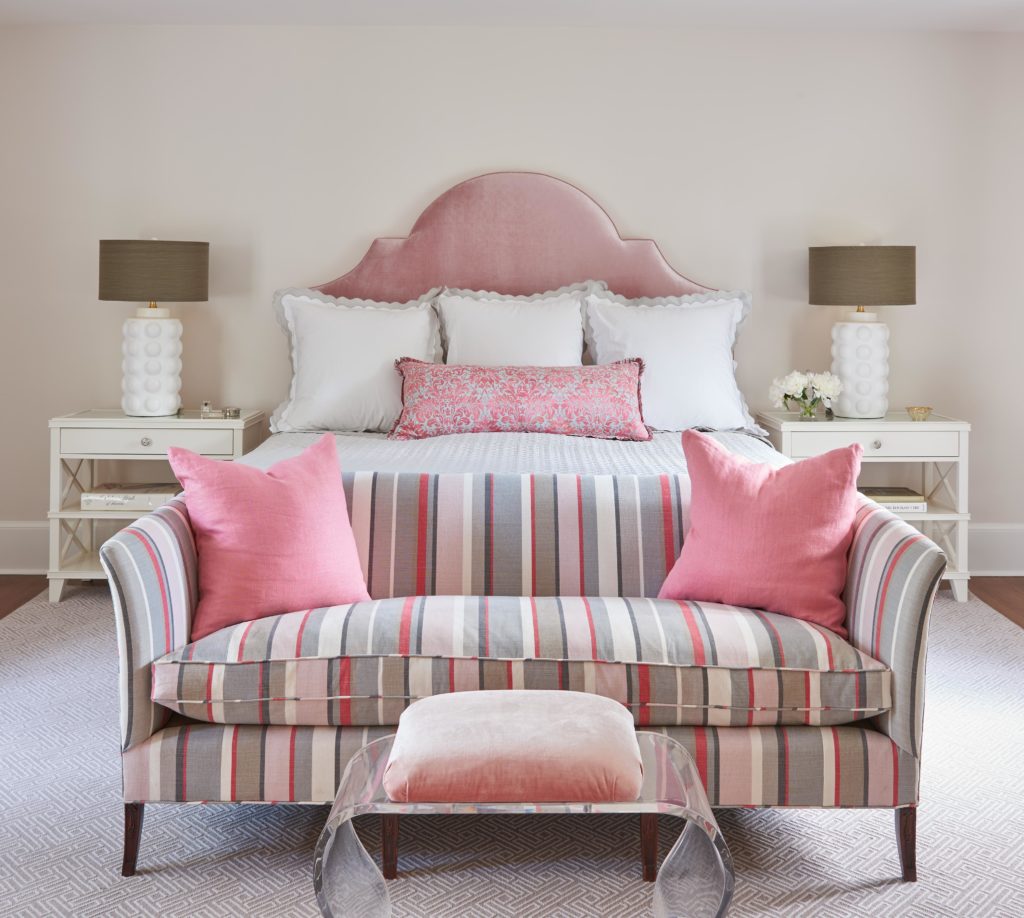

A boho mix of furnishings in my own bedroom….
Our client was all-in for glamming up her bedroom with antiques, silver-leafed bedside chests, and an Art Deco-inspired headboard shape (one of my favorite designs).
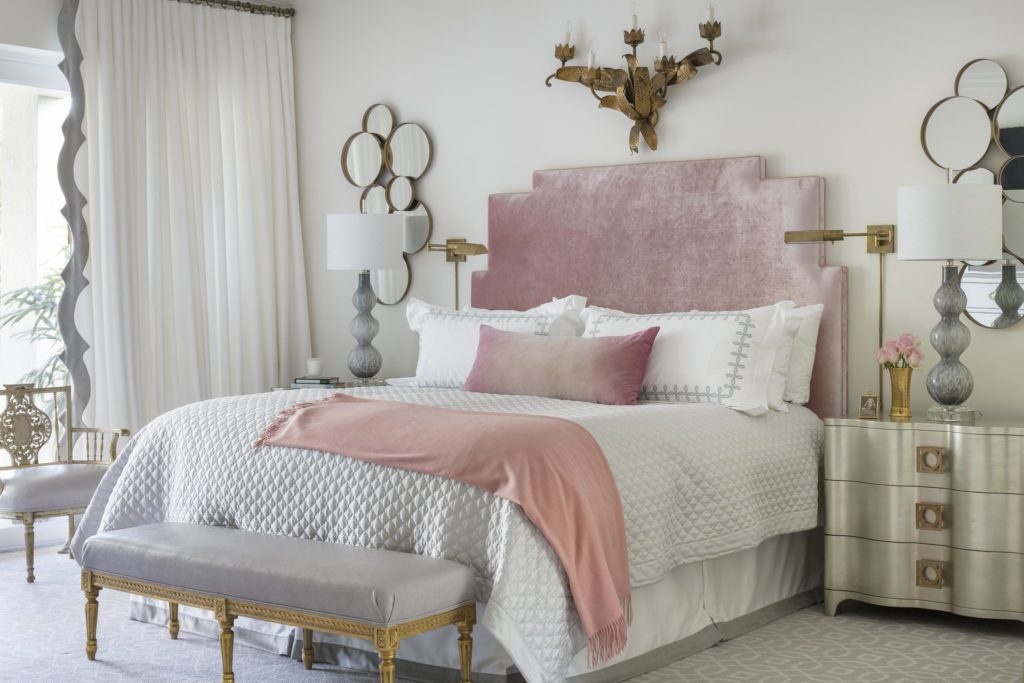
While we are all sheltering in place, I hope your own bedrooms are providing a safe and comforting haven.
Be safe,

The days are getting warmer. The boxwood outside of my window are flushing out in new, bright green growth. Early birds like forsythia, redbud, and camellia are in full bloom and the dogwoods are just days away from their full glory. It’s springtime in Virginia and everyone is outside, albeit six feet apart for now.
Our thoughts have turned outside toward our lawns, our gardens, and our outdoor living areas. Outdoor rooms are a big part of our home décor now. In designing exterior living spaces, our approach is much the same as interior ones. Beauty is a prerequisite, comfort is important, and durability is a necessity. Avoiding furniture groups in matching sets and cultivating an outdoor room that has the right mix of materials creates an evolved, layered space. In the images below, note the quiet color palette (more on this later), and the addition of tall pedestals with ferns. Just as an interesting exterior garden is landscaped with plants that vary in scale and texture, we landscape our outdoor rooms with varying heights of furnishings and accessories.
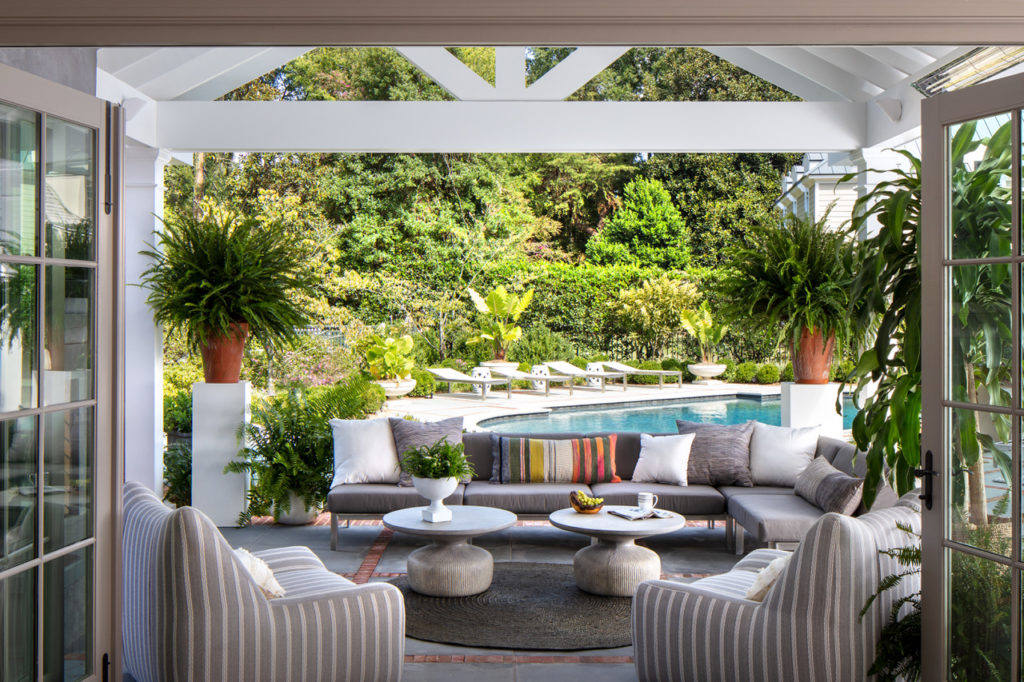
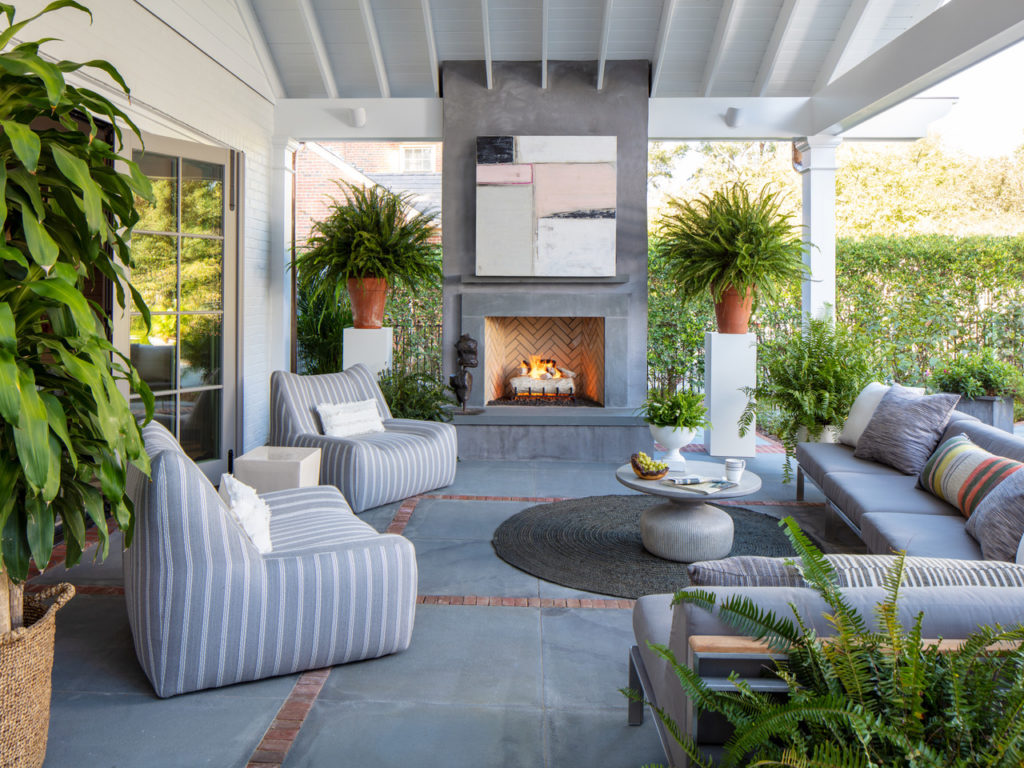
In the rear of the brick Georgian home below, the terrace seating area and dining space have a mix of powder-coated aluminum seating, woven chairs, lead planters, cast stone tables, and ceramic garden stools. On a large, open terrace like this one, adding tall plants can help to create intimacy by spatially defining an area. Again, the color palette is simple. Blacks, whites, grays, and greige are the building blocks we prefer — Mother Nature is a dominating color force and we like to take a backseat to her ever-changing palette. Small garden stools have multiple uses in an outdoor room and can serve as drink tables, plant stands, and extra seating.
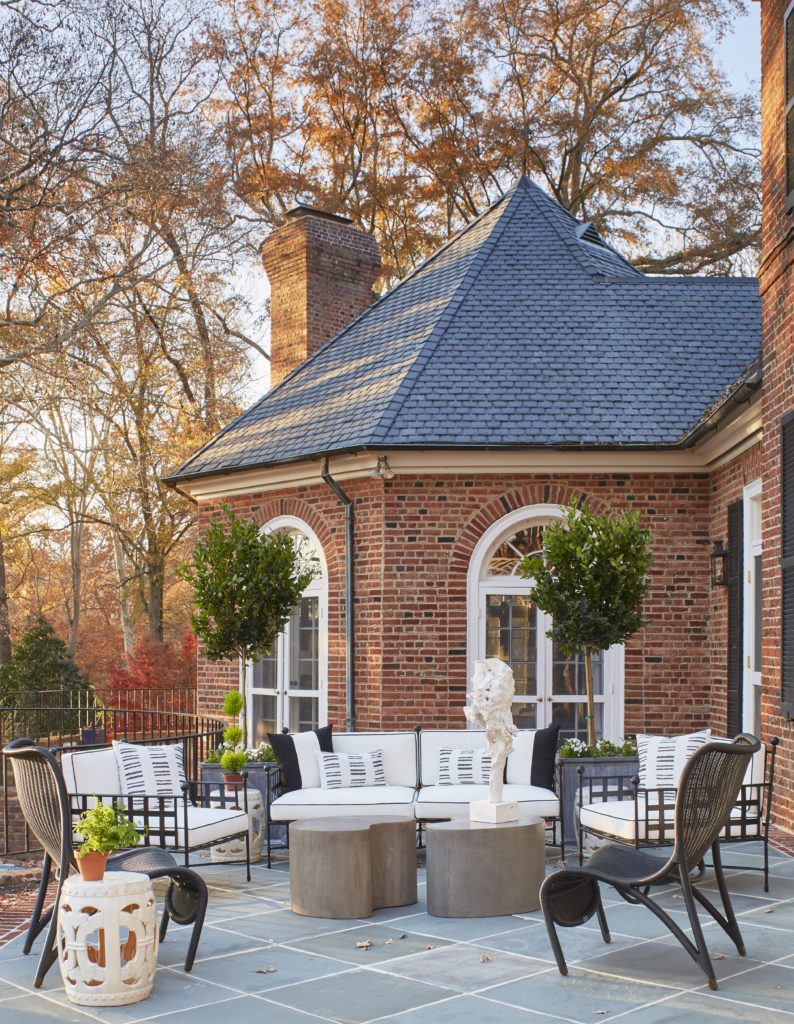
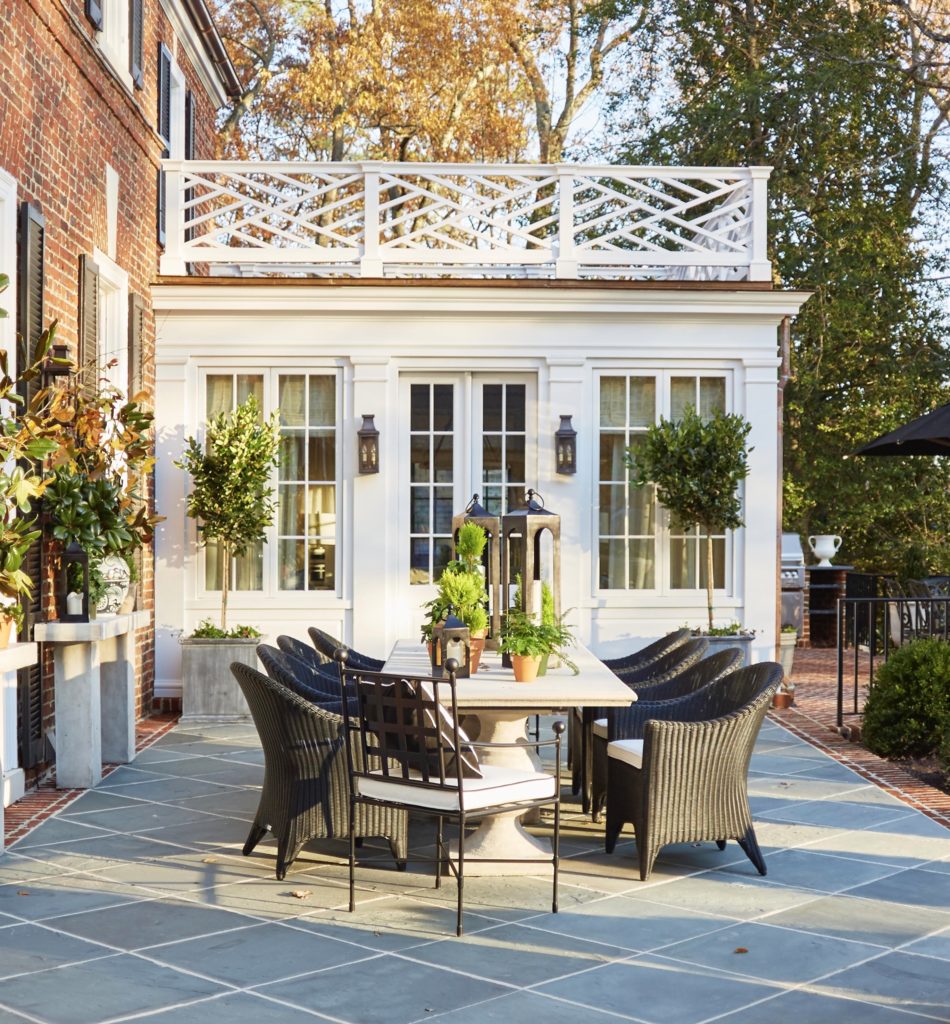
Waterfront properties and tropical climes (like the south Florida bungalow below) beg for and in turn tolerate pops of true color. So, while everything pales next to the gorgeous purple bougainvillea, we added turquoise accessories like pillows, planters, and a whimsical umbrella. A circular jute rug defines the seating area, and a sweet pup has definitely found his happy place on the sofa.


The waterfront porch below has panoramic views. So, with the surrounding expanse of blue sky and water, blue accessories seemed the logical choice for a color accent. Vintage grey wicker with white cushions are dressed with a range of blue pillows in hues from sky blue to deep indigo. The rattan peacock chairs bring a taller landscape element. The mix of materials is what gives the room a warm, lived-in feeling. The collection of wicker furniture (a family heirloom) feels right at home in this historic farmhouse, as do the antique trunk and the vintage tortoise shell table next to the napping cots.
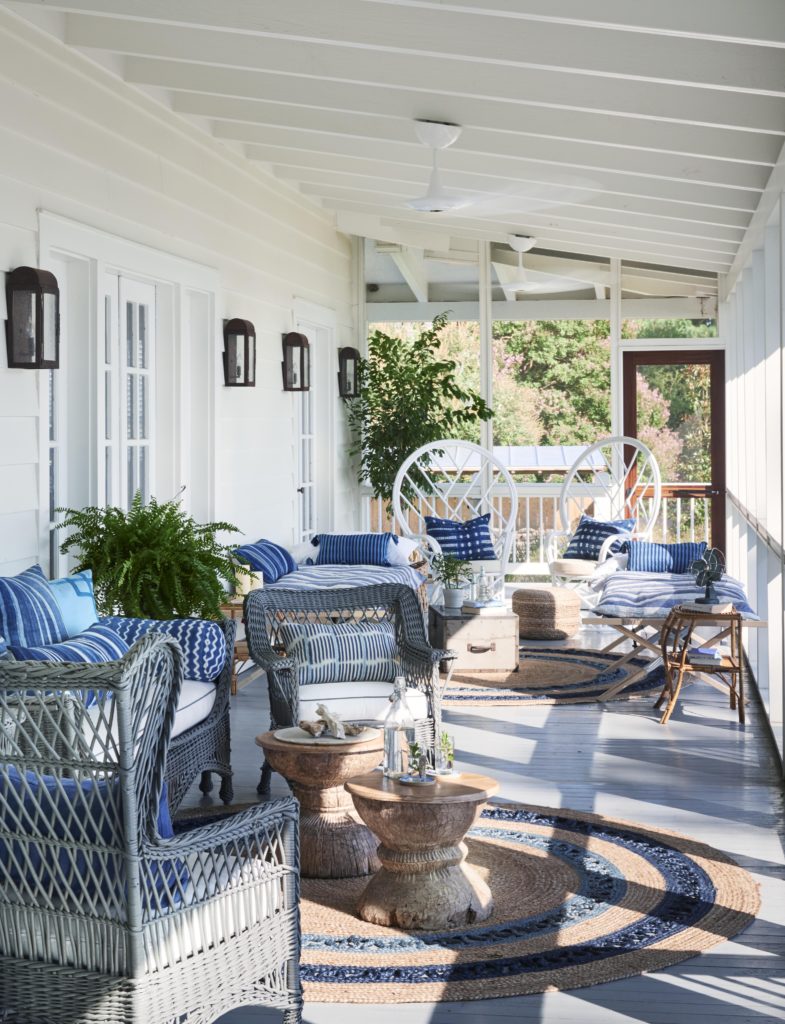
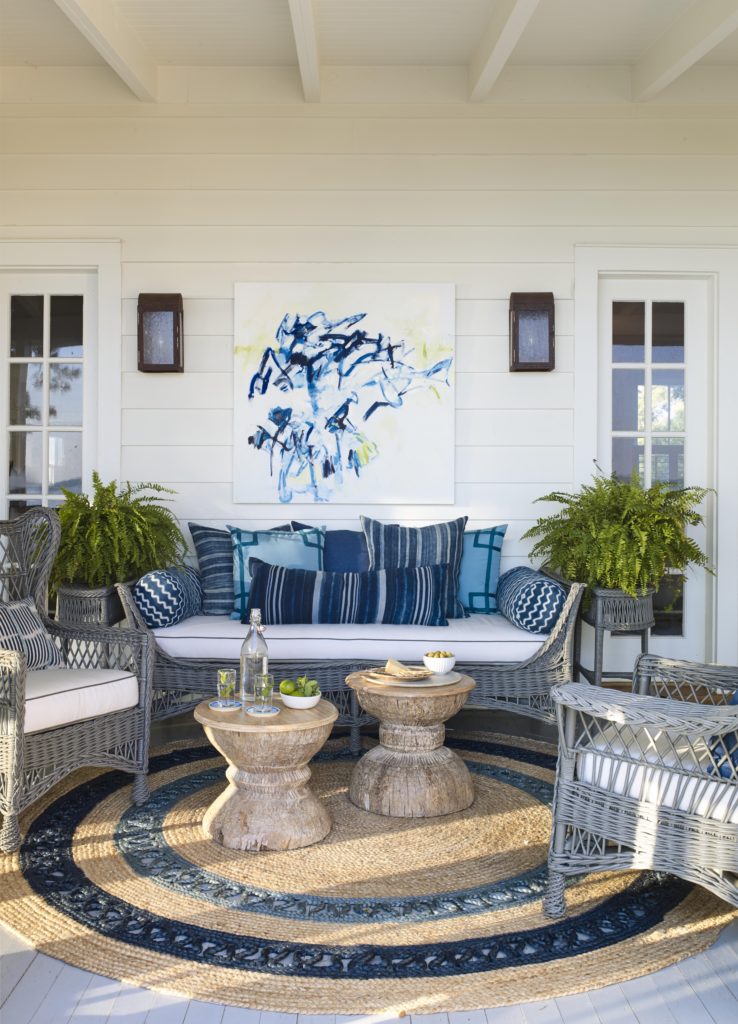
Everything tastes better outside! Make time to tablescape your outdoor dining rooms just like the interior ones.

In the winter months, this mountain terrace is home to strong winds. Heavier teak furnishings insure that nothing can be blown about and feels more in keeping with the overall rustic vibe. The ceilings lanterns are chained in all four corners for added stability. Like the pillows, bean bag footrests provide a softer touch.
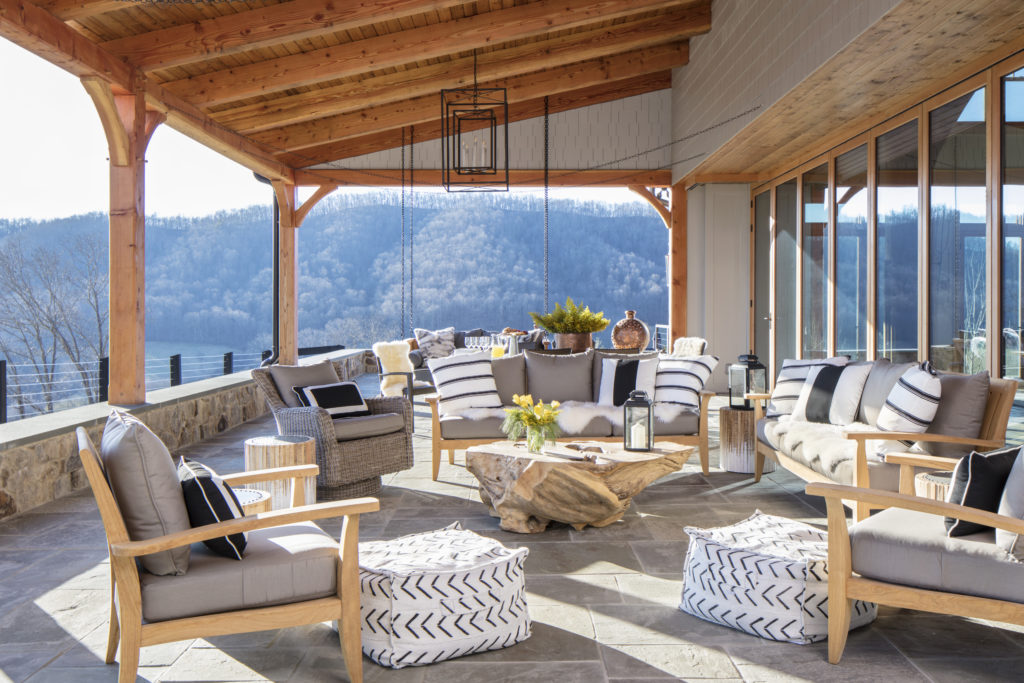
We often change out accessories in summer and winter seasons and a few small tweaks can make a dramatic impact. The two photos below show a mountain home porch outfitted with seasonal changes. In the top photo, the addition of a puffy white hide footrest and a fur blanket take the chill off. The roaring fire doesn’t hurt. Rules are made to be broken, so we veered off of our quiet palette for the upholstery cushions. If limiting your palette to black, white, and greige is difficult, make sure to use colors that you can see in your vista like the blue of the sky or as below, the green of the evergreens on the mountain range.

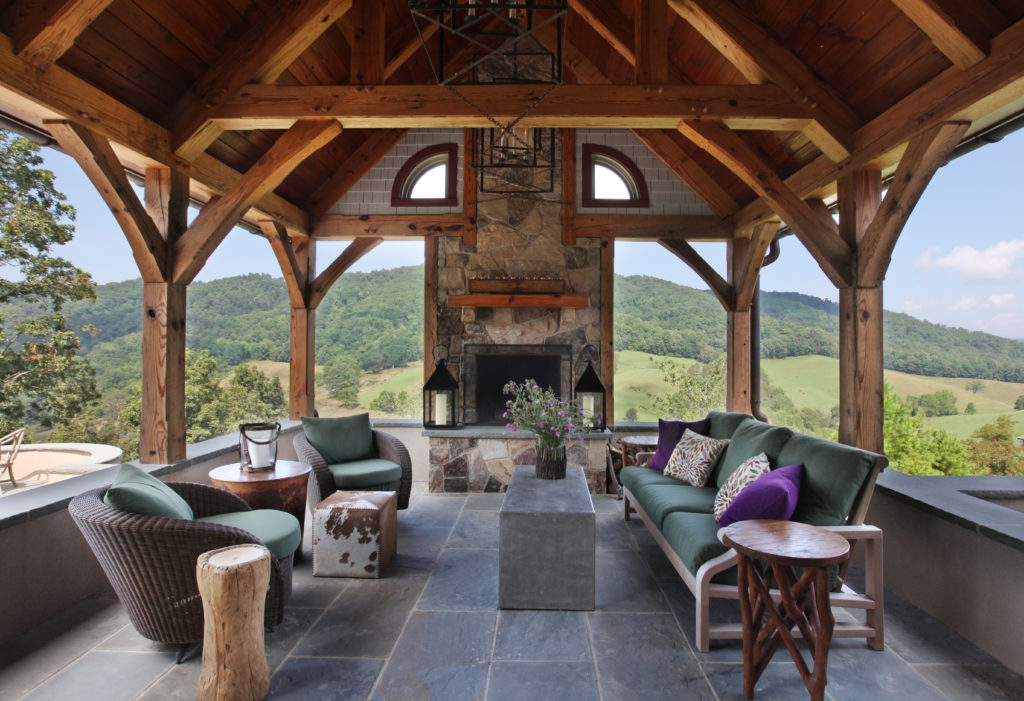
Remember that your outside rooms need to relate to their adjacent interior rooms. The terrace below reflects our client’s preference for clean, streamlined design elements. Tall zinc planters with tailored boxwoods and the simplicity of the Saarinen-inspired table provide a fluid transition from the indoor kitchen.

On my own porch I repeat many of my outdoor design go-tos such as limiting color (let Mother Nature rule the show), a rug that defines a seating space, the addition of tall plants, and a mix of materials including woven chairs, an aluminum sofa, a zinc console table, an antique jardiniere planter, and paper mâché cocktail tables.
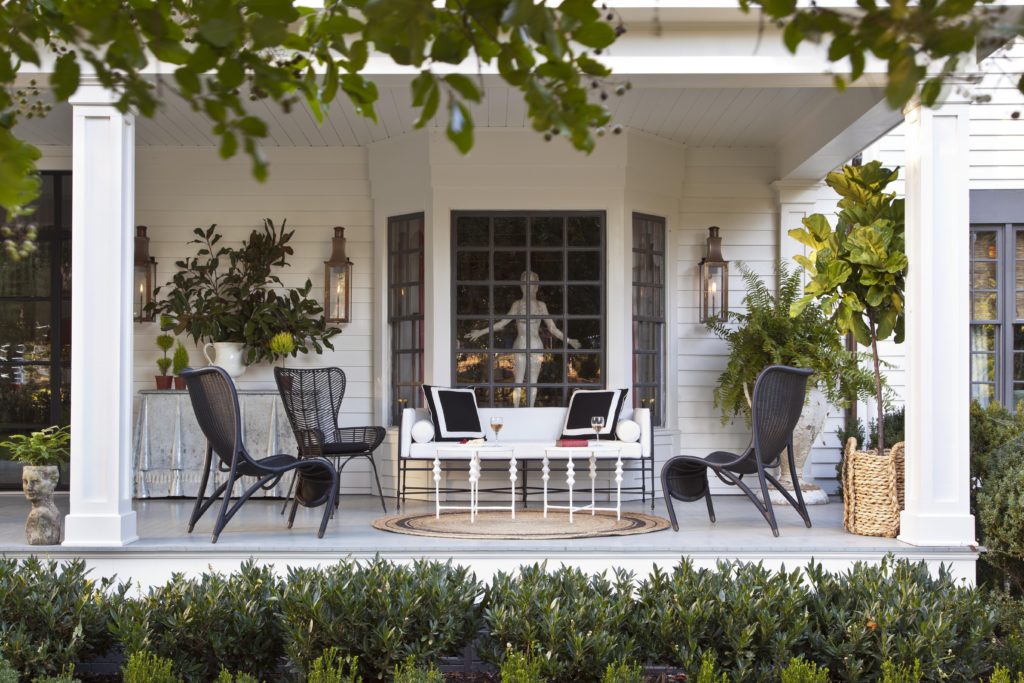

Summertime is calling me and so is my summer cottage on the Outer Banks of North Carolina. The cushion color on the outdoor porch below was chosen to blend in with the weathered wood of the benches and the teak coffee table aged naturally to a similar hue. Chairs with rope slings have a beachy feel and also a sentimental value: they were woven by two of my sons during their summer working as weavers at our local hammock shop.
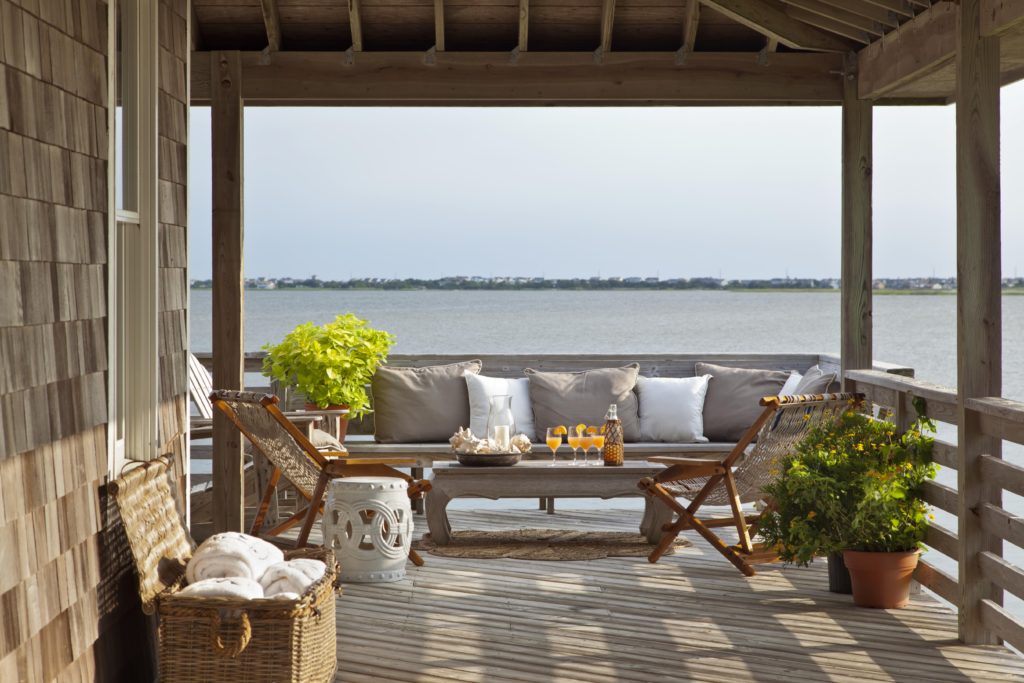
If you are leery about installing art in an exterior room, use exterior architectural elements or finds from nature like these pieces of driftwood below. The monkey vine adds height, more sculptural interest, and also serves a dual purpose: when wrapped with small lights it becomes a floor lamp.

Enjoy springtime and start thinking about your outdoor spaces! If you can’t be outside, I hope these pictures transport you to a time very soon when you’ll be dining al fresco with family and friends.
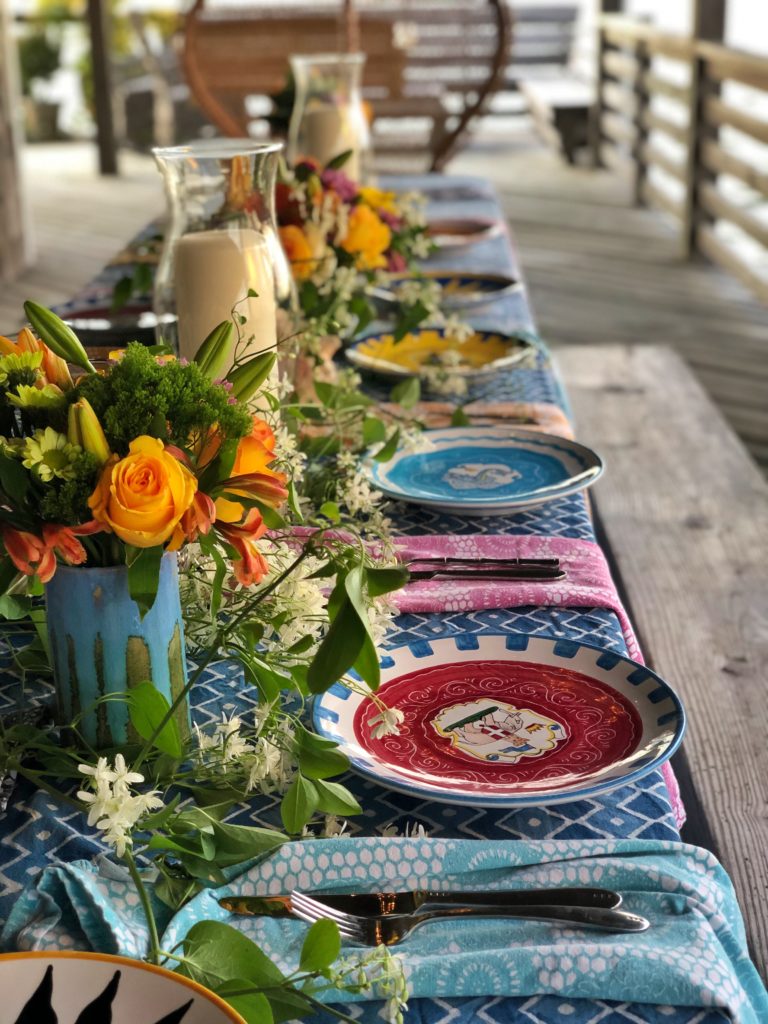
Be safe, Janie
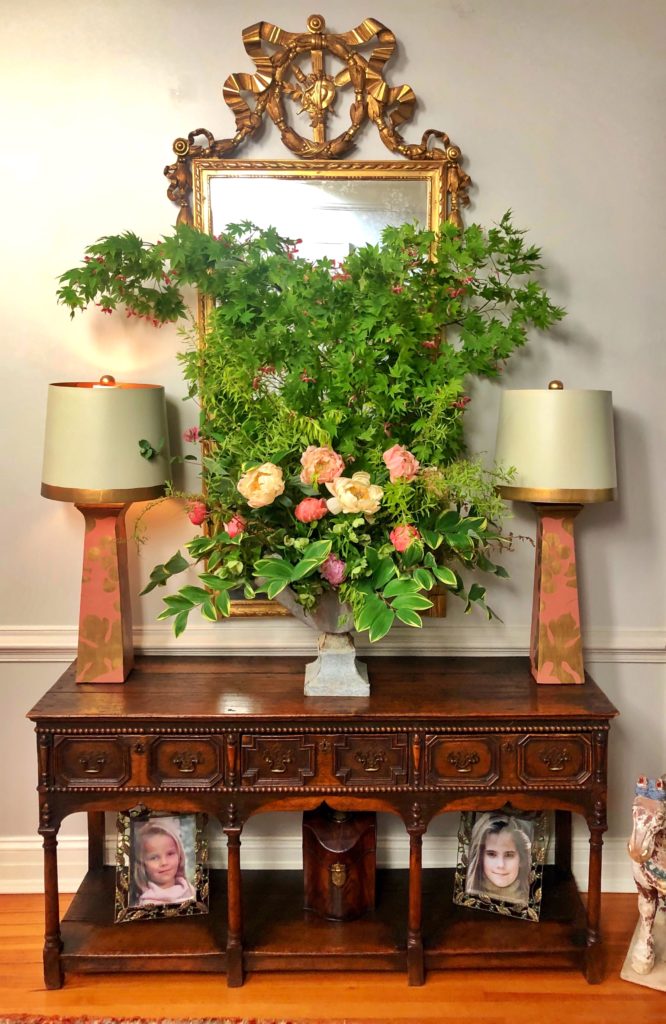
What is Historic Garden Week in Virginia and what is all the hubbub about? I’ve had so many people outside of the state of Virginia ask me that question in the last several months as I’ve worked on prepping my own home and garden for my tour date, as well as prepping a few of my clients. In short, it’s a week-long affair spanning across the state encompassing multiple towns, hundreds of garden clubs, and thousands of volunteers. The Garden Club of Virginia sponsors the event and proceeds fund the restoration and preservation of Virginia gardens as well as funding research fellowships in landscape architecture. I guess I’m a Garden Week veteran of sorts as I’ve had my house open for tour four times (in three different houses) and helped dozens of clients prepare for their tour dates. I’ve learned the ropes and wanted to share the backstory of what goes into prepping for an event like Historic Garden Tour in Virginia.
Historic Garden Week co-chairs begin early mapping out cities and tour routes. Ideally, tour dates have homes located in clusters suitable for pedestrian traffic or quick shuttle bus rides. Homeowners are asked if they would consider opening up their homes as far as three years in advance. Having this lead time is helpful in multiple ways. If you plan to do any major planting or landscape design changes in your garden, 3 years gives you time to prepare, and time for your plants to establish themselves and fill out a bit. I’ve been longing for a parterre garden in the center of my back lawn for a long time and Garden Week gave me the perfect excuse. You can see in the images below that having time for plantings to mature is important, the 1st image being my parterre garden on installation and the 2nd image, two years later during last week’s garden tour.
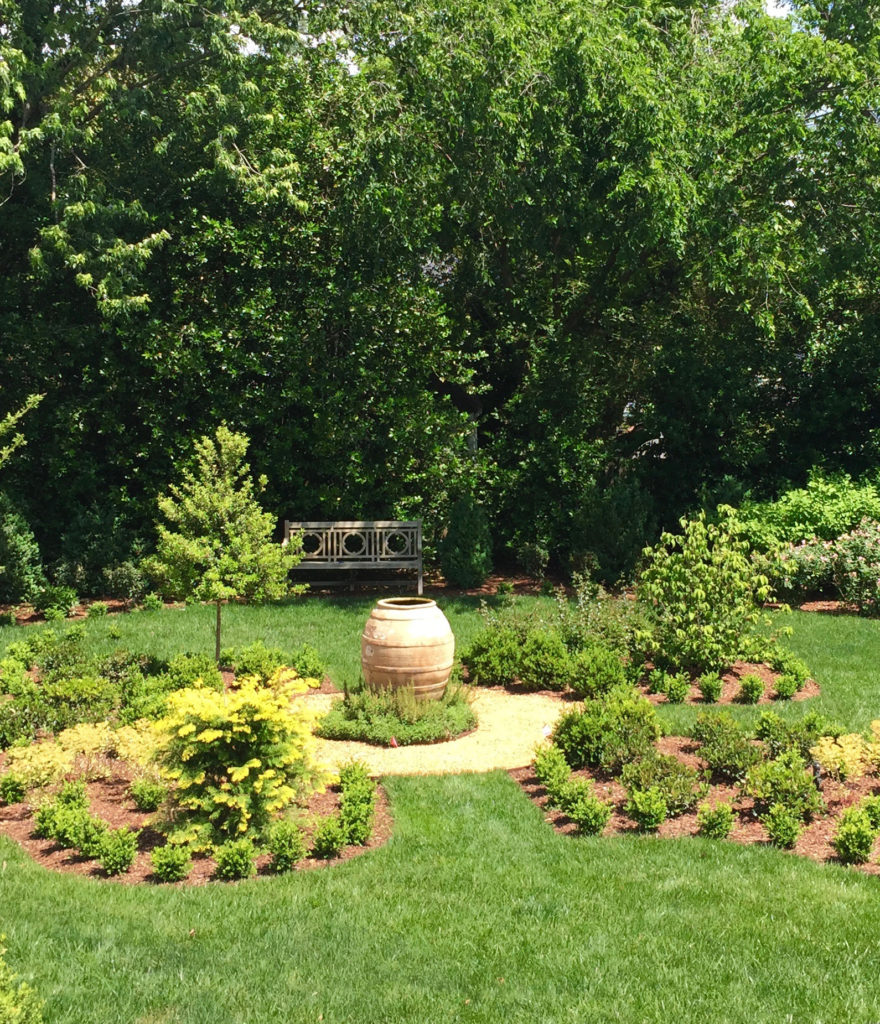

And make no mistake, this is also definitively a house tour. In prepping for that aspect, there are the basic household improvements on like power washing, touch-up painting and then there’s always the fluffing of the interiors. This year I had two clients open on the same tour date as my own home so we have had our Garden Week “to-do” lists in action for a few years. The final flurry of the week before involved a fair amount of running house to house, restyling bookshelves, installing new curtains and artwork, having chandeliers cleaned, silver polished, etc. Meanwhile you are dodging the landscapers, mulch trucks, and window washers at every turn.

The Flower Ladies (as I called them) start to call you about six months in advance. Different Garden Clubs are assigned to different homes. They’ll want to do a walk through to establish a traffic flow in your house for tour day. There’s also a brief interview with the Garden Ladies in charge of gathering the info on your house such as the architectural history of the house and garden, as well any interior points of interest such as special antiques and artwork. A description of your house is published in the Garden Week booklet and this gives the docents volunteering in your house on tour day (1 per room and several in the gardens) information to share with visitors.
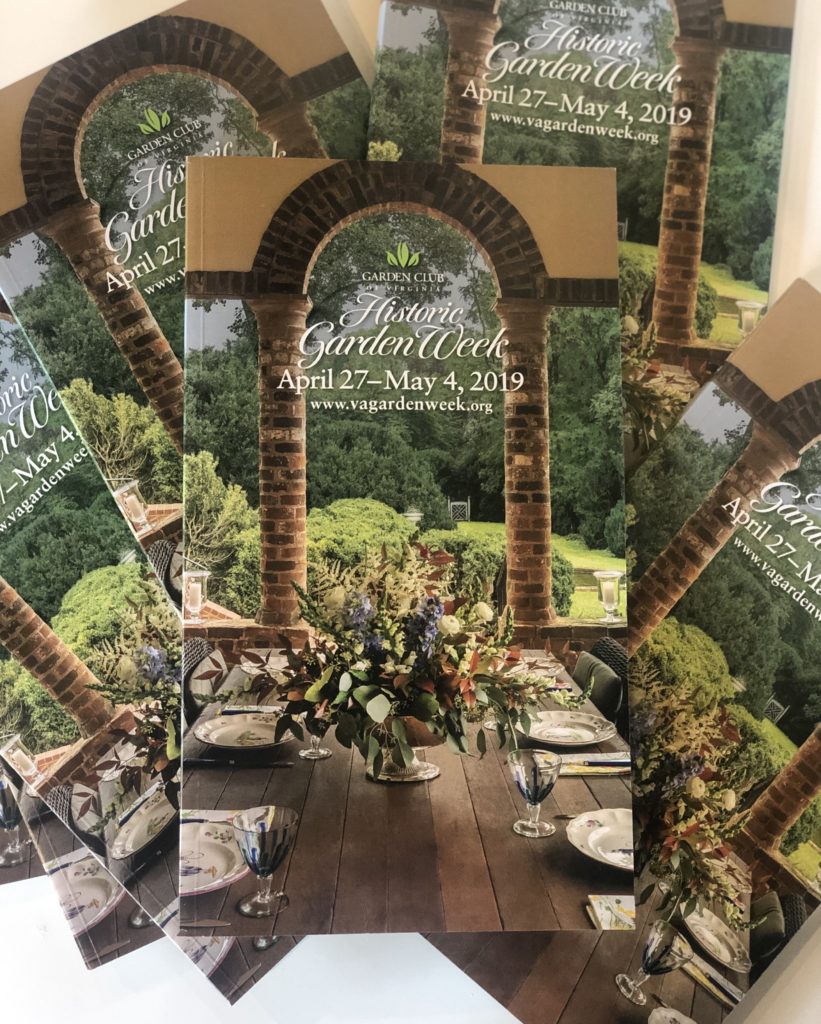
Another group of Flower Ladies will visit a few months out to review your personal likes and dislikes of plant material for the interior arrangements. They will also help strategize as to which flowers and which containers will land where. The goal of the Garden Club is to use only native blooming plant material from Virginia and if you are lucky, and Mother Nature cooperates, there will be a bounteous supply of dogwood, rhododendron, azalea, peonies, daffodils and tulips.
Flower Ladies unloading their goods:
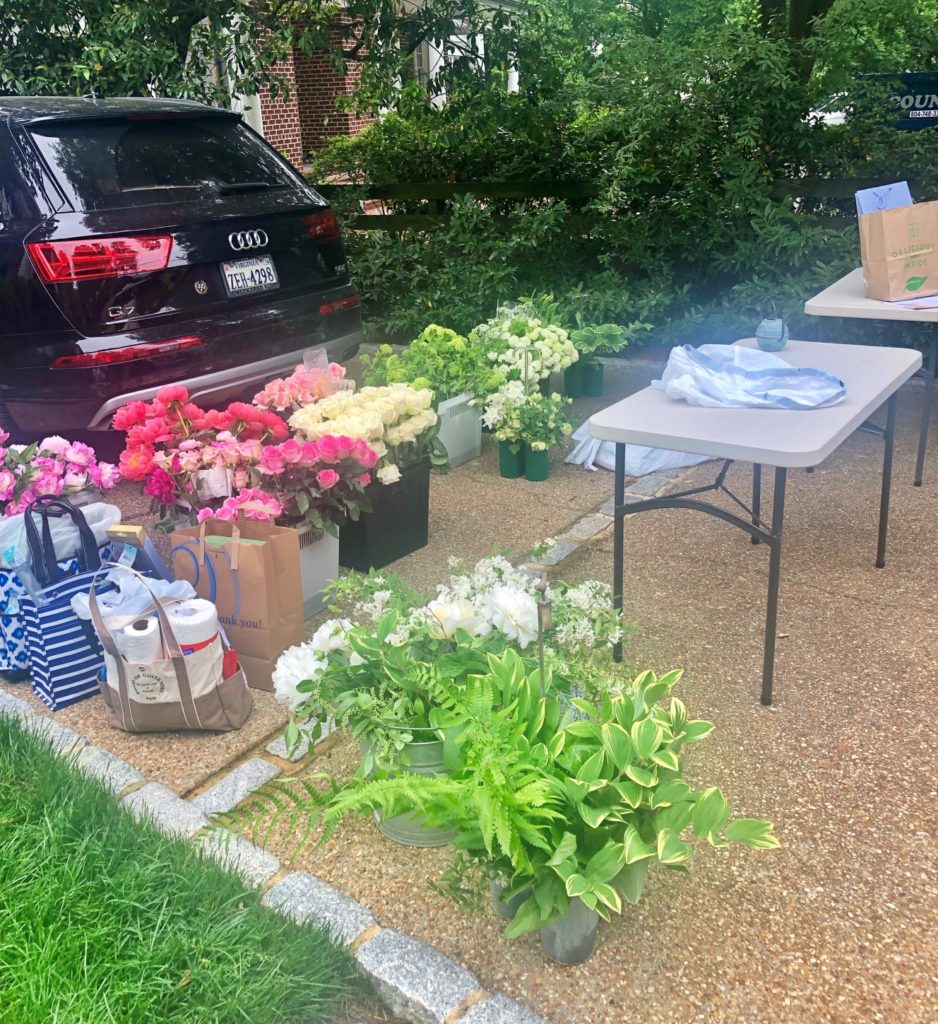
This year I had a particularly creative group of volunteers designing the flowers, all from the James River Garden Club. My favorite creation was the “FlowerFall” arrangement in front of my mantle in the den. These talented women created strands of roses to drape from the mantle by stitching them together with needle and fishing line.
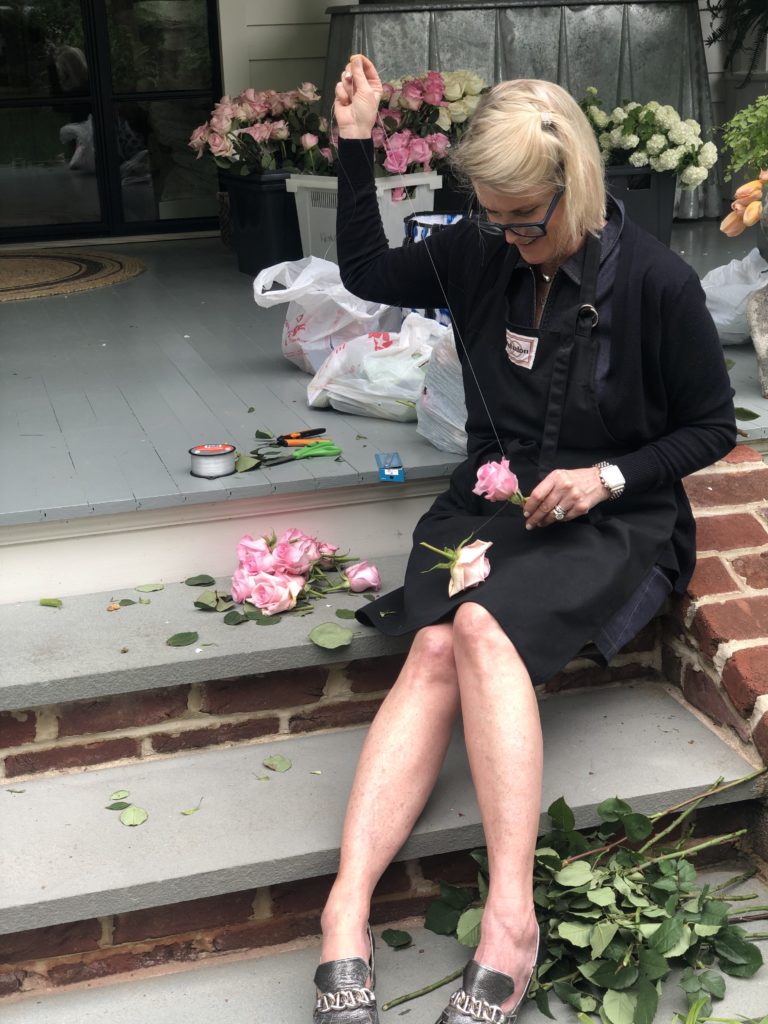
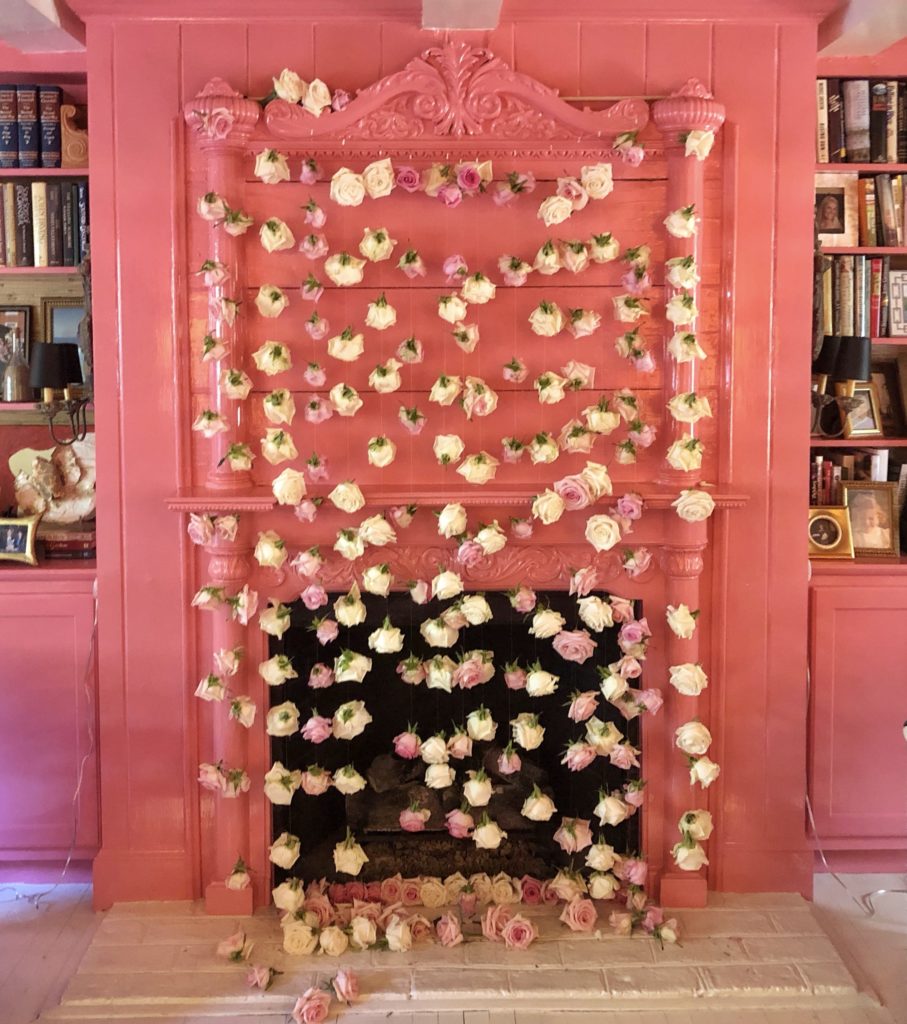
Another special arrangement was the rectangular flower garden on my kitchen table.

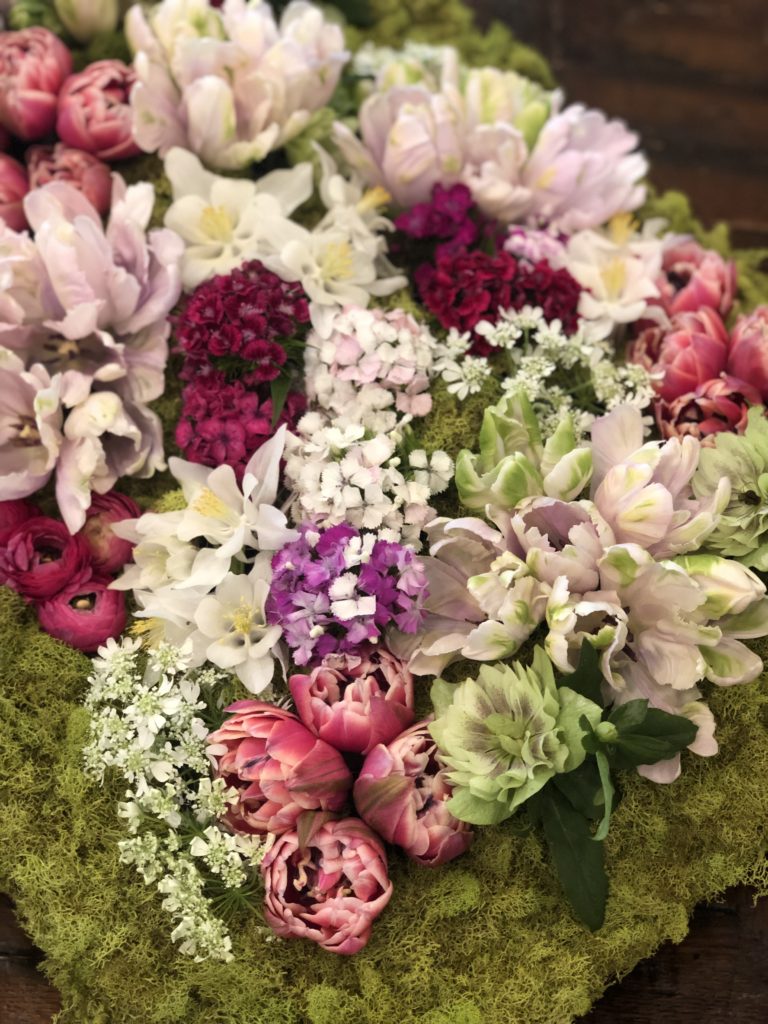
And clearly I was heard by all when I voiced my love of pink roses and peonies:


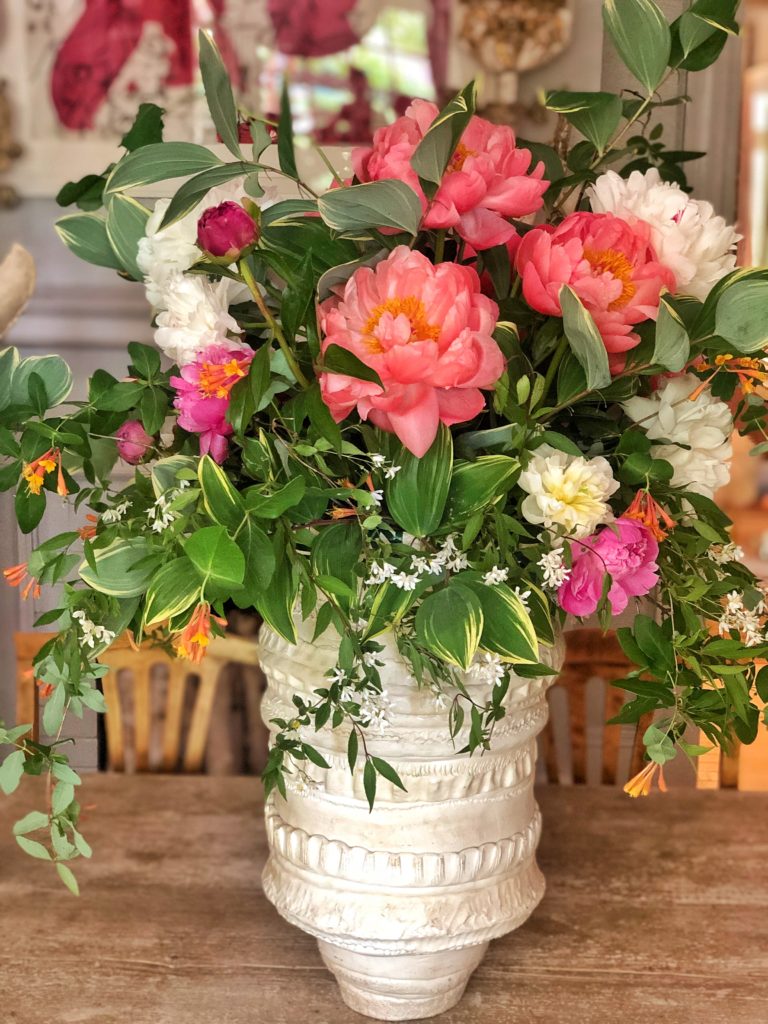
Garden Tour Day is highly civilized. My tireless landscape team was there at daybreak dead-heading and blowing the terraces.

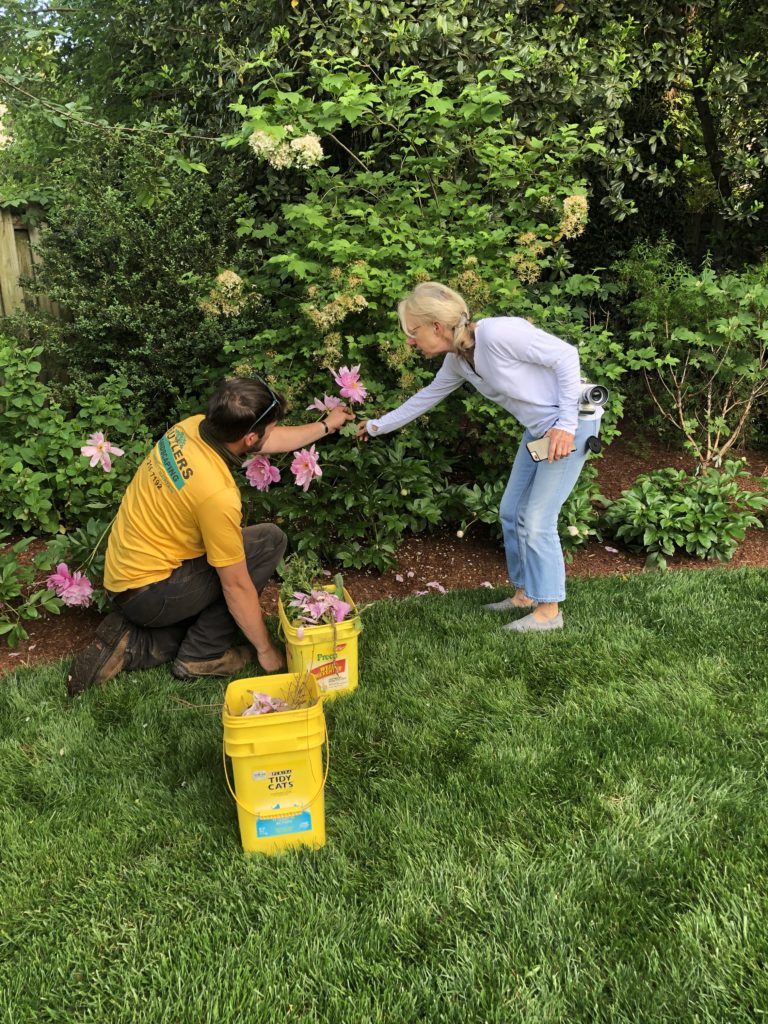
The Flower Ladies don’t forget the outside either….more beautiful flowers on my front porch:

Volunteers arrive at 9am to set-up and the tour runs from 10am until 5pm. Lines begin forming early and the event runs like a well-oiled machine so that by day’s end, thousands have enjoyed the tour.
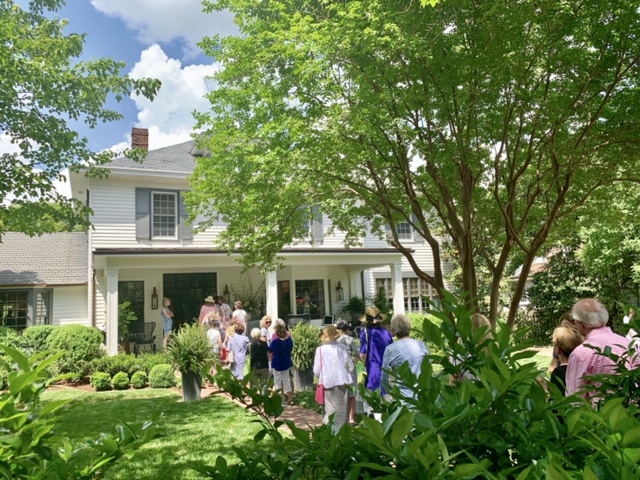
My client’s spit-spot facade and terrace on the morning of Garden Tour:
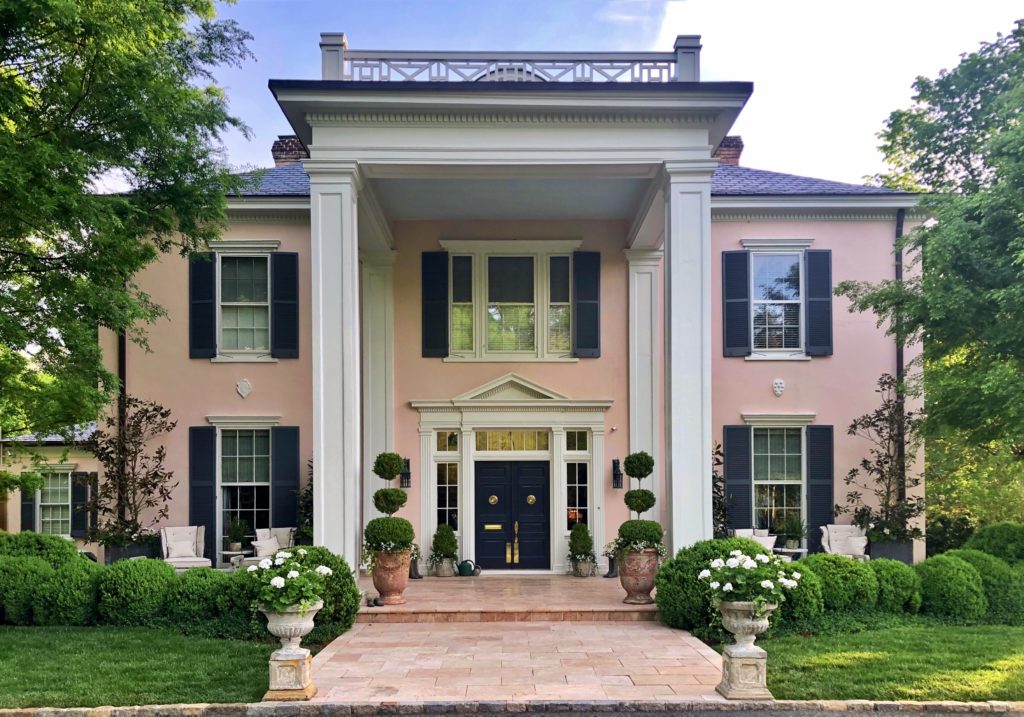

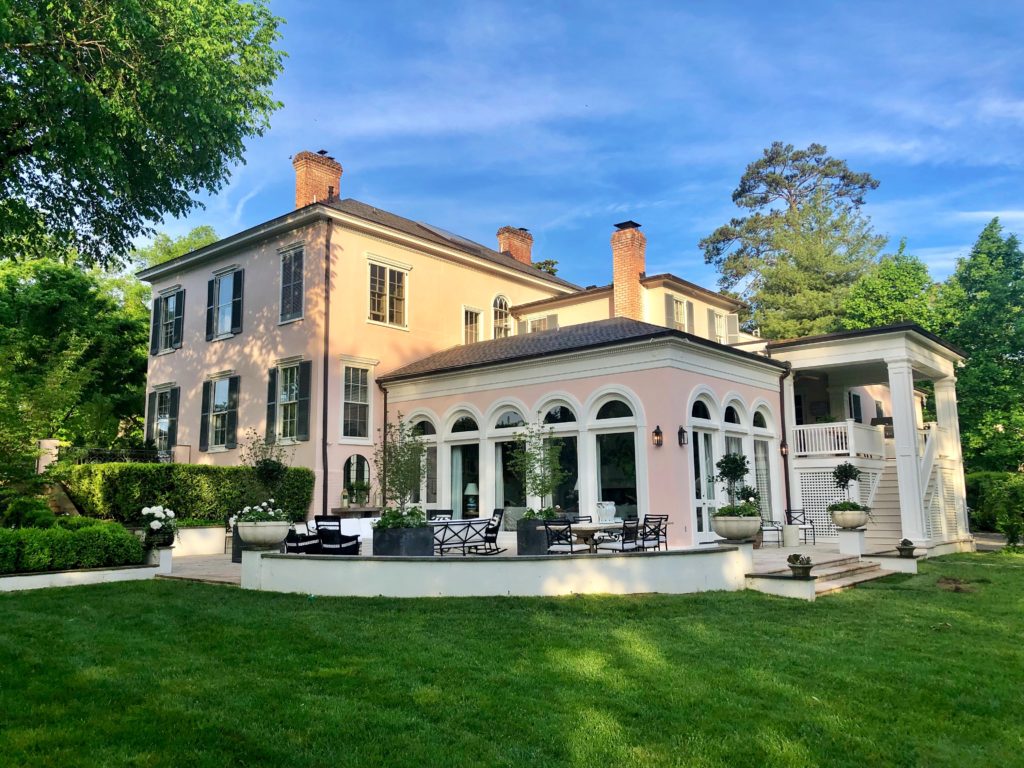

I snuck upstairs after the tour opened and enjoyed a hot bath, and later a celebratory wine lunch with my landscape designer 🙂

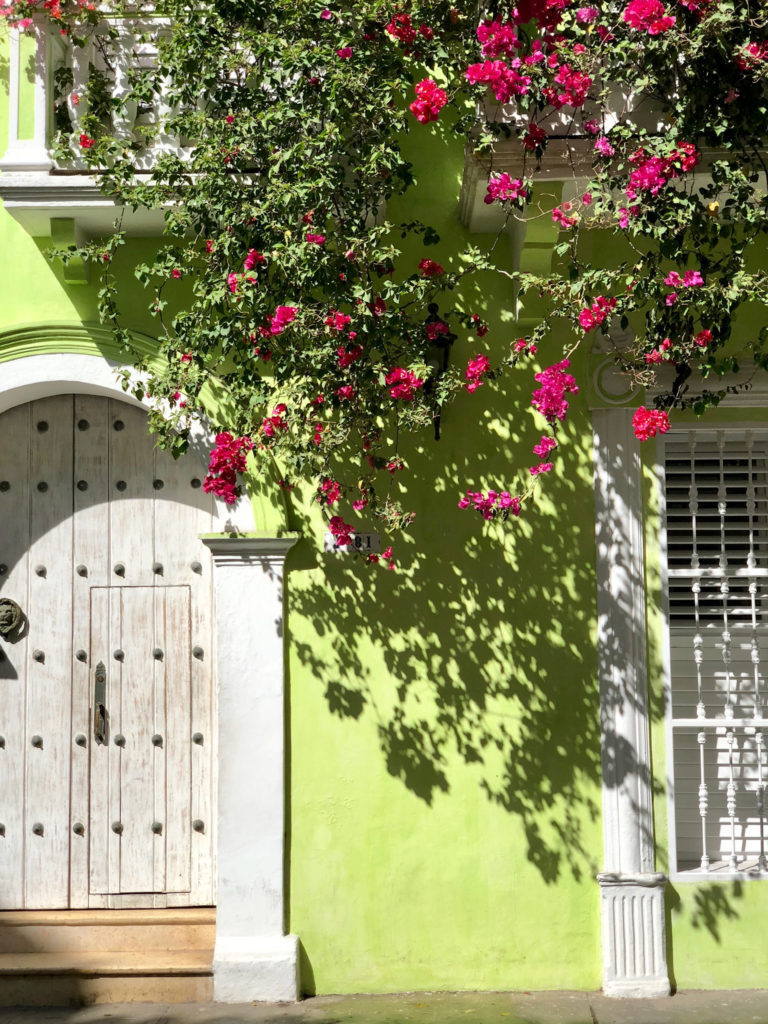
Sunny springtime weather has me flashing back to a favorite winter weather escape, Cartagena, Columbia. We visited just after Christmas and this beautiful coastal town was bustling with holiday revelers. The city was full of people but very manageable in that reservations for dining were easy to come by and shopkeepers were attentive and helpful. The vibe was festive and the people of Cartagena are warm and embracing. Encamped within Cartagena’s Old Town at the delightful Bastion Luxury Hotel (built on the site of a 15th-century house), we were perfectly located to explore the historic Old Town. We started our day with breakfast in the shady Bastion courtyard and then set out for our daily exercise routine, circling the walled city.

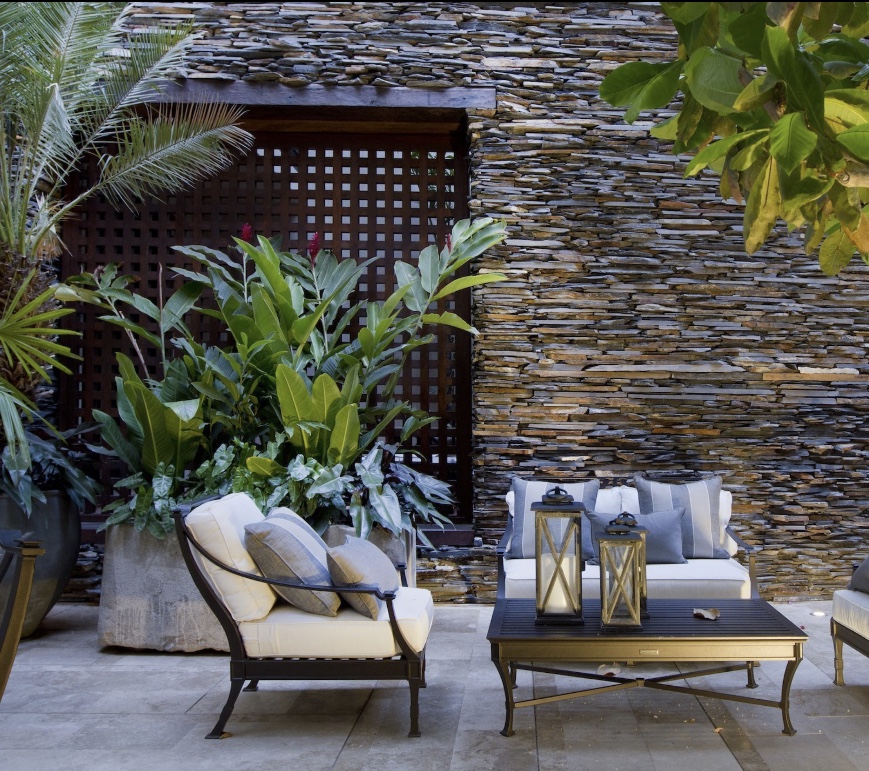
Walking along the top of the wall, about a 4km distance, is a great way to orient yourself to the Old Town and capture great views of the Caribbean Sea and the skyline of modern Cartagena. The wall itself and accompanying fortresses were built in the early 15th-century to defend the city against pirate attacks.
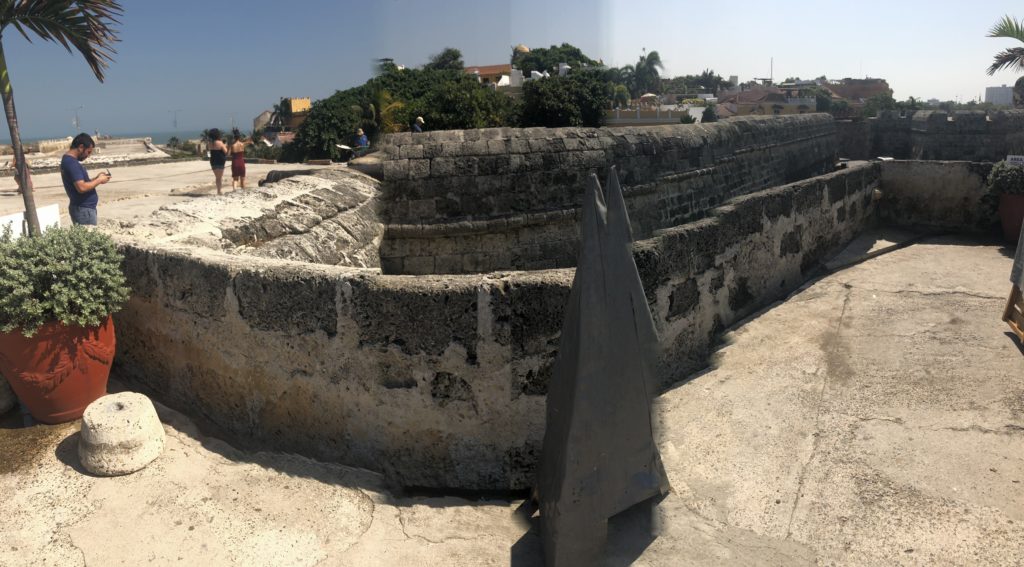
Step down from the wall and enter the gates of the city and you are immediately struck by the warmth of the people and the vibrancy of the the colors.
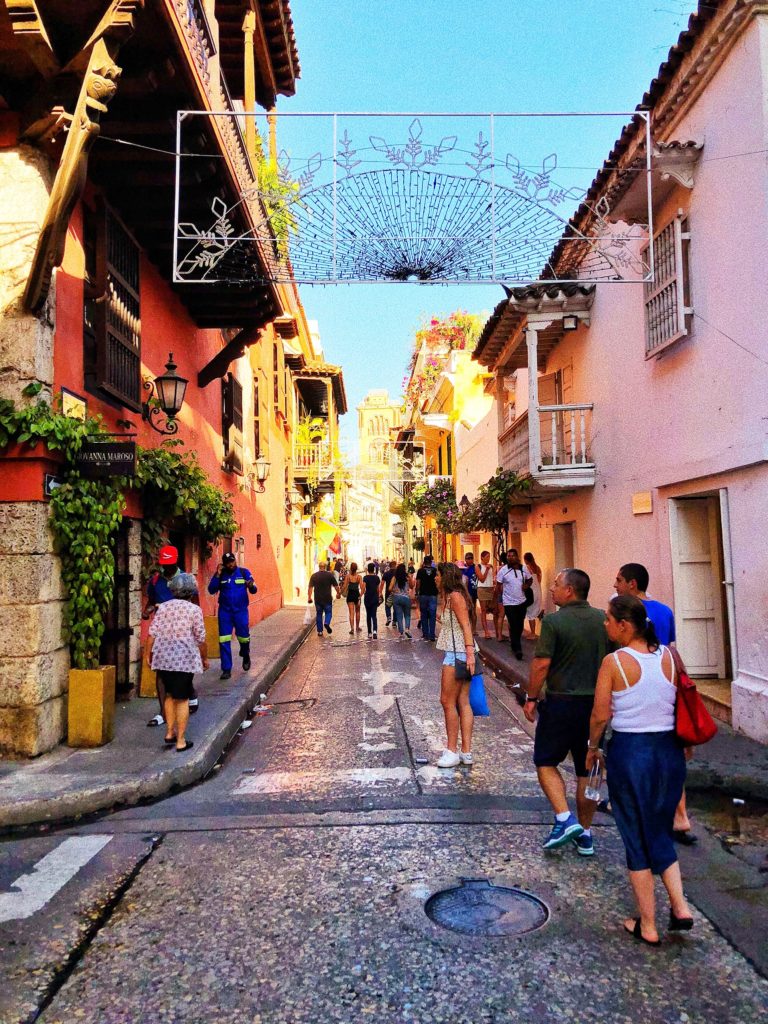
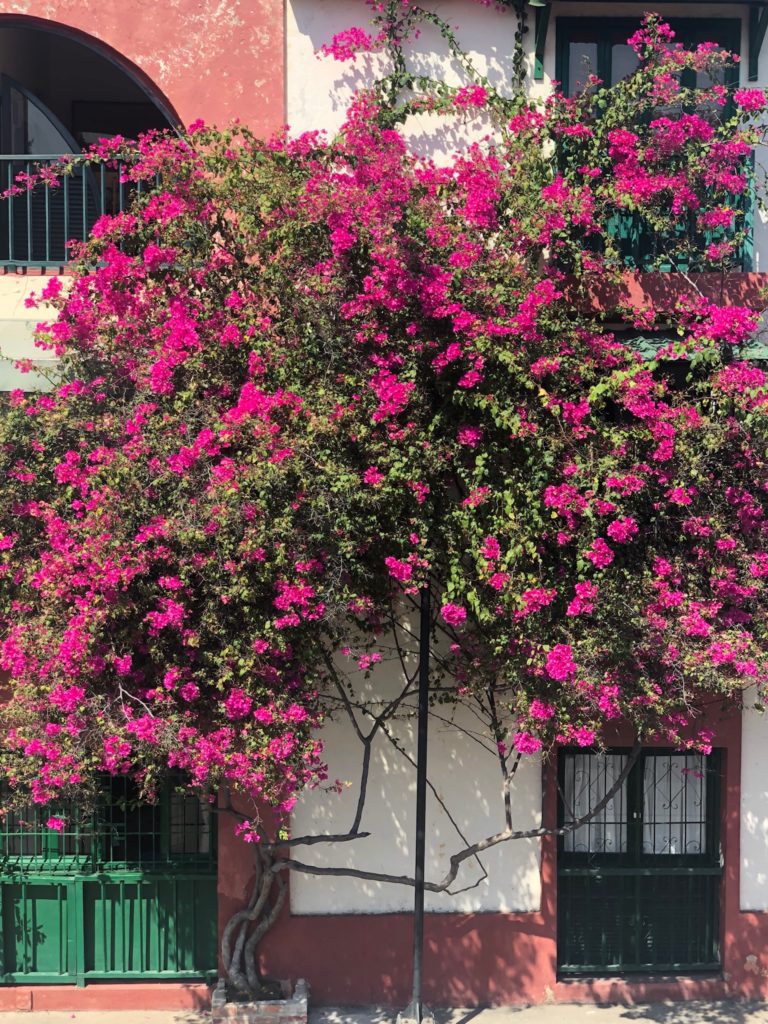
The exuberance of the Cartagenan people is never more present than in the facades and doors of their homes and businesses. Saucy colors and cheeky combinations are the order of the day. I was completely taken with the bravado of the people and their bold use of color.
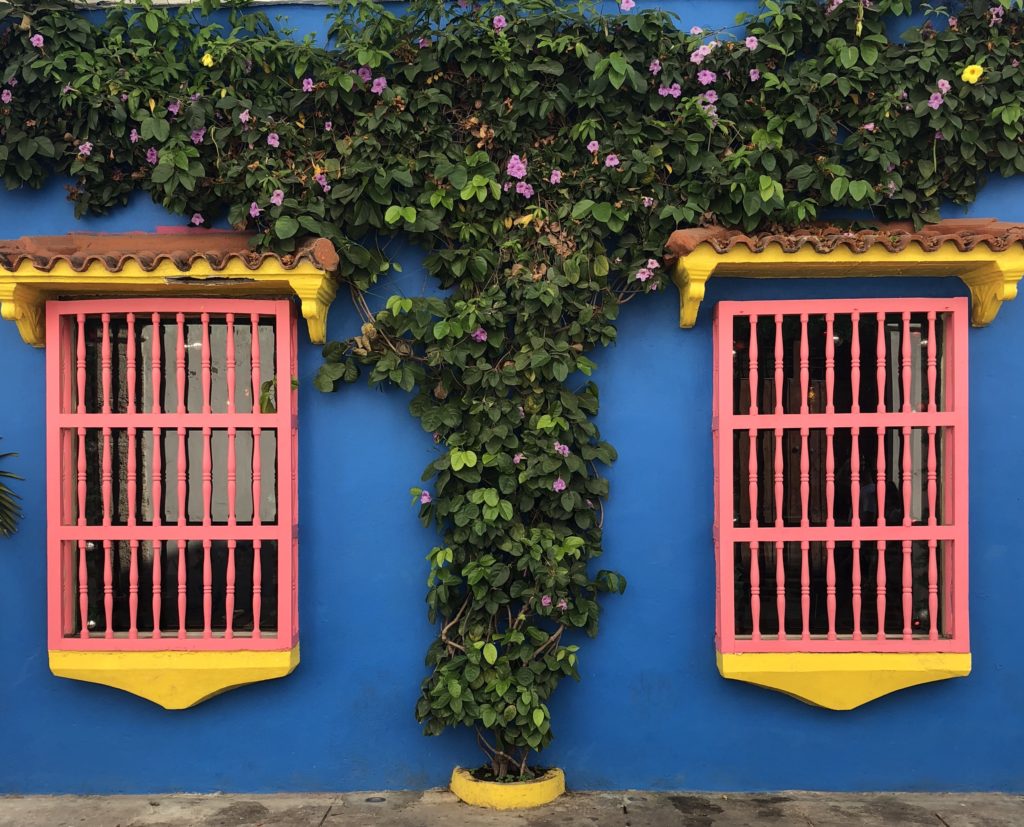
Attention jewelry lovers: Fabulous options abound for contemporary gold jewelry and don’t miss a stop at Cano for sculptural cuffs and earrings.
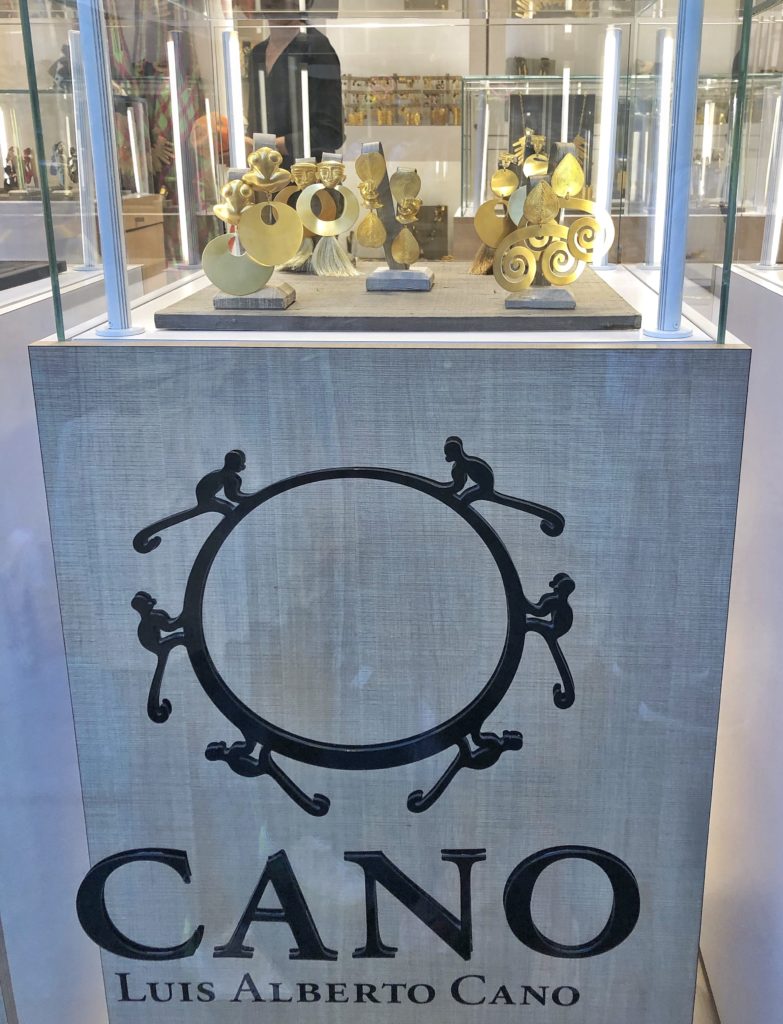
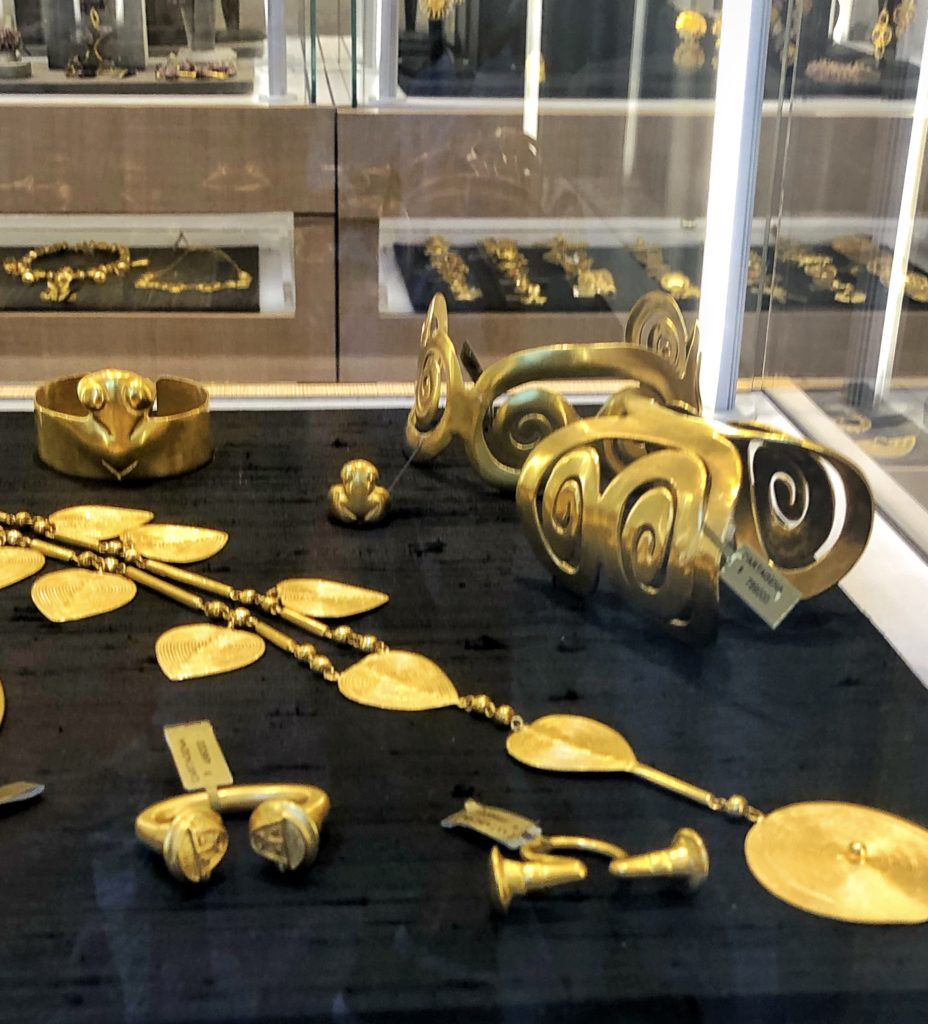

Our favorite boutique, St. Dom, requires a deep dive and an extended stay in the dressing room. With an eclectic array of clothes, jewelry, art and accessories, St. Dom features over 100 Columbian designers including Johana Ortiz’s spectacular shop-in-shop.
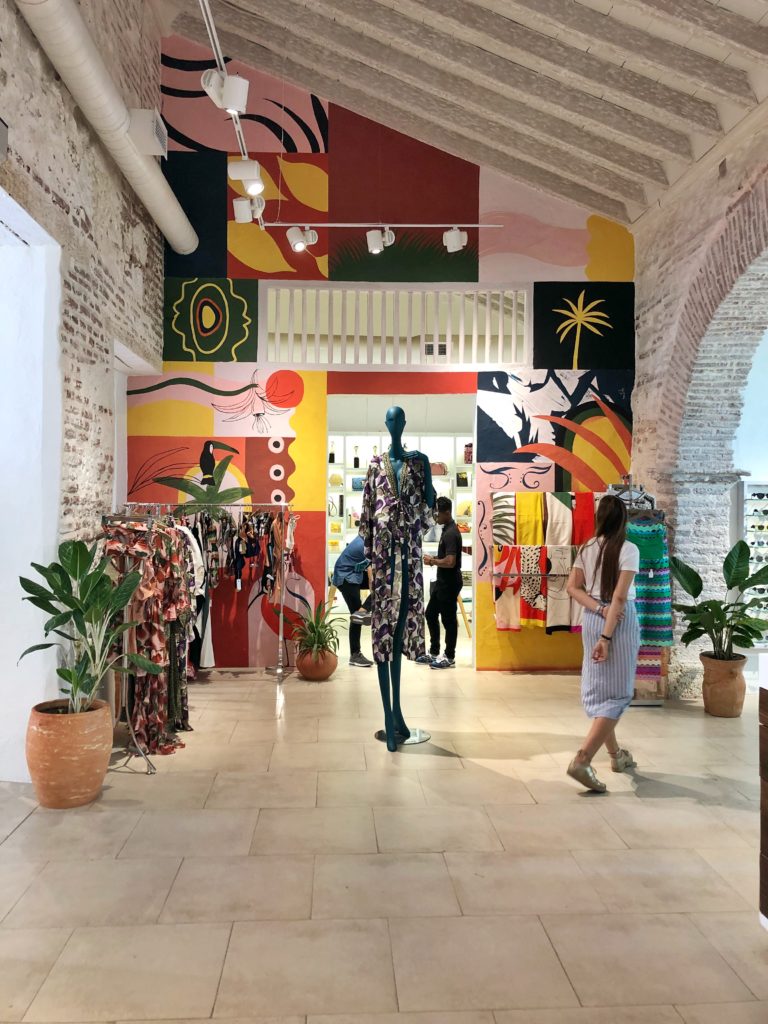

Next stop is lunch at Lobo De Mar for icy margaritas and guacamole followed by tuna ceviche.
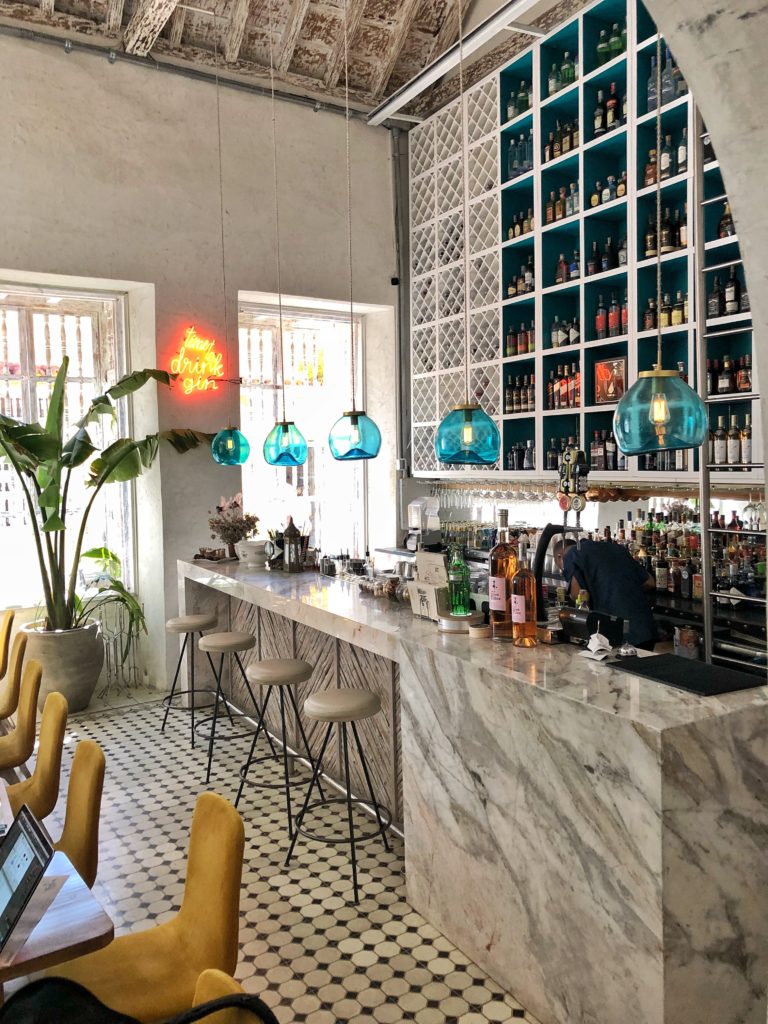

While most shops remain open, the traffic in the afternoon in the Old Town slows as the heat increases and we returned for a while to take advantage of the Bastion’s rooftop pool with gauzy-draped perches ideal for a siesta.
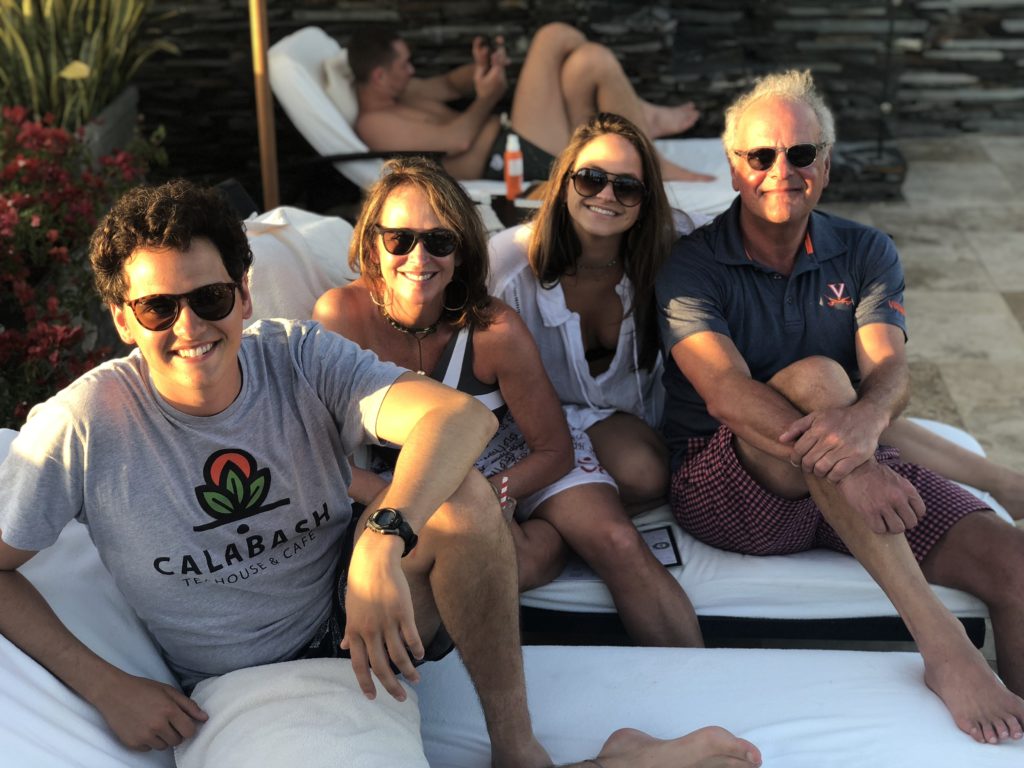
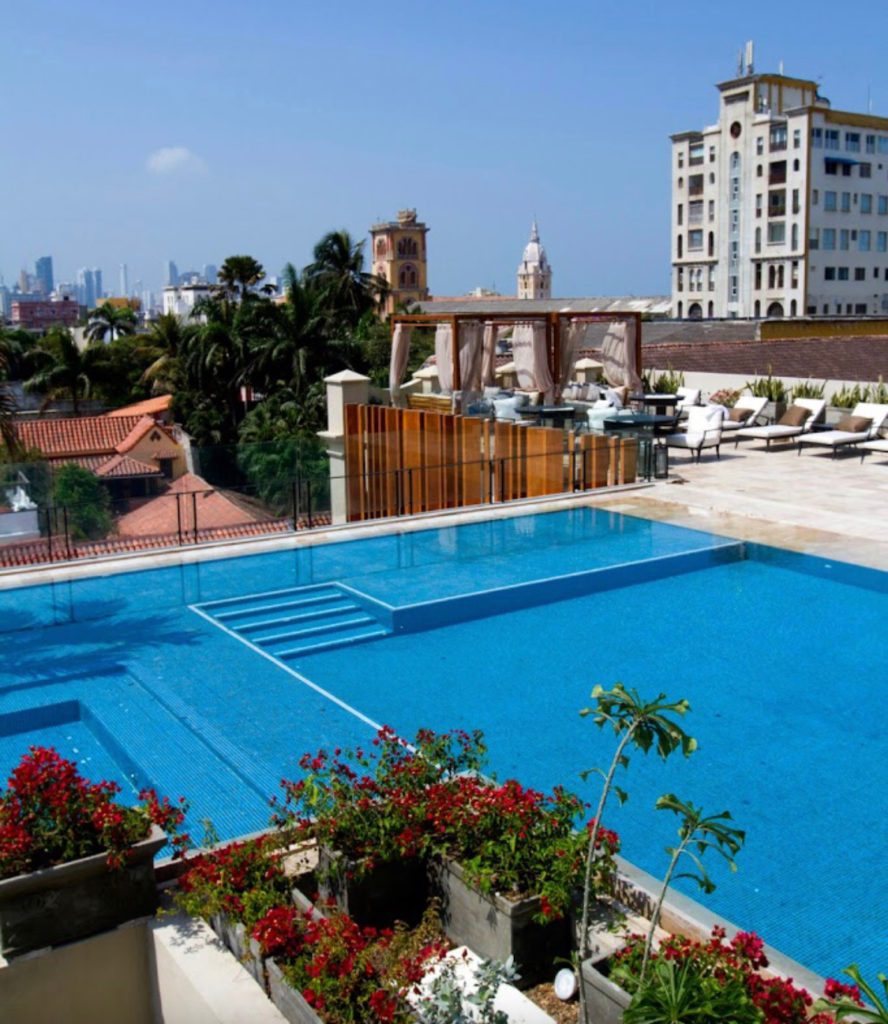
The poolside burrata salad at The Bastion…

We hit the streets again landing at the fabulous home emporium Casa Chiqui. A feast for the senses for this designer, Casa Chiqui, is stocked to the brim by it’s owner, Columbian socialite Chiqui de Echavarria, and is filled with gorgeous tableware, furniture, embroidered textiles, Columbian woven baskets, clothing, and jewelry.

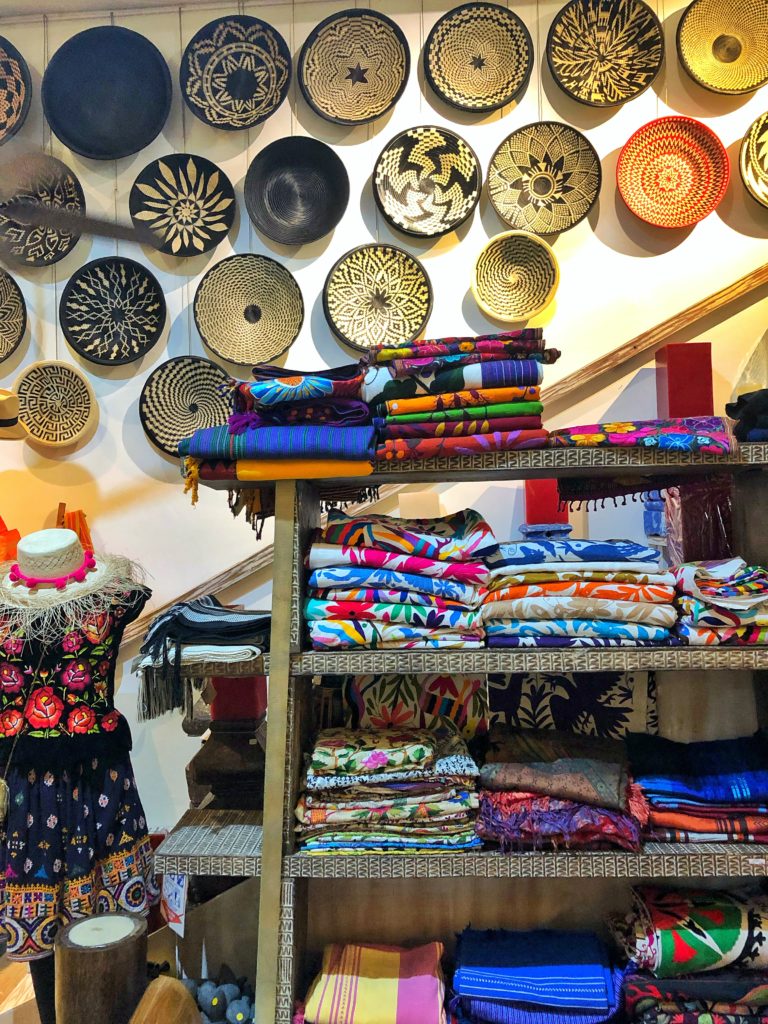
One of each please!

…and then more doors.

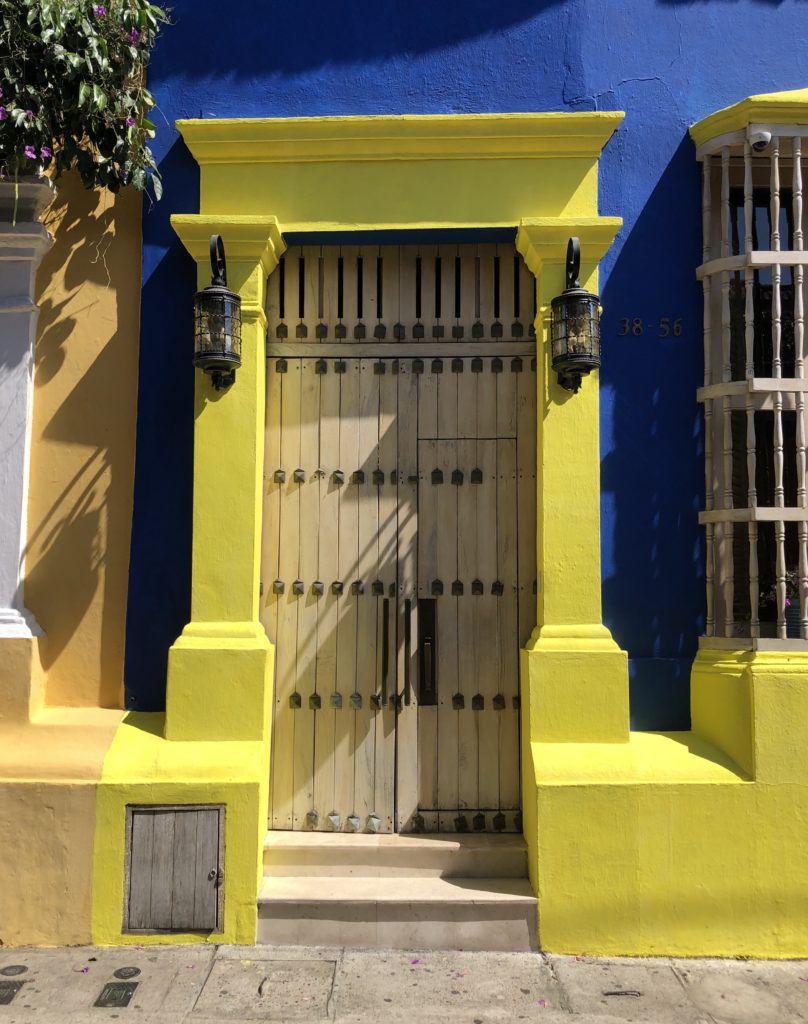

There are even doors within doors:
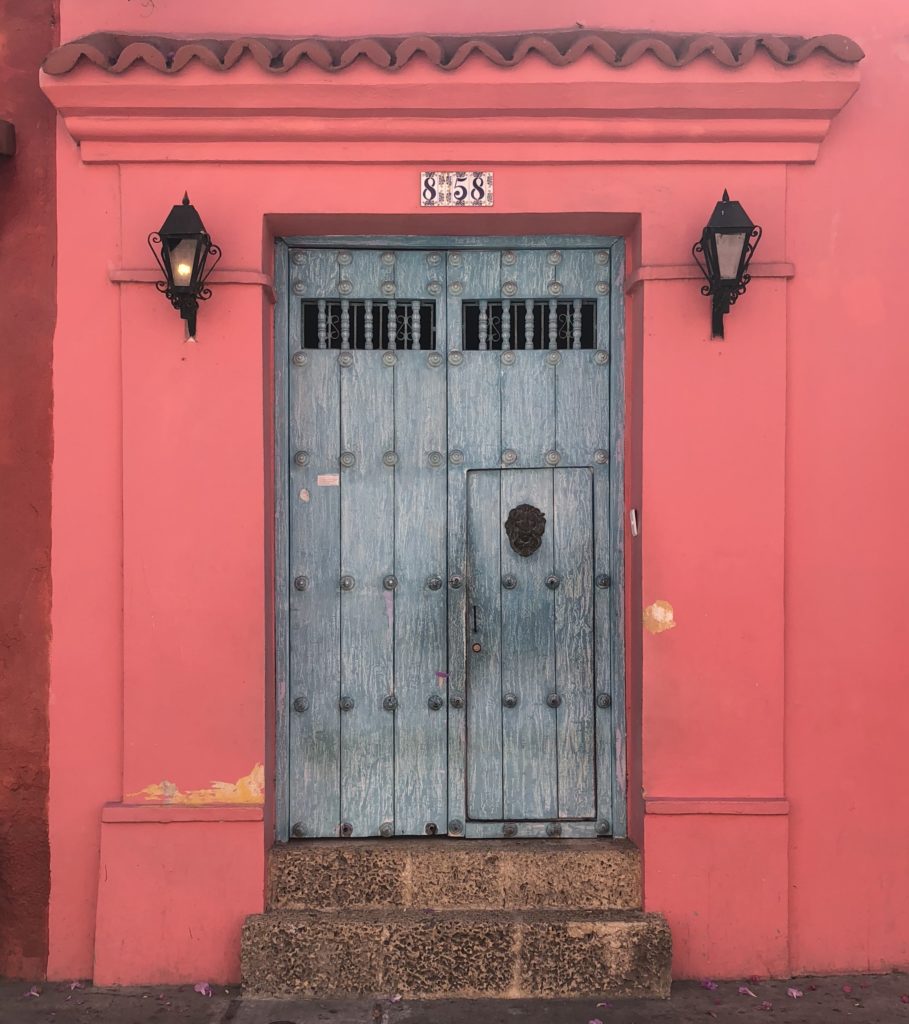

Fabulous doors are often dressed with even more fabulous door knockers… the design giving a clue as to the profession of the resident, in this case, a fisherman.
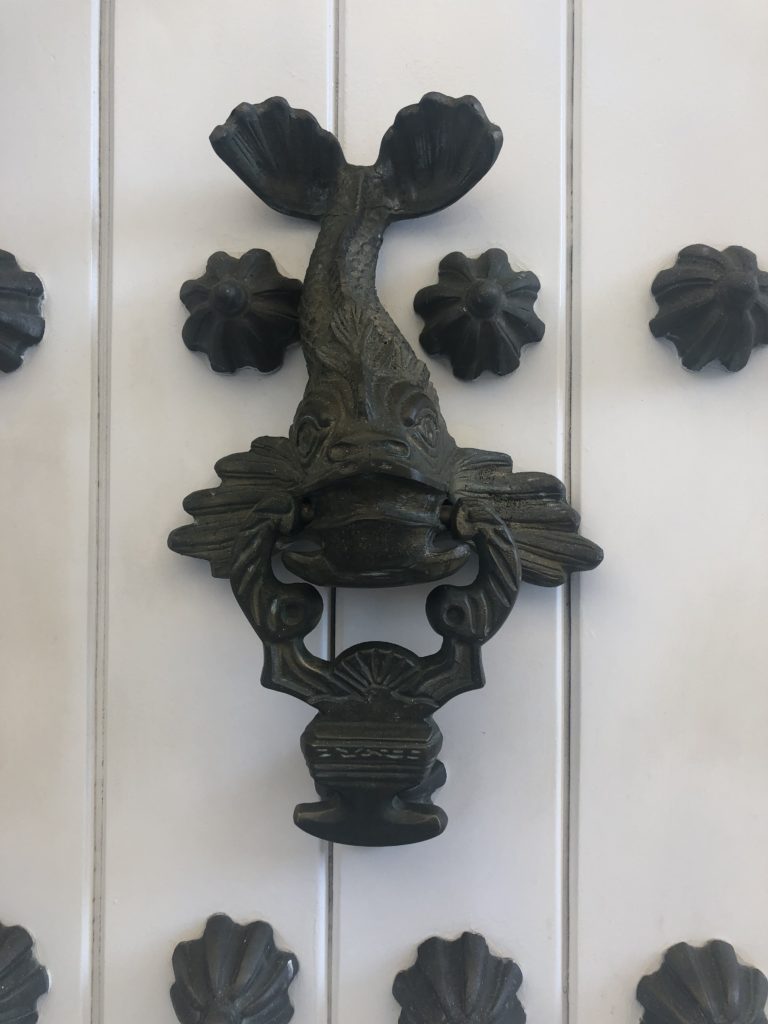
One of the best dinner spots in Cartagena is unquestionably El Gobernador “The Governor”, located at the Bastion. In the coziest of dining rooms, we dined on native delicacies like lionfish and their signature dessert “Coco Loco”.
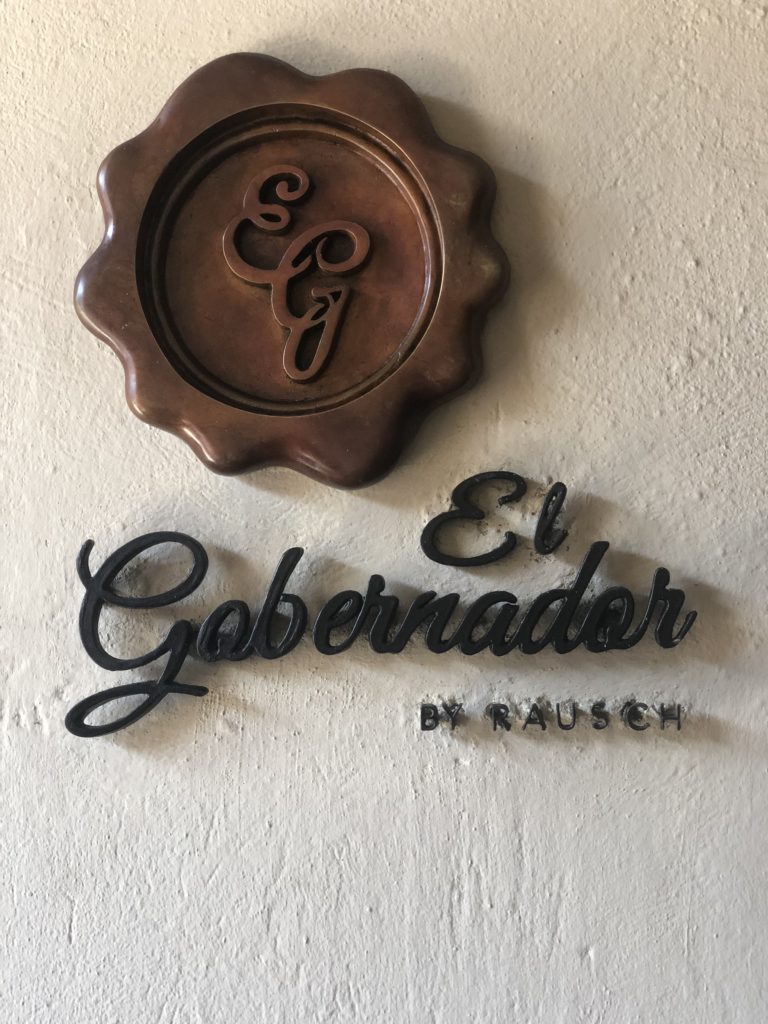
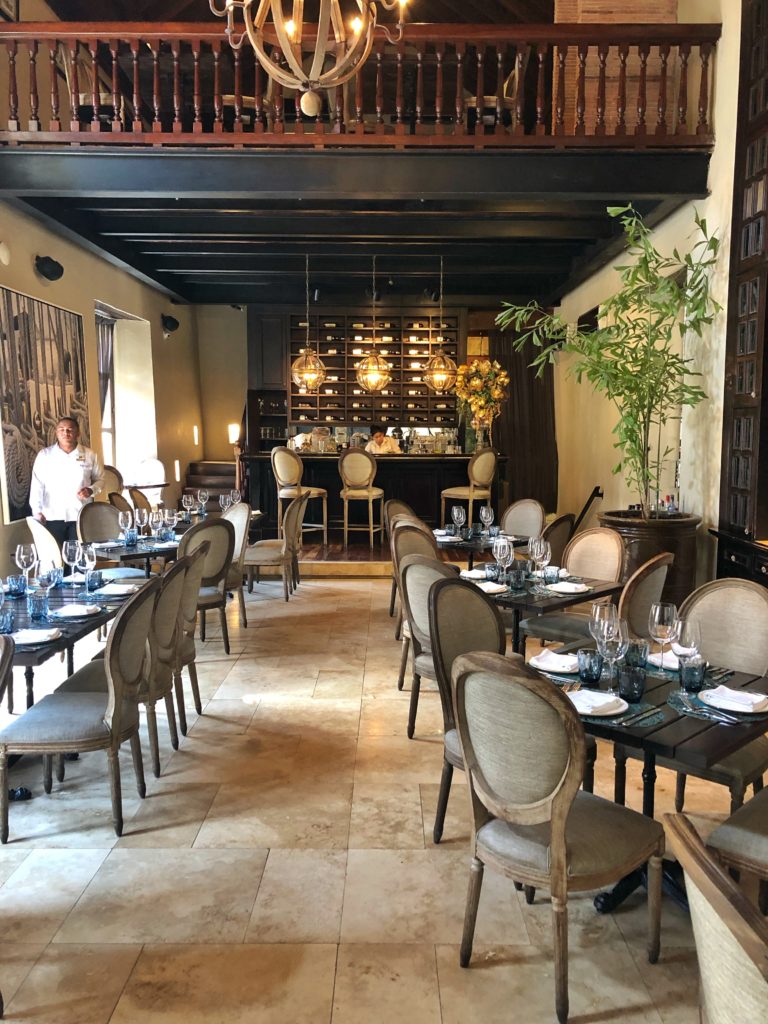
The best nightcap of all…some late-night star gazing back at the Bastion rooftop.
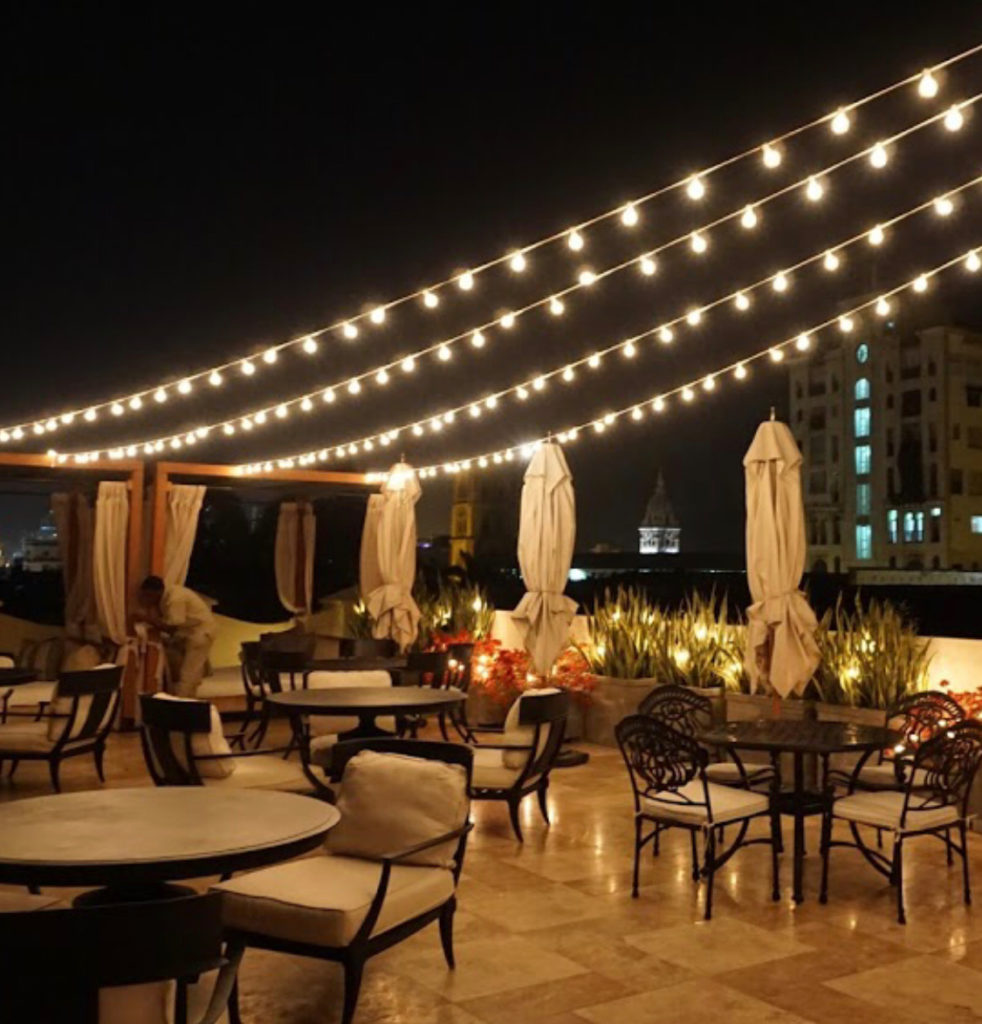
Goodbye beautiful Cartagena until next time 🙂

Janie is just back from a trip from Charleston, S.C., where she was invited to participate in Southern Style Now 2018, a multi-day festival celebrating Southern design. The festival included keynote speakers, panel discussions, cocktail and dinner parties, exhibitions, and a Showhouse sponsored by Traditional Home. As one of the many fabulous events, Janie spoke on a panel about her love of fabrics and emerging fabric industry trends with five other leading design professionals
.
Read below the Southern Style Now team’s interview with Janie:
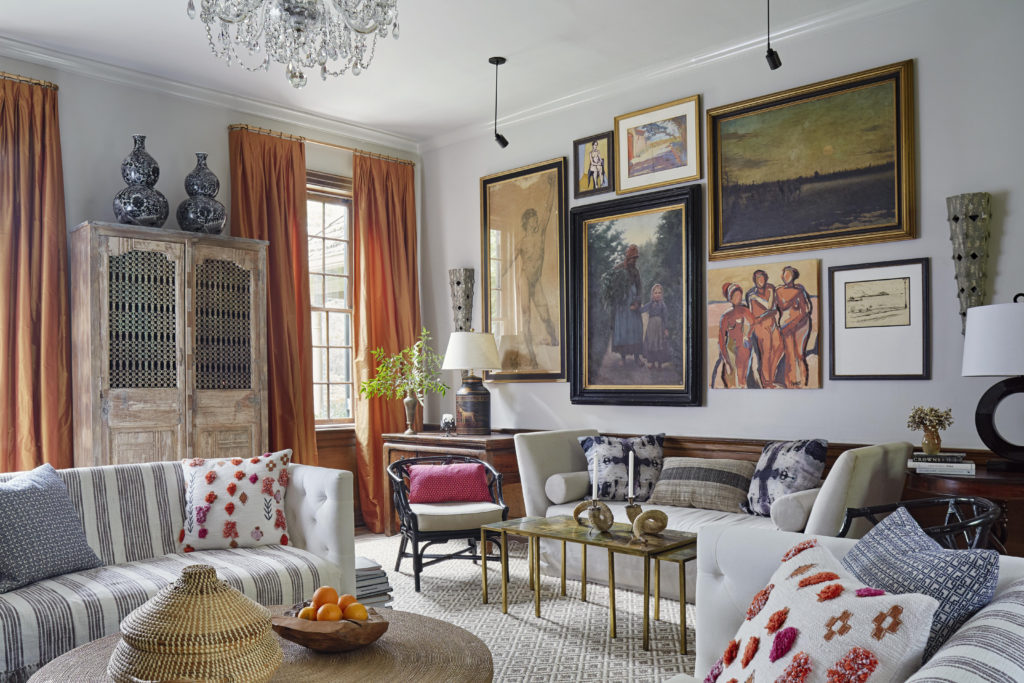
Q: What does “Southern Style Now” mean to you?
Southern Style Now reflects the unique perspective that our premier designers, architects, artists, and craftsmen have in reinterpreting the influences of our Southern heritage in novel and inventive ways. It’s a look, a feeling, a vibe, and a sensibility of something fresh and old, timeless, and of this very moment.
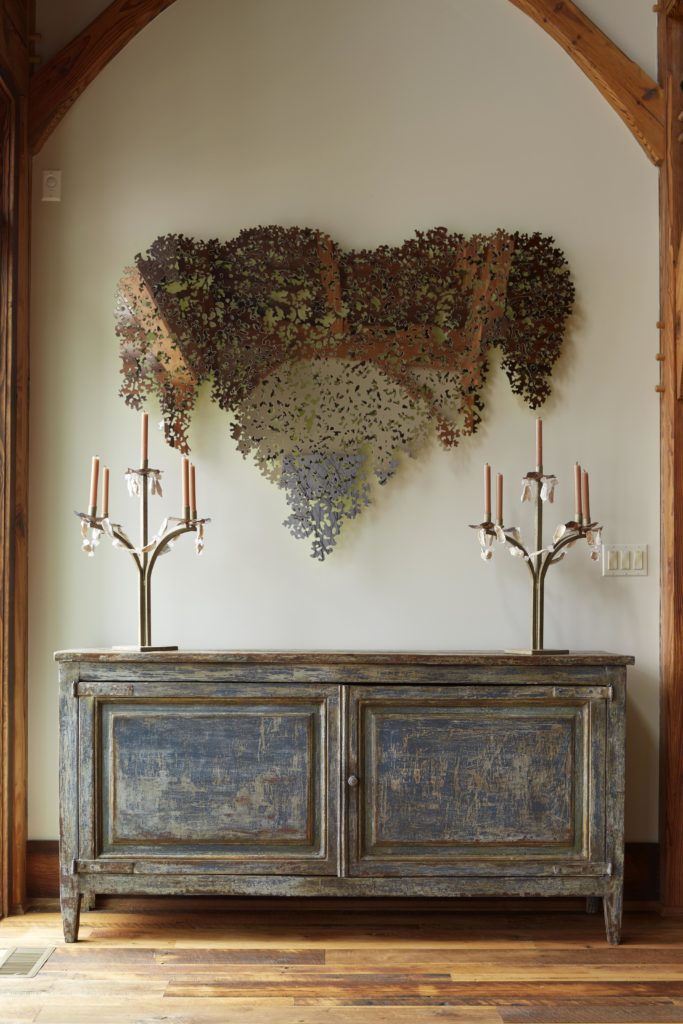
Q: Can you see a thread of Southern influence into the work of certain designers? If so, how does it display itself?
Gathering is a word that comes to mind when I think of Southerners, and making our interiors work for that goal is a thread through much of Southern design. We gather people, hence our porches are wide and deep for rocking chairs and conversation. Because we love to gather family and friends, entertaining in our homes is a way of life. We prioritize creating interior spaces that are comfortable and always presentable for “company”. We gather our possessions in such a way that our interiors often present as curated collections, gathered carefully over time.
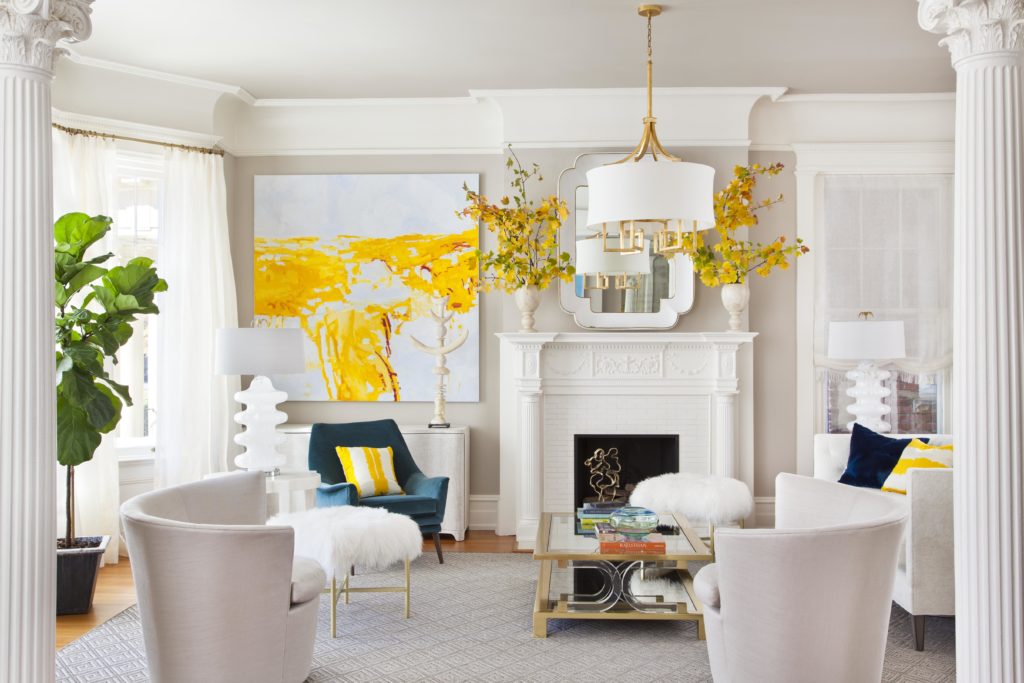
Q: Finally, do you have a favorite Southern Style Now (Festival or Showhouse) anecdote that you can share with us?
Julia Reed’s keynote speech last year in Savannah had me apologizing to those around me for my raucous laughter. She is a walking testament to our quirky Southern perspective and how we love to laugh at ourselves most of all.
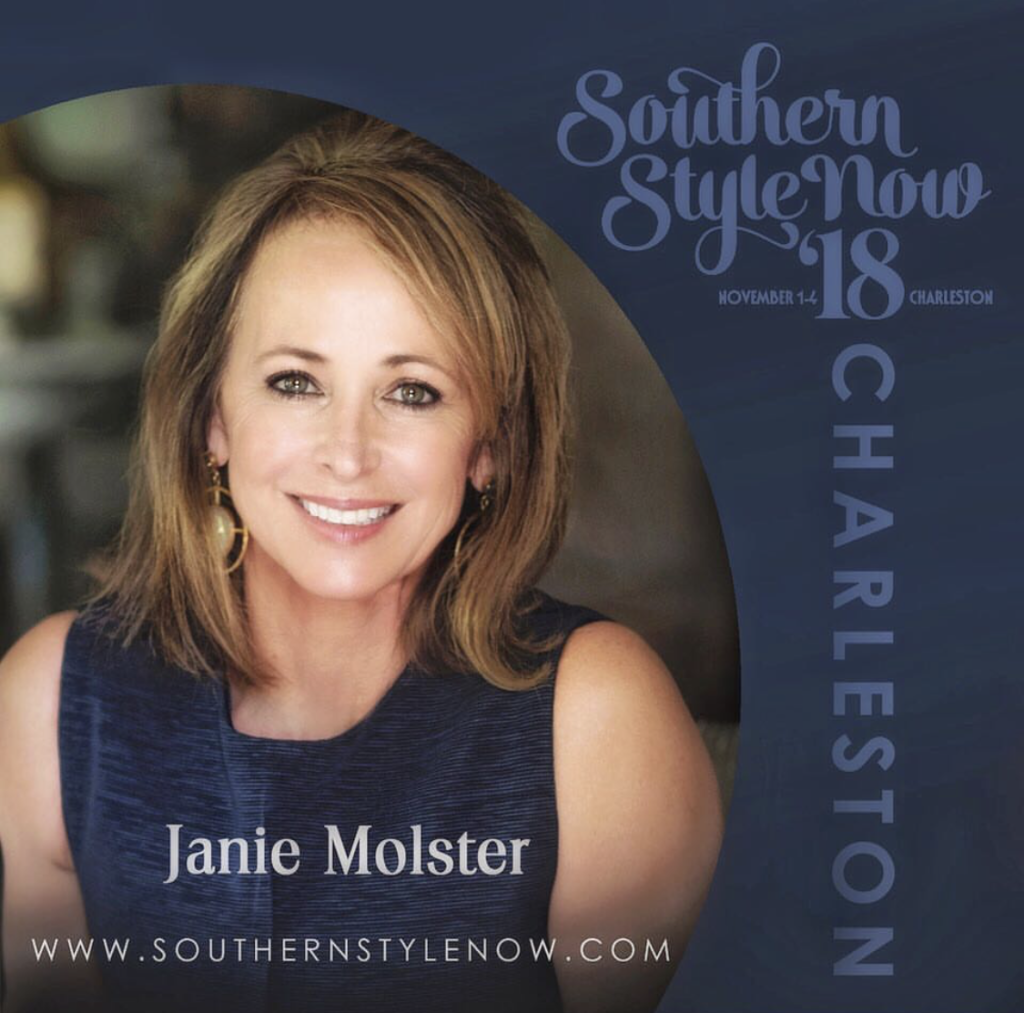
Organizing and displaying collections takes careful thought. I always encourage clients to group whatever they are collecting en masse. It is visually stronger and more interesting to display a group of similar items in relation to each other. Most anything can constitute a collection. I rotate my own collections which range from sort-of special to especially loved. On a walk through my house one would find collections such as a grouping of sculptures by a favorite New Orleans artist (Julie Silvers), my children’s primitive pottery, a wall covered with brown transferware, old family sepia-colored photos, and last but best, 15 odd pairs of my boy’s very worn toddler-sized red Keds sneakers. I have them tied all together as a vertical hanging sculpture.
We recently worked on a project where the client had several wonderful collections but they were scattered throughout the home. On this wall we reorganized a graphic collection of botanicals by South Carolina artist, Becky Davis.
In this Nantucket Inn, we gathered up a collection of woven lightship baskets and clustered them on a parlor desk.
Another way to group collections is in a color genre. In this foyer a collection of artwork in tones of black, white and grey creates harmony with a like-minded palette.
A Delft plate collection accented with Delft lamps and a Delft planter in a breakfast room. If you have a favorite stack of china hiding in a cupboard, consider grouping them in a fun design on an accent wall.
Collections don’t need to be costly to be loved. I am very attached to my dog-eared collection of coffee table books. I love how our client stacked her own collection. Coffee table book collection turned coffee table!
In researching our Marrakech hotel, El-Fenn, I’d heard it offered some excellent eye candy for decorator-types. It did not disappoint. Located within the walls of the medina, the hotel is made up of a series of connected riads with tucked-away courtyards, pools, and a rooftop garden with lounge dining, more courtyards, another plunge pool, and an amazing view of the Koutoubia Mosque. The melodic calls to prayer echoing from the Mosque became a comforting and centering reminder of where I was.
El-Fenn’s interiors are a feast for the senses with saturated wall colors treated in “tadelakt”, the Moroccan version of Venetian plaster. Furnishings combine the rich heritage of Moroccan crafts with a modern edge. When I entered our 3-bedroom riad with a glowing pair of fuchsia sofas, I knew I had found a soulmate in manager/designer Willem Smit, who cautioned that on a return visit, things may be different as he continually moves things around, edits, and perfects.
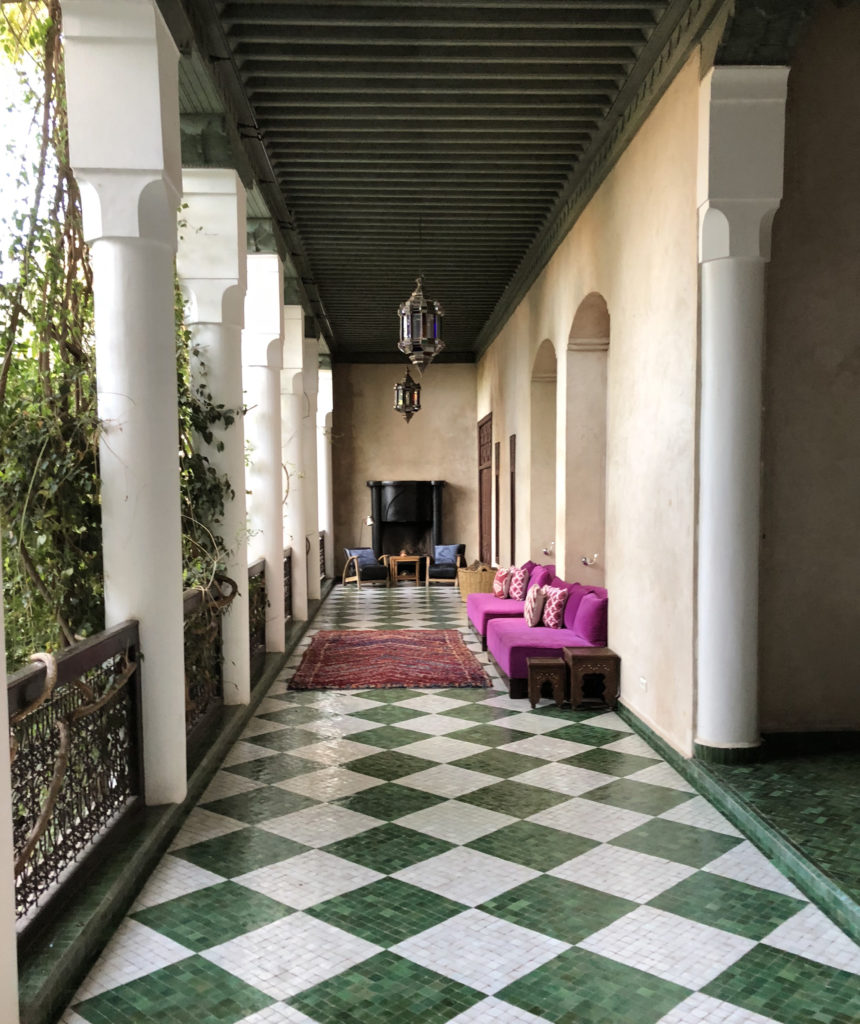
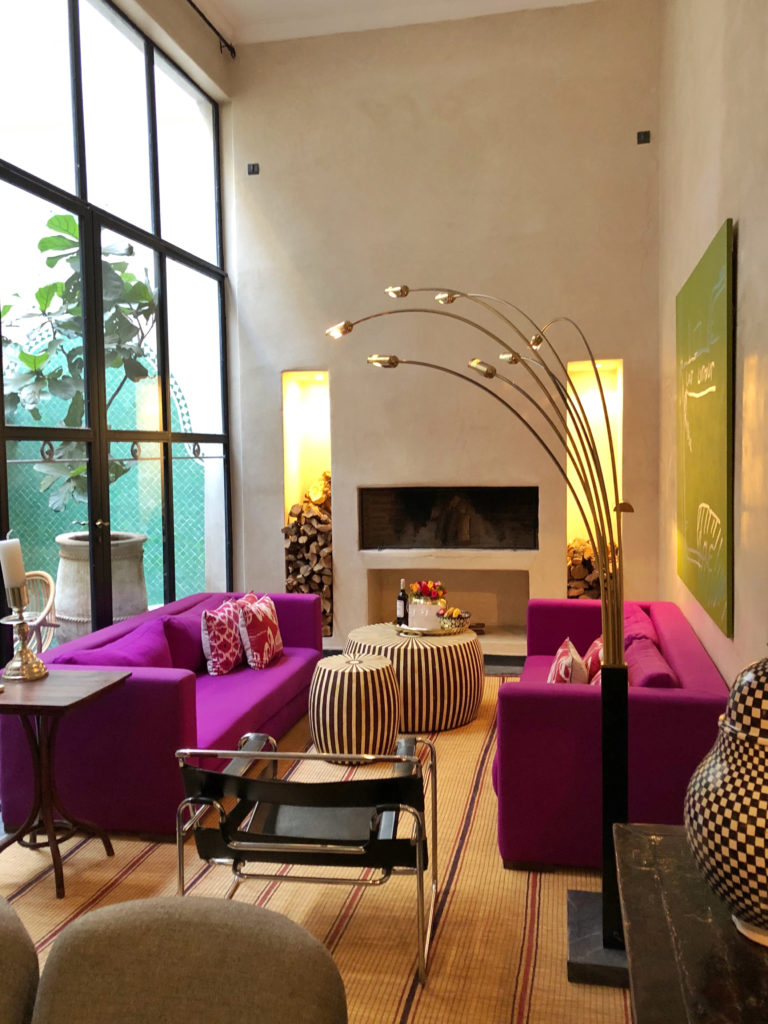
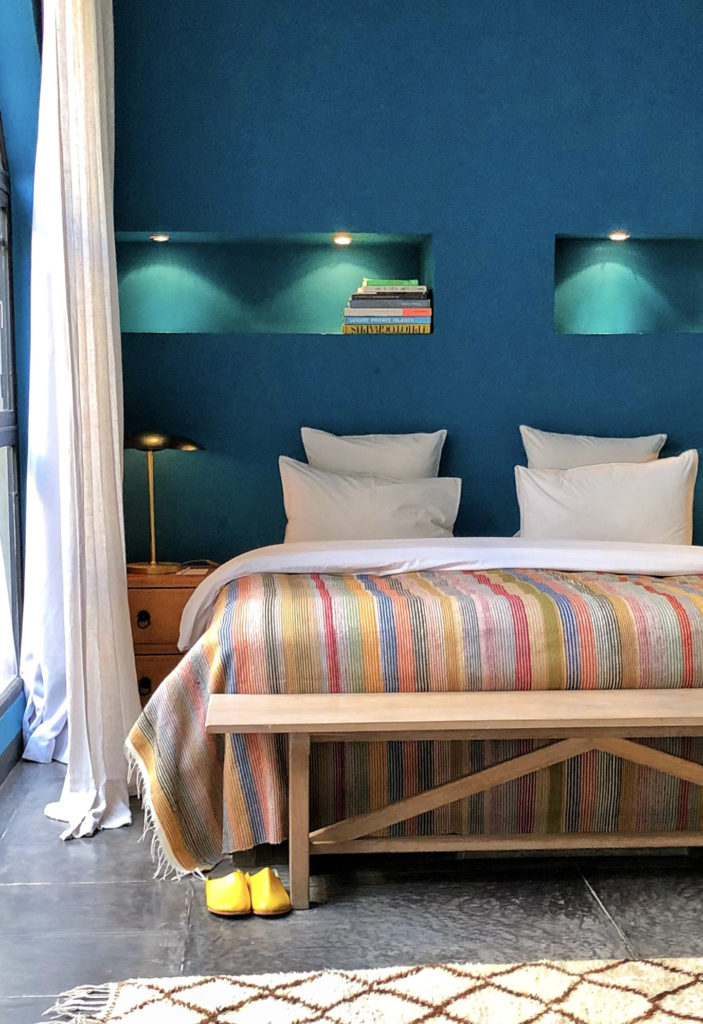
Our knowledgeable guide Youssef guided us through our first day in the Medina. A guide is strongly recommended on a first visit. A day in the souks will leave your senses in overload. There is vibrant color and craft, overwhelming chaos, aggressive vendors, motorbikes lurching through the crowded alleys, errant snake charmers, and a treasure trove of some of the most beautiful carpets, lighting, and textiles I have ever seen. When you open a map, many willing guides appear from nowhere to convince you to hire them. I learned to let myself be lost.
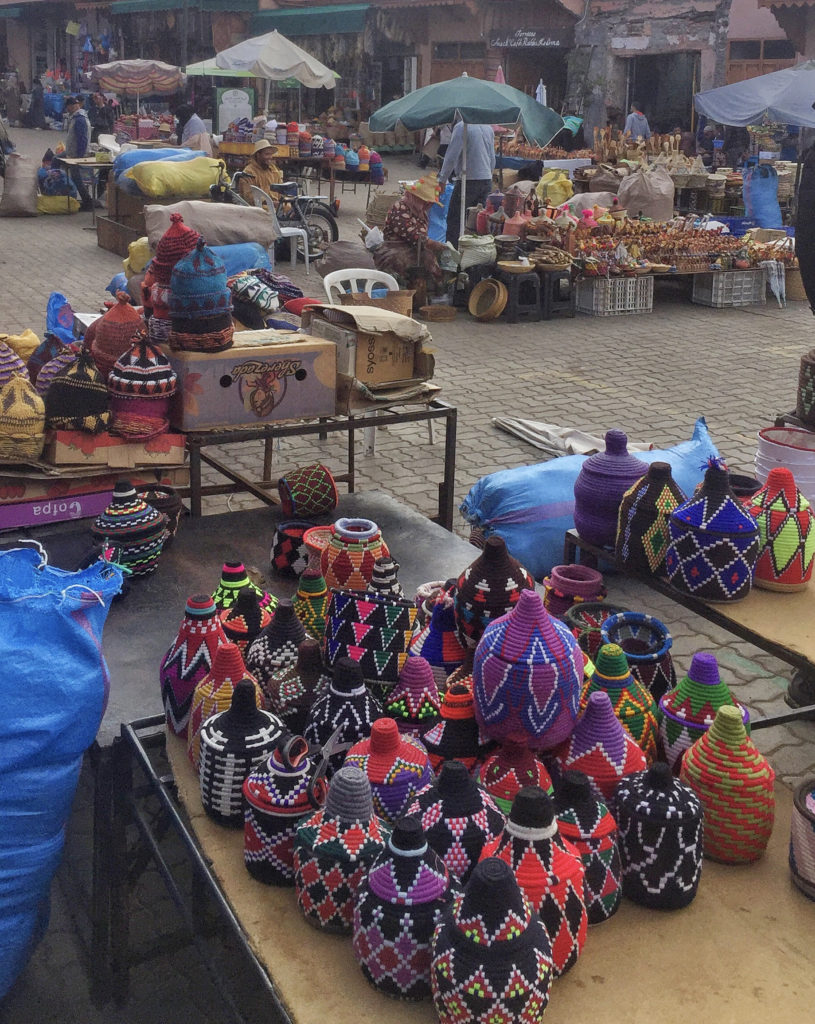
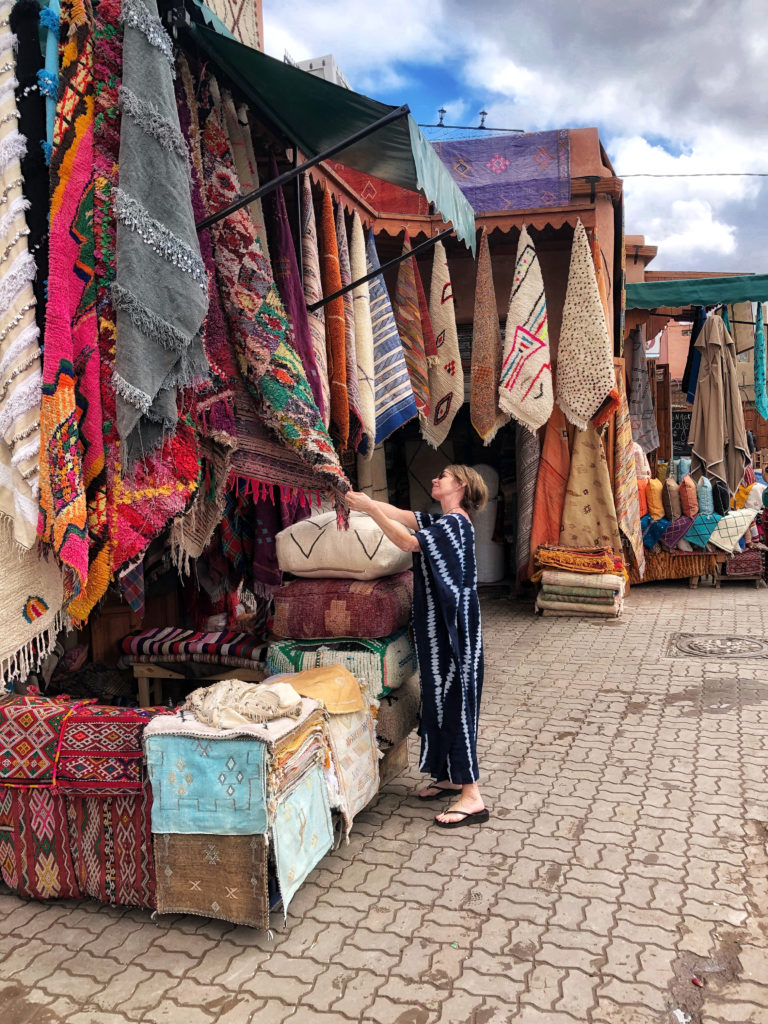
We established a rhythm of wandering the souks for half the day and then retreating back to the hotel to enjoy the laid-back El Fenn vibe. As your energy for souk bartering wanes, head to the fabulous on-premise gift shop. They offer a curated collection of Moroccan gifts and accessories that include pottery, textiles, and clothing. Most conveniently, it is adjacent to the charming red cocktail lounge, home of the signature El Fenn Fizz (gin, cucumber, mint, lime, & soda).
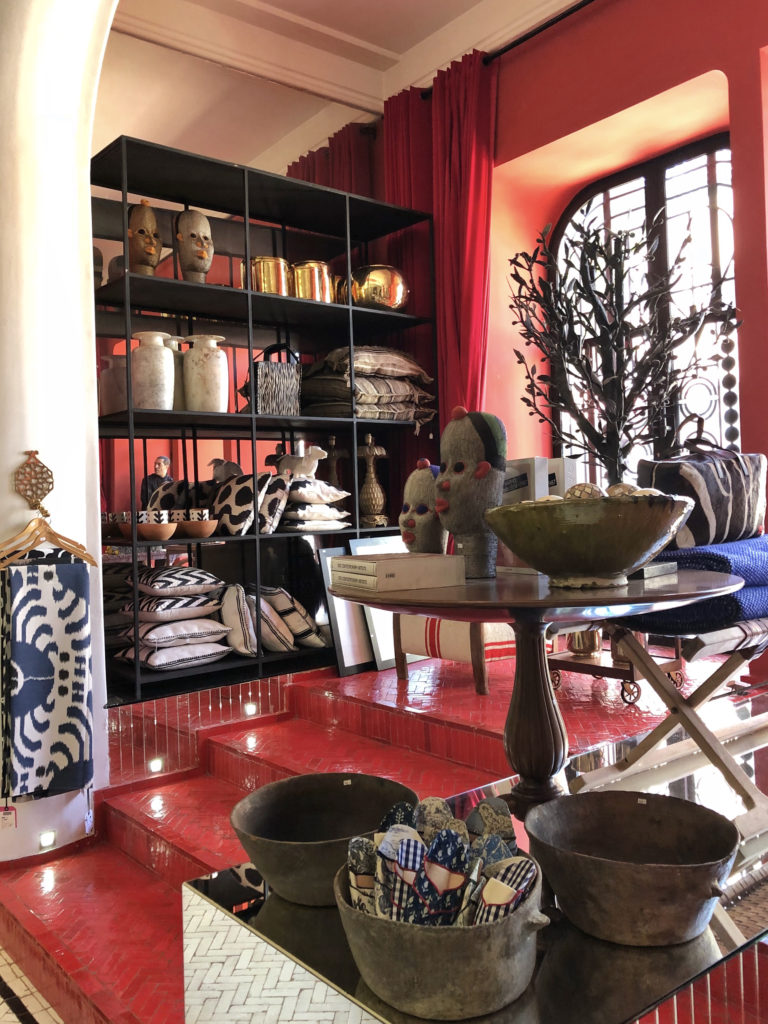


Mid-week we departed for a 2-day stay in the Atlas Mountains. Arriving in the small village of Imrill our bags were loaded onto burros for the hike to Kasbah de Toubkhal, a mountain lodge accessible only by foot. Simple, charming, and with panoramic views of the Atlas range, we enjoyed a welcoming Hammam (steam and massage with olive-oil based black soap), and a candlelit dinner of Moroccan salads and vegetable tagine. Our hikes were arduous but worth the effort as we trekked up, down, and through the mountains, often on goat trails and weaving through small villages.

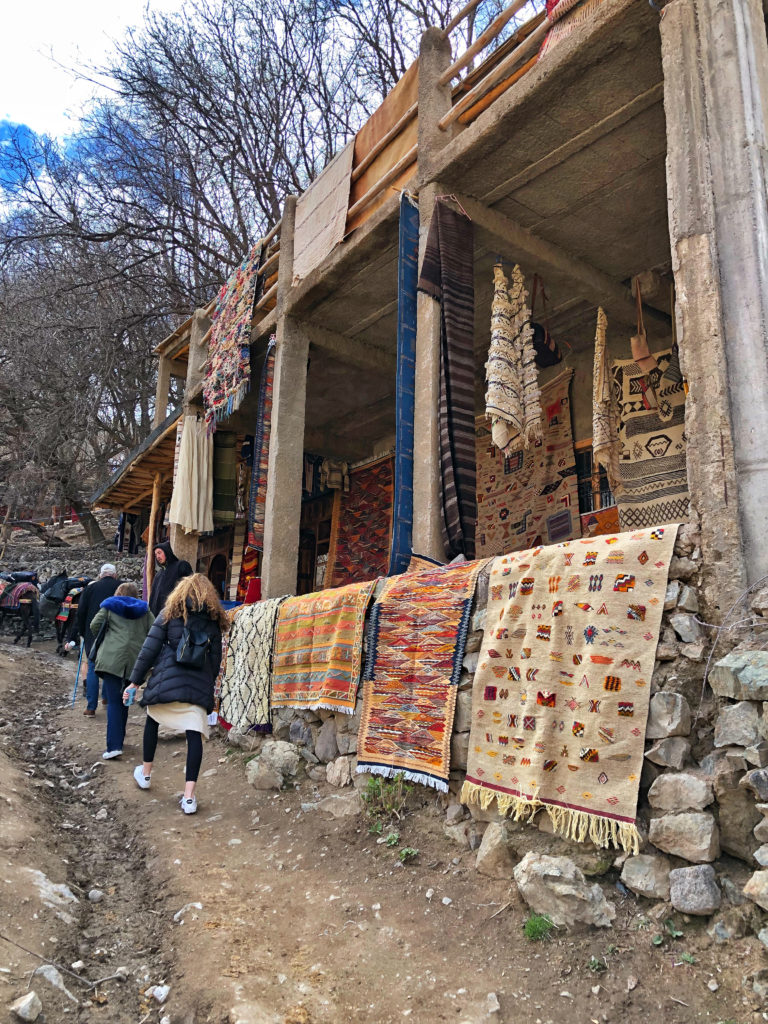


Ready for pampering after our rigorous trekking, we headed back to Marrakech and checked into the luxe environs of La Mamounia. Behind their pink walls, gorgeous gardens, pools, restaurants, lounges and luxurious guest rooms awaited us.
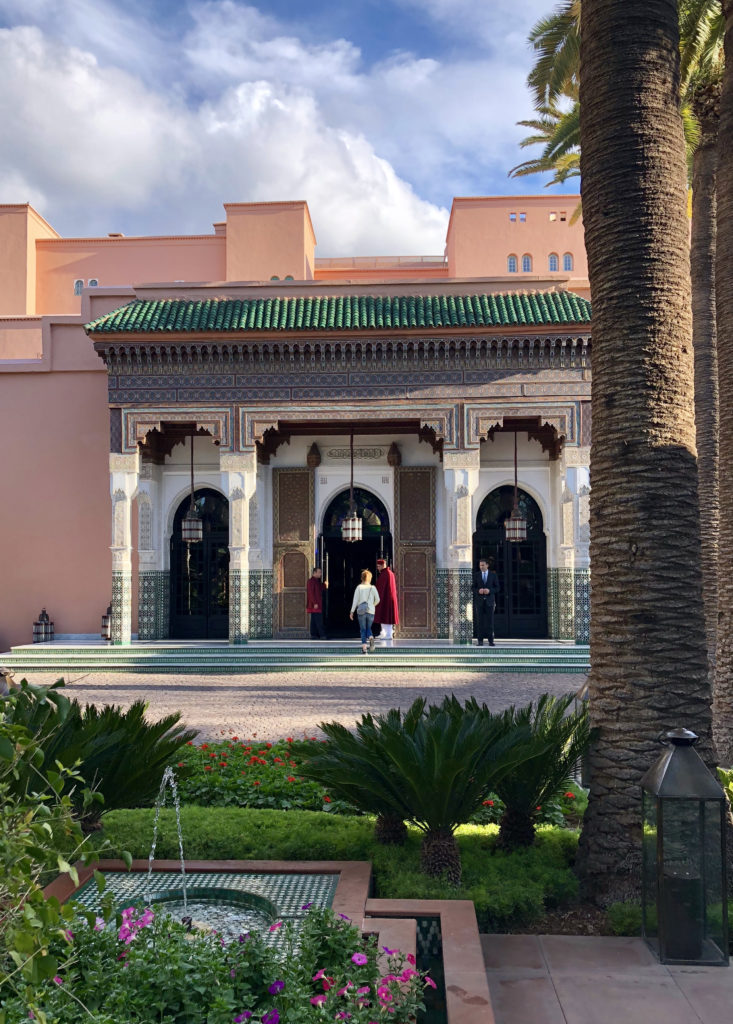
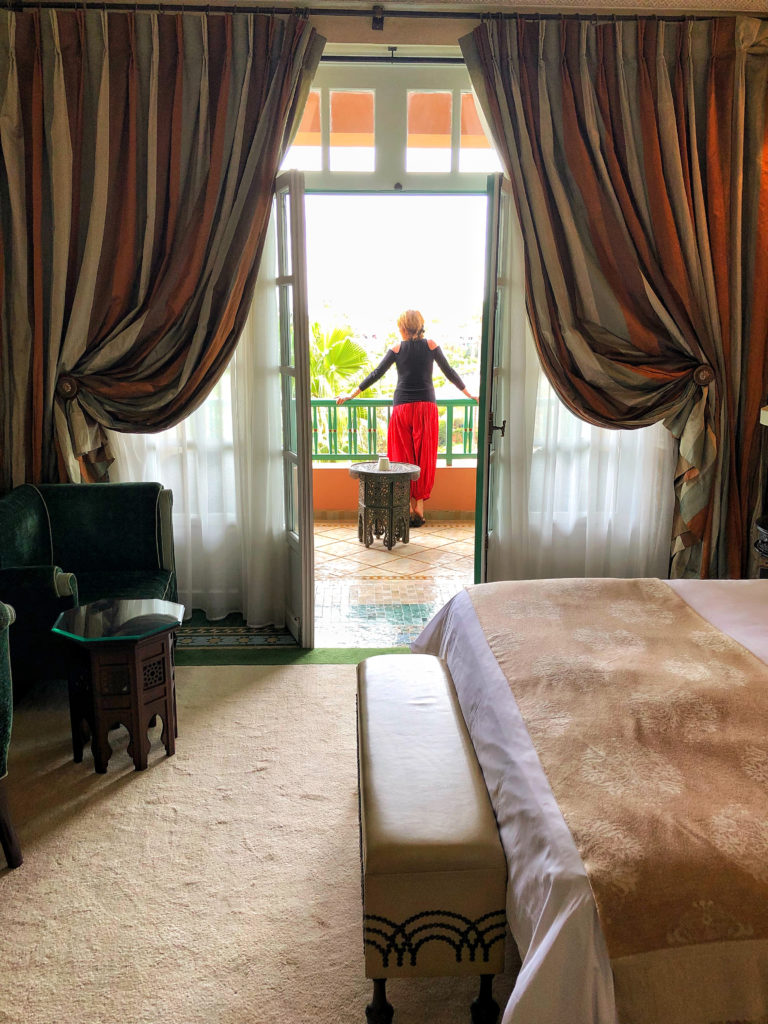
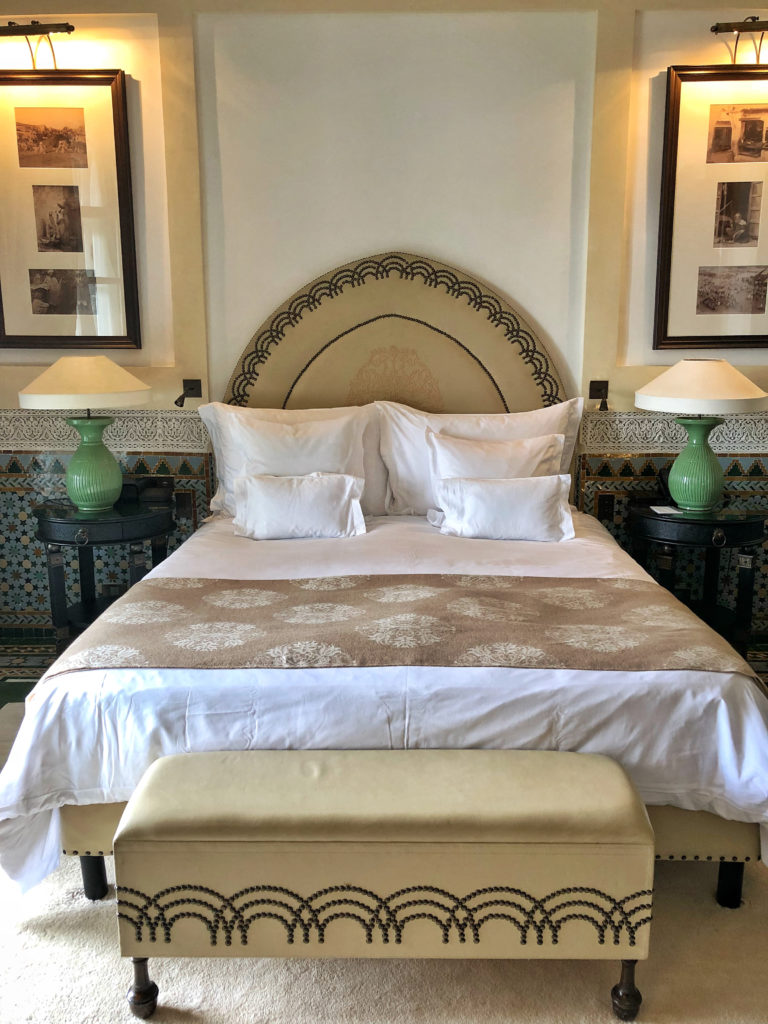

Taking an afternoon away from the fray, we visited the Rue de Marjorelle, a picturesque street that runs along the La Marjorelle gardens, which were gifted to the city by Yves St. Laurent. His former electric blue home on the property is open for tours; and don’t miss the on-site chic gift shop and the trendy lifestyle store across the street, 33 Rue de Marjorelle.
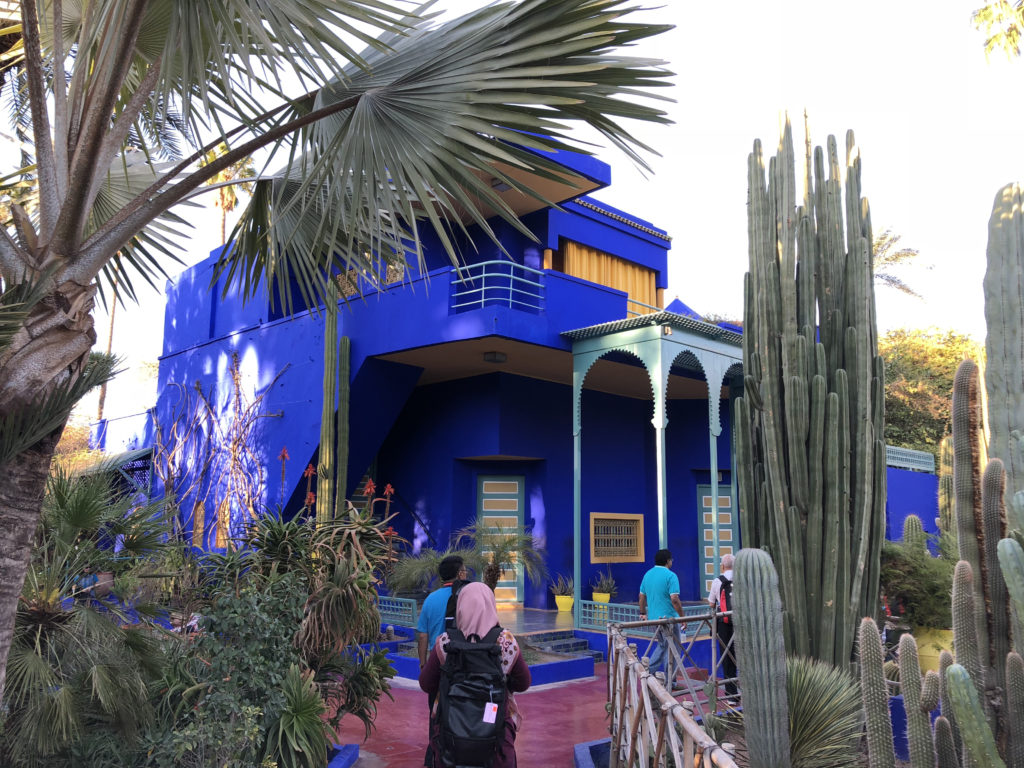
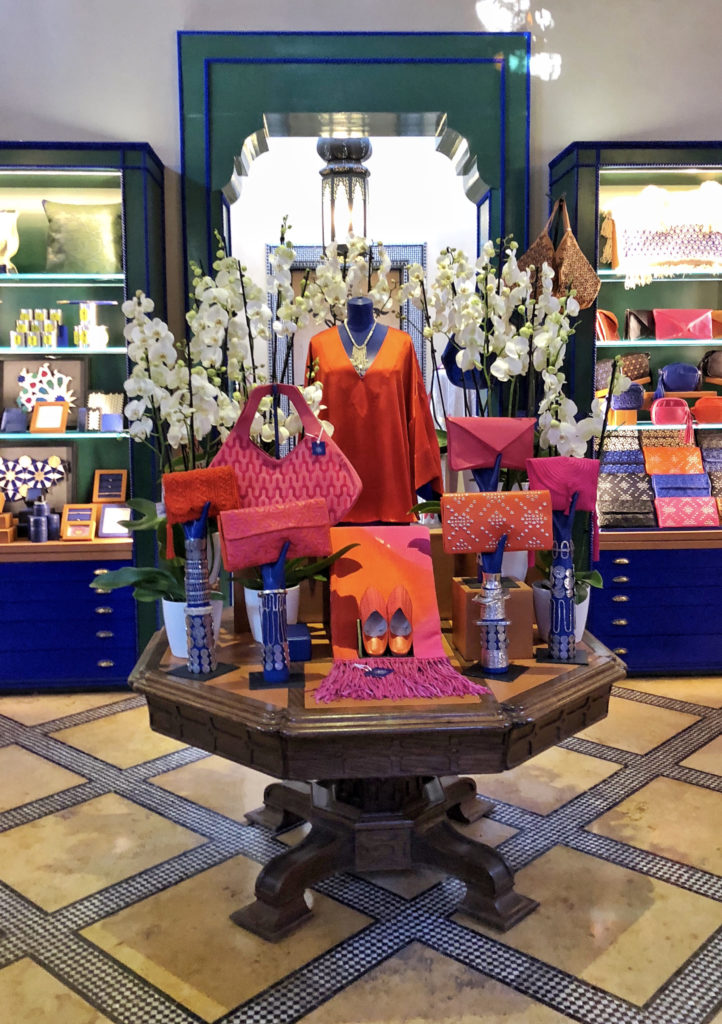

Refueled and energized, I was back in the souks, and though still often lost in the maze of alleyways, I learned that somehow I always ended up at an exit and a taxi stand. I gradually honed my bartering skills, learned how to knot a Beni Ourhain carpet, drank buckets of mint tea during negotiations, and found a wonderful treasure trove of rugs, embroidered pillows, slippers, and woven blankets to bring home.
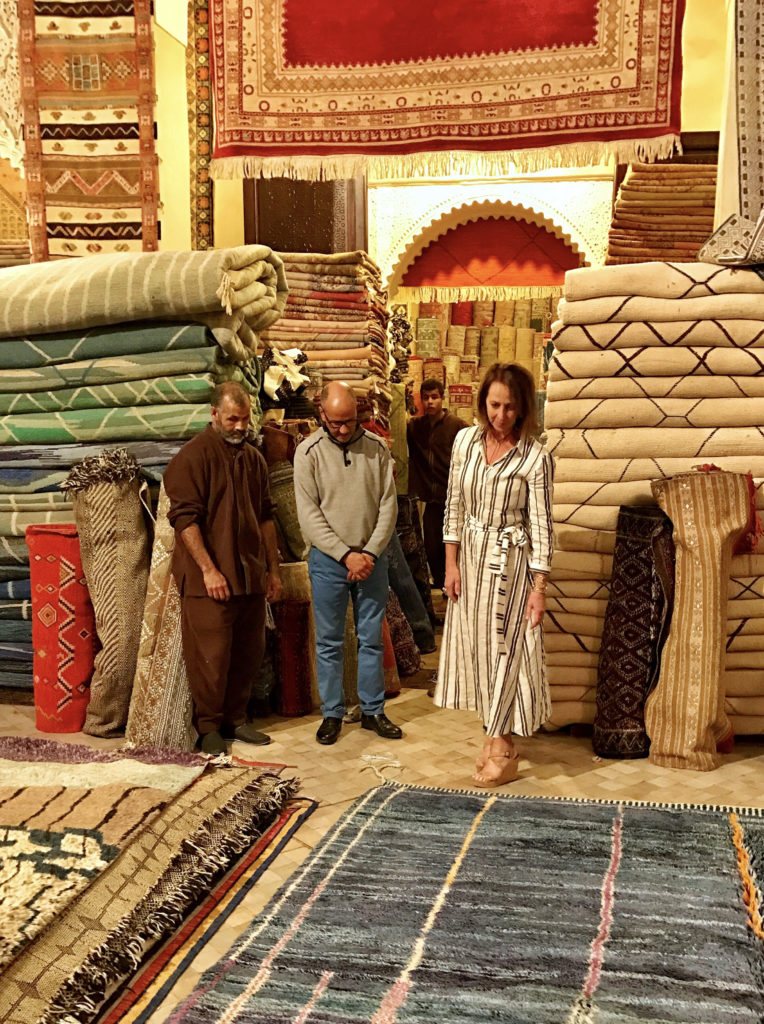
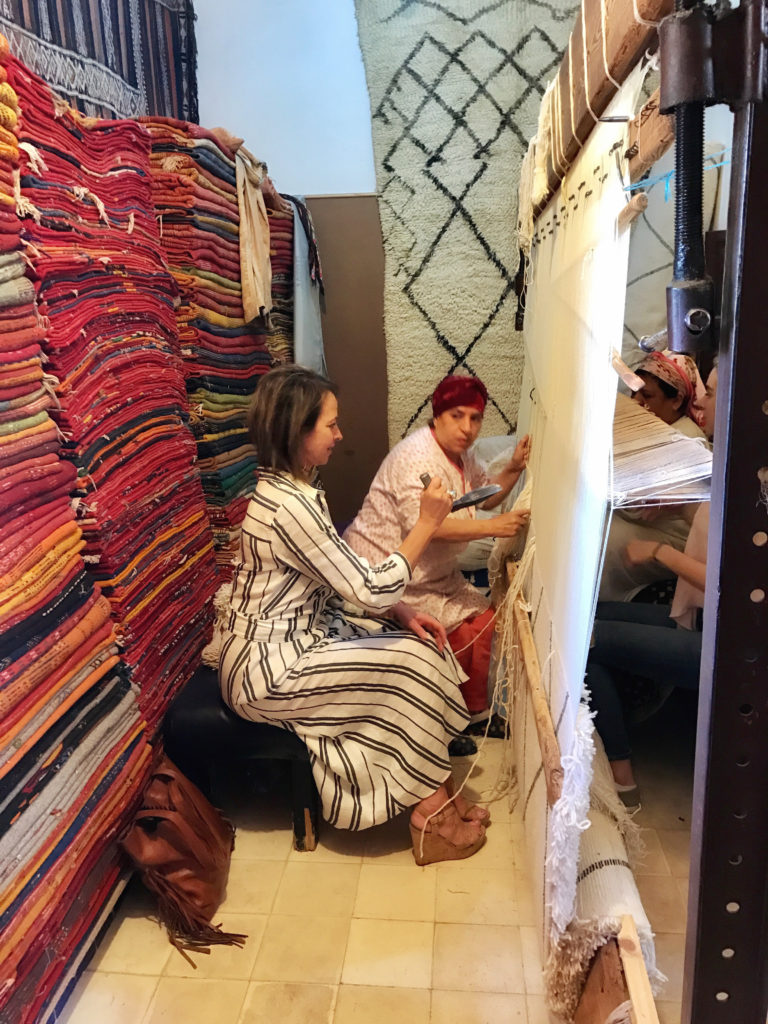


With every kind of tagine in my new staples list, mint tea a new part of my daily ritual, and DHL dispatched to pick up my treasures, I said goodbye to La Mamounia and 2 of the best dressed guys in Marrakech —- be back very soon.
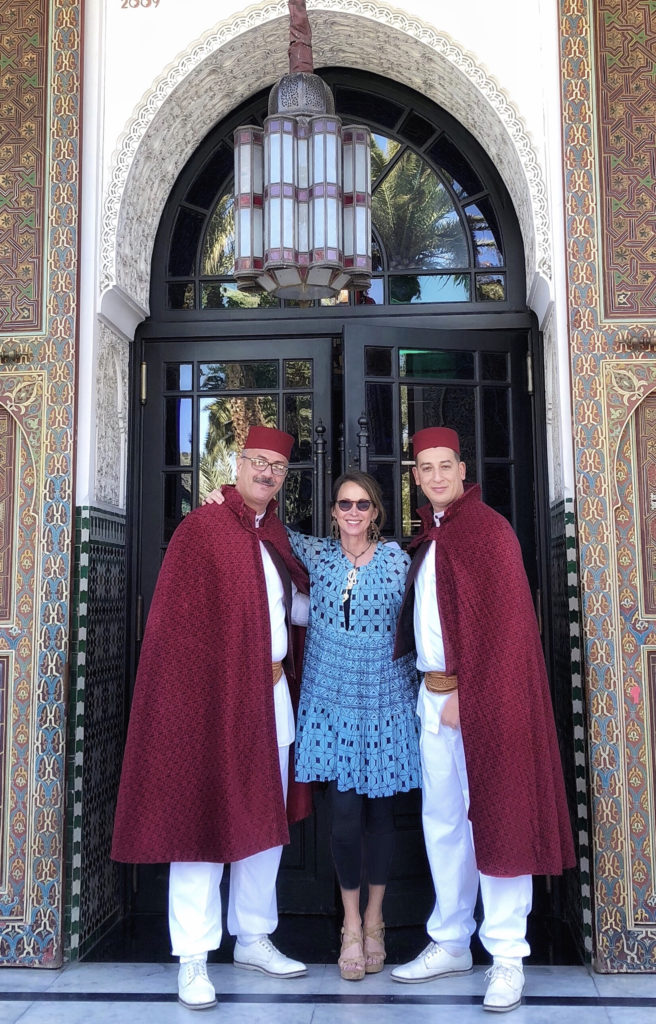
Inspired by House Beautiful’s Before & After issue this February, I revisited some of our projects and a few favorite beginnings and endings are below.
Beachside Restaurant
At Rooster’s Southern Kitchen in Kill Devil Hills, North Carolina, we unified the existing interior wall treatments by painting all walls and ceilings a warm, creamy white. Floors were stripped to their original concrete, then stained, polished and buffed to a rich pumpkin-colored sheen. Existing support columns were painted but kept exposed and industrial in feeling. A dropped ceiling was installed over the bar area to define the space and provide a place to install needed materials for noise absorption. Exaggerated height in the striped banquettes created a mini-wall for dining but didn’t visually close off the bar area. Taking advantage of the ceiling heights, we repeated several carved wooden chandeliers (dropped to an intimate, more residential height) to warm the room with soft light.
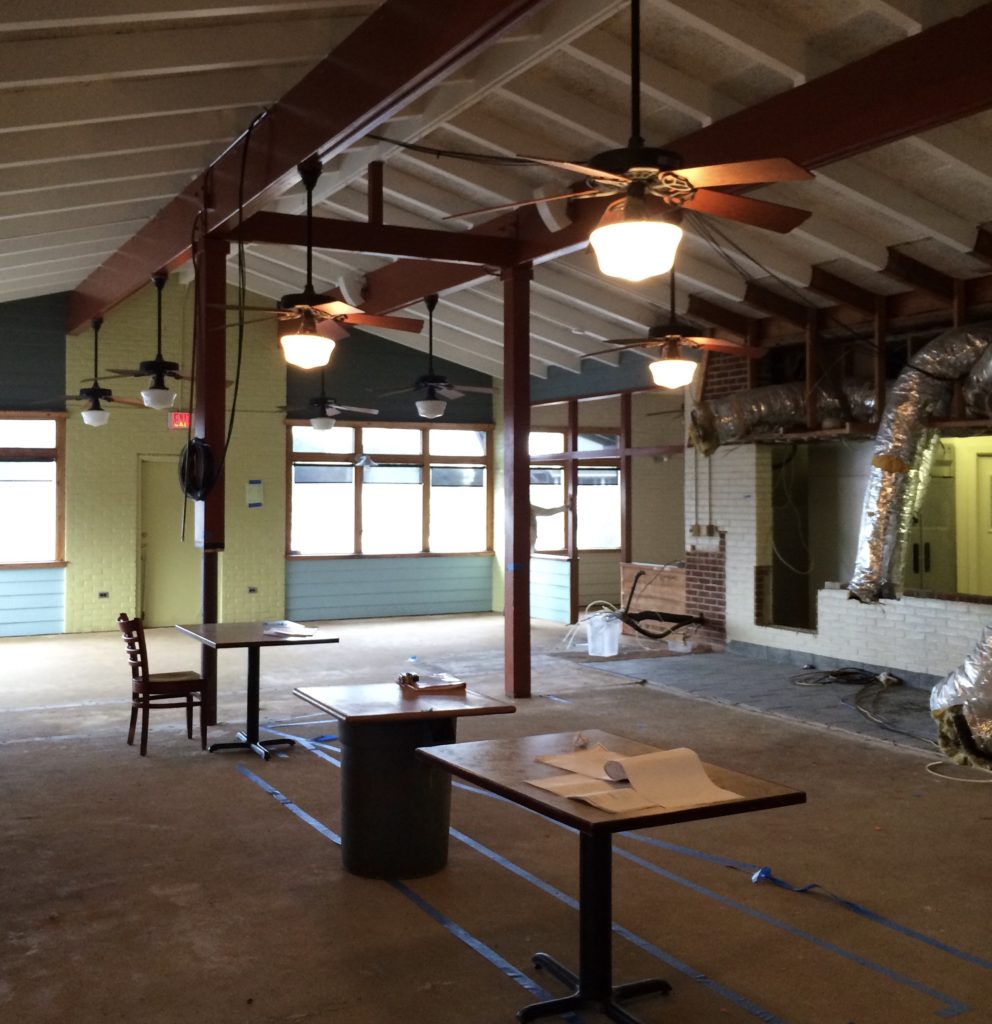

Photo: Gordon Gregory Photography
Seaside Villa
In a nearby oceanside town, our clients purchased a spacious home backing up to a lovely pool and golf course. With extensive square footage to furnish, they agreed to purchase some of the existing furnishings from the original owners. After living for a while in the house and refining their goals and vision for their home, we helped define a new scheme.
We tackled this generous living space first. We added warm “greige” paint to the walls and then dramatized the ceiling height by installing floor to ceiling curtains. Custom hand-forged chandeliers also help draw the eye upward. The furnishings were lightened up in color and scale, as was the streamlined color story with yellow as our sole accent color.
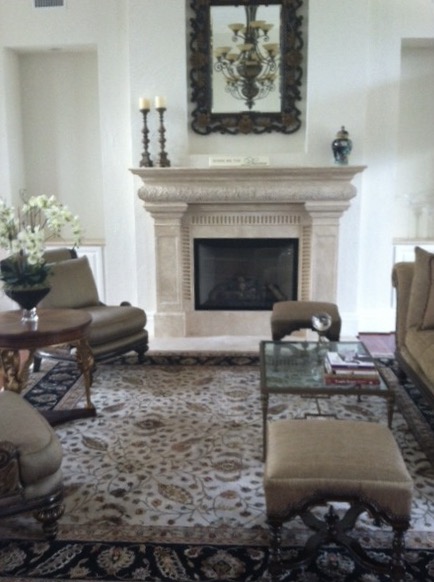
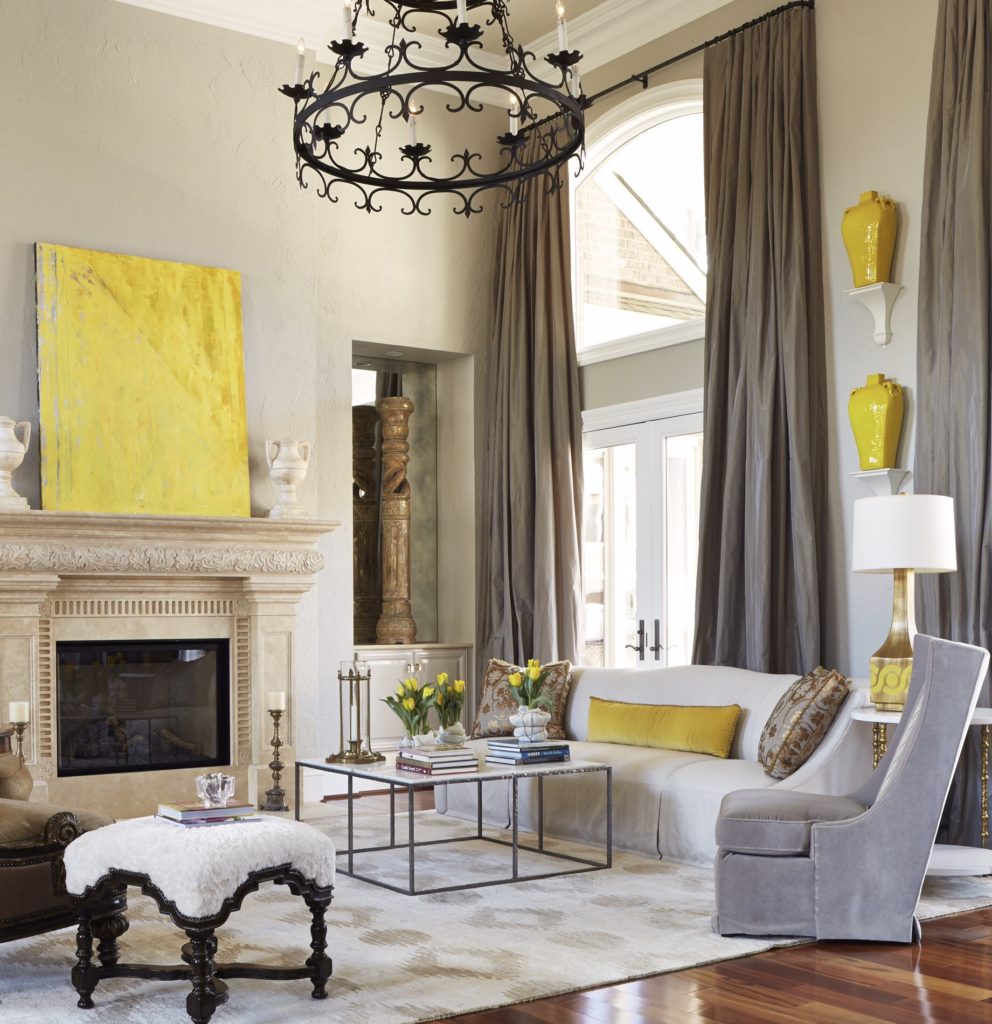
photo: Kip Dawkins Photography
Game Day Condo
In my own small condo in Chapel Hill, North Carolina, it may have been all the white paint everywhere at purchase that led me to crave a little color-saturated jewel box. A deep, muddy teal paint covers all the walls and metallic gold patterned wallpaper covers the ceiling. Sheer curtains in a similar gold wrap the curtain-wall glass on the adjacent walls. Upholstery blends in with the walls tonally and accent patterns are kept to a minimum. First purchase: the photograph above the sofa in a respectful nod to the local UNC mascot ‘Ramses.’
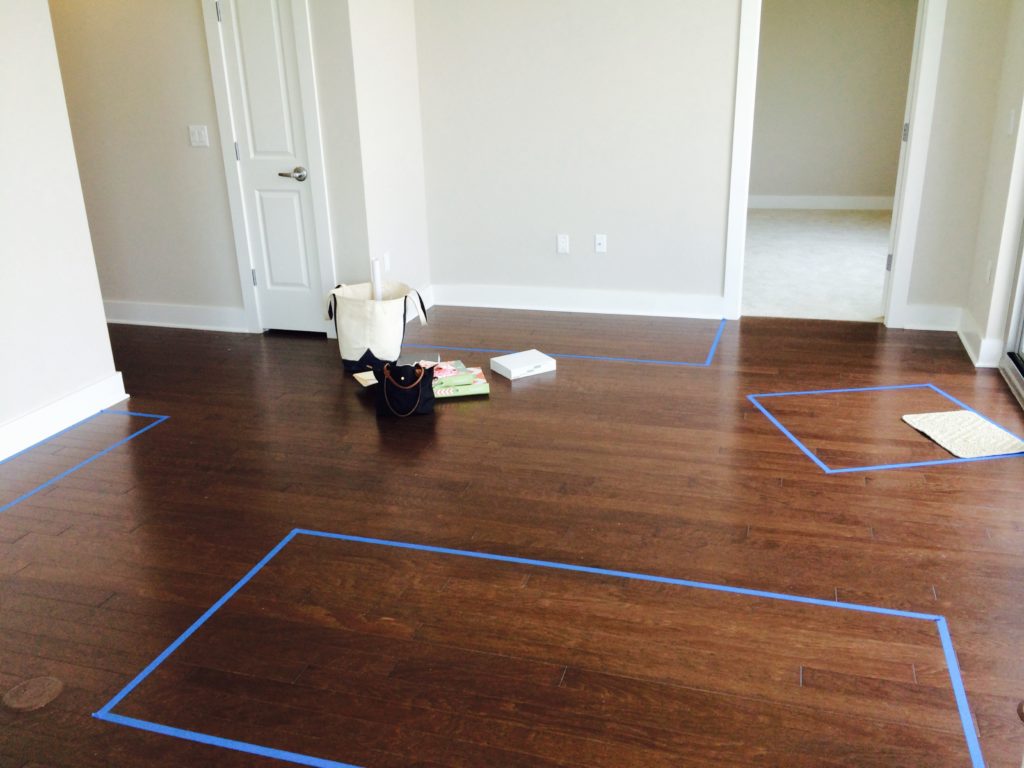
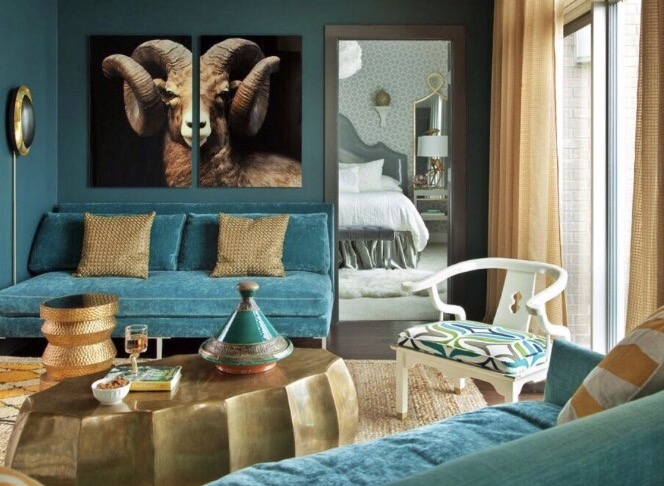
photo: Gordon Gregory Photography
Winter Retreat
We started with a blank slate in this Florida vacation home working with a client who is colorful and elegant, warm and welcoming, refined and yet full of surprises. I think all of her personal qualities translate to this lovely room that she guided us to create. You’ll find no cliche Florida motifs in this house – no wicker, palm fronds, or coral accessories here. But the color palette feels southern and warm, and the view through the doors at the turquoise pool and lush landscaping is quintessentially Florida.

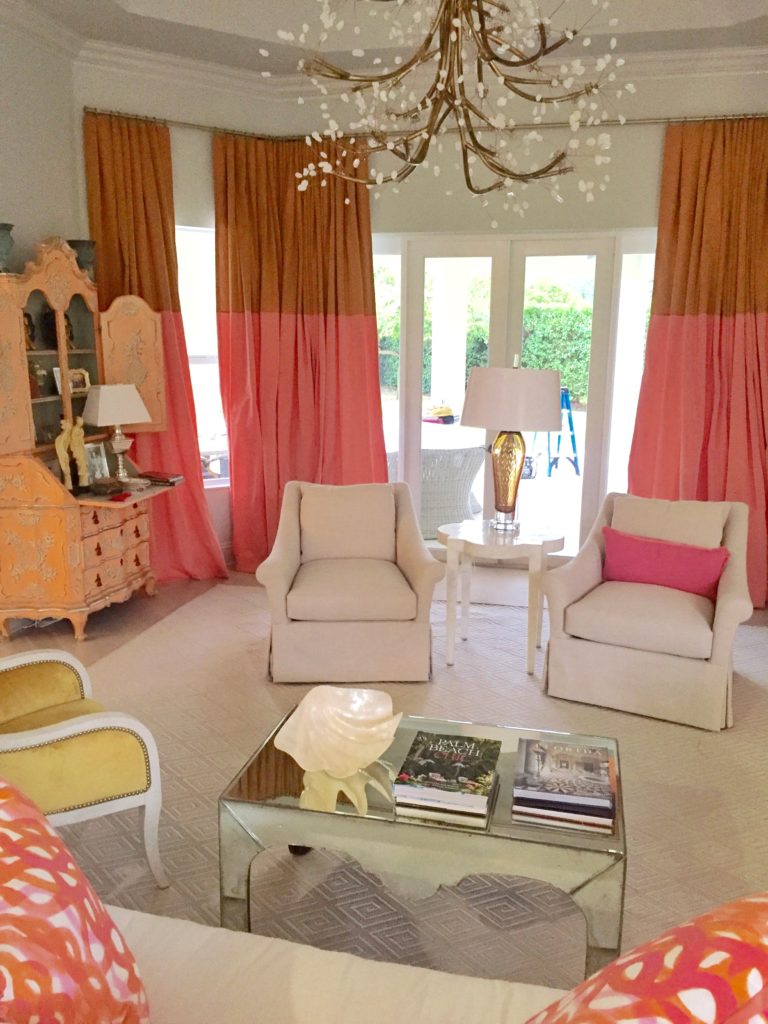
Monument Avenue Update
The two photos below graphically translate what we mean by ‘fine tuning.’ Our clients are blessed with one of those great front-to-back views from the entry and a wide foyer with abundant natural light. They wanted to use the hallway as more than just a thoroughfare. After locating the antique Biedermeier secretary on 1st Dibs and delivering the pair of custom chairs, we added visual layers with pillows, art, lighting, and a rug (and a Fiddlehead Fig).
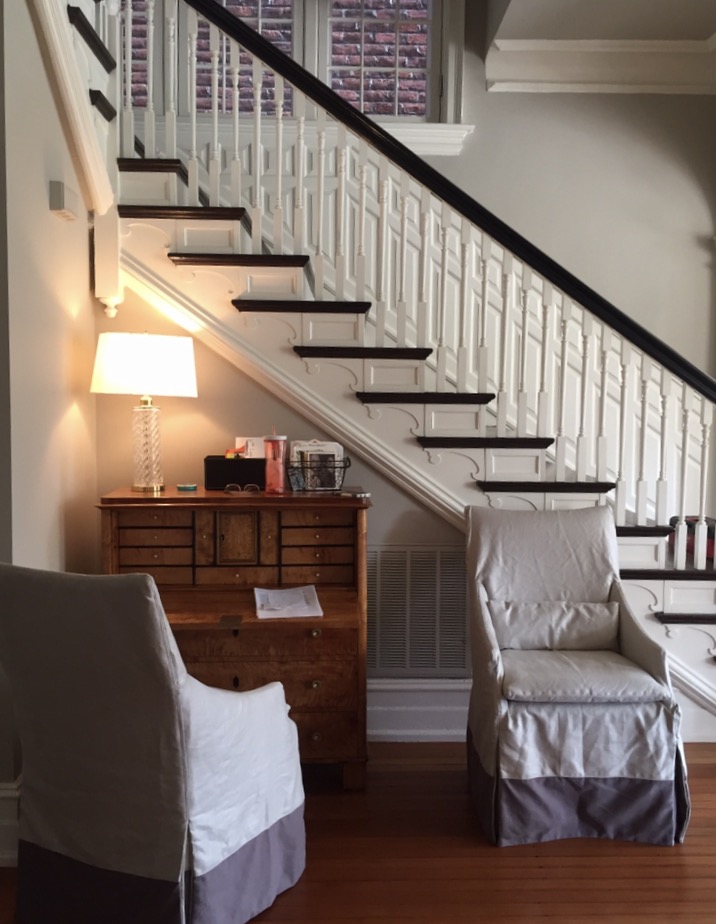

Photo: Gordon Gregory Photography
Virginia Tasting Room
We extensively renovated Early Mountain Winery and were thrilled when our design won #1 Tasting Room in the country in the August 2016 USA Today competition. This is a shot toward the new curvilinear Tasting Bar in a warm wood with a polished concrete slab counter. A sinuous wood track mirrors the bar shape and serves as the anchor for jute-wrapped pendants above. Exposed brick vertical pilasters were painted to meld with the walls, and richly-colored grasscloth accents the back of the bar area. Soft seating areas (think colors of Virginia in Autumn) were added throughout to encourage guests to settle in and linger.
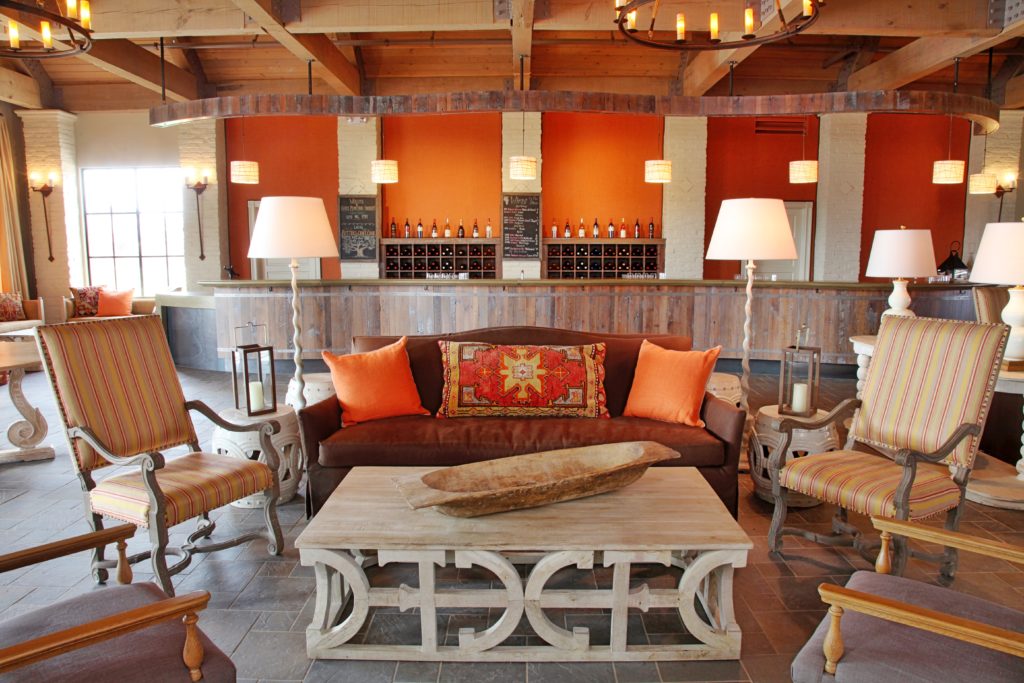
Photo: Guy Crittenden
The twin bedroom gets a bad rap. Often scorned and deemed a “B” room assignment by some, I am here to put in a good word for the twin room. My husband and I have 5 children and large extended families on both sides. Luckily, our children seem to have a lot of friends who come to visit. Sleeping large crowds can be challenging and my daughter, from age 5, has been a master at sketching a room assignment chart for big holidays or vacation visits. This is when twin rooms show their merit. Two sons arriving with girlfriends who have never met?? They are happy to twin-it but would rather not share a bed with a stranger. All-male golf or fishing outing? Same thing–a twin will suit but no shared beds for the guys. And we can’t forget all the times the the other twin bed has happily housed your child’s sleepover guest.
After some research I have identified several reasons why twins are deemed less comfortable. When purchasing mattresses, most shoppers are comfortable splurging on a bedroom mattress if it’s a king or queen but they are inclined to shop a lower price point for a twin. Consider upgrading to a high quality twin and always purchase a twin that’s extra long in length. Two twins don’t make a king but two XL twins are the same size as a standard king. This extra length makes all the difference, especially for anyone over 5’10”. The same goes for sheets and bedding. Outfit your twins with same 1000-point thread count as your Master.
Using king-sized pillows at the head of a twin fills the head of a bed nicely for a luxe look.
With fabric panels in lieu of proper beds or headboards, the panels can be adjusted and the beds can be pushed together and dressed as a king bed in a pinch.
Visual symmetry is inherently pleasing to the eye and if you put two well dressed twins on a wall together with a table and and a lamp or a sconce between them it’s going to look great. Promise.
